

Bucharest Travel Guide: A Comprehensive Overview of Romania’s Capital City
Bucharest, the capital city of Romania, is one of the most exciting and dynamic cities in Eastern Europe. With a rich cultural heritage, a diverse food scene, and a vibrant nightlife, Bucharest is a must-visit destination for any traveler. In this travel guide, we will cover everything you need to know to plan your trip to Bucharest, including the best places to visit, eat, and stay.
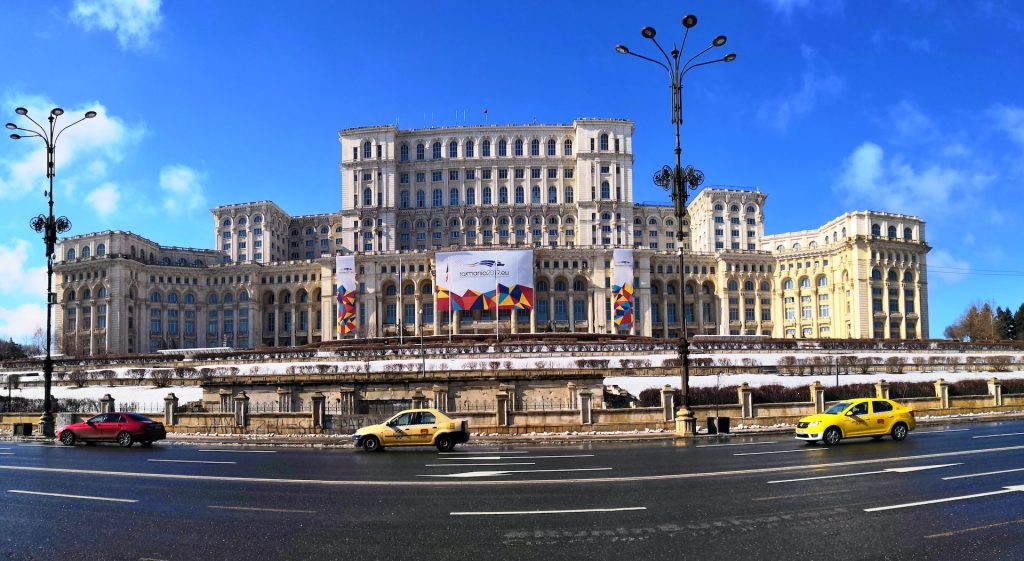
Bucharest is a city of contrasts, where old and new, East and West, blend together in a unique way. The city has a rich history that dates back to the 15th century, and it has been influenced by various cultures throughout the years. Bucharest is also known as “The Little Paris of the East” due to its stunning architecture, elegant boulevards, and vibrant cultural scene.
Understanding Bucharest: The Capital of Romania
As the bustling capital of Romania, Bucharest is more than just a travel destination; it’s the political, cultural, and economic heart of the country. If you’re curious about how Bucharest earned its status as the capital and what makes it such a significant city, we have an article that delves into the intricate details. From its historical significance to its role in modern Romania, get a comprehensive understanding of Bucharest as the capital .
When to Visit Bucharest
The best time to visit Bucharest is between May and September, when the weather is warm and sunny, and most of the festivals take place. However, the city is beautiful year-round, and there is always something to see and do. In the winter, the Christmas markets and the snow-covered streets create a magical atmosphere. For more detailed information on the best seasons, weather conditions, and local events, check out our guide on the optimal times for visiting Romania’s capital city .
How to Get to Bucharest
Bucharest has two airports, Henri Coanda International Airport (OTP) and Aurel Vlaicu International Airport (BBU). Most international flights arrive at Henri Coanda International Airport, which is located 18 km north of the city center. There are direct flights to Bucharest from major cities in Europe and North America. For an exhaustive guide on navigating airport transfers, public transport, and other ways to get into the city center, consult our in-depth article here .
Getting Around Bucharest
Bucharest has a solid public transportation system, including buses, trams, trolleybuses, and the metro. The metro is quick and easy for getting around. Taxis are also common but make sure you pick a well-known company (the most popular between Romanians are Yango, Clever or BlackCab) or use a ride-sharing app like Bolt or Uber. Want to know more? Check out our full article on how to get around in Bucharest .
Top Things to Do in Bucharest
1. visit the palace of the parliament.
The Palace of the Parliament is one of the most impressive buildings in Bucharest and the second-largest administrative building in the world after the Pentagon. The palace was built during the communist era and has more than 1,000 rooms, 4 underground levels, and a height of 84 meters. Visitors can take a guided tour of the palace and admire the grandiose halls, chandeliers, and artwork. Delve into the stories behind the world’s heaviest building.
2. Explore Old Town (Lipscani)
Old Town, also known as Lipscani, is the historic center of Bucharest, and it’s a maze of narrow streets, colorful buildings, and lively bars and restaurants. This is the perfect place to go for a stroll, people-watch, and soak up the atmosphere. For those interested in diving deeper into the hidden gems and popular spots of this area, check out our detailed list of things to do in Old Town .
3. Admire the Architecture of Bucharest
Bucharest is famous for its unique blend of architectural styles, including Neoclassical, Art Nouveau, and Socialist Realism. Some of the most beautiful buildings in the city are the Romanian Athenaeum, the CEC Palace, and the Stavropoleos Monastery. Explore our detailed list of architectural wonders in Bucharest .
4. Wander Through the Botanical Garden
The Botanical Garden is a peaceful oasis in the middle of Bucharest, with over 10,000 species of plants, a lake, and several greenhouses. It’s a perfect place to escape the hustle and bustle of the city and enjoy some nature. For more tips and details, check out our complete rundown on the Bucharest Botanical Garden .
5. Discover the Village Museum
The Village Museum, also known as the Dimitrie Gusti Museum, is an open-air museum that showcases traditional Romanian village life. Visitors can walk through the village streets, see authentic houses, and learn about the history and customs of the Romanian people. For those who want to delve deeper into the cultural nuances and historical context of this living museum, don’t miss our specialized guide on the Dimitrie Gusti Museum .
6. Take a Stroll in Herastrau Park
Herastrau Park is the largest park in Bucharest, with over 180 hectares of green space, a lake, and several outdoor activities such as boat rentals, cycling, and picnicking. It’s a perfect place for a relaxing day out in nature.
7. Check Out the National Museum of Art of Romania
The National Museum of Art of Romania is home to one of the most impressive collections of Romanian art, from medieval times to the present day. The museum is housed in the former Royal Palace, which is also worth a visit for its stunning architecture.
8. Visit the Romanian Athenaeum
The Romanian Athenaeum is an iconic building in Bucharest, known for its beautiful concert hall and the impressive dome that dominates the city skyline. The Athenaeum hosts regular classical music concerts and is a must-visit for music lovers.
9. Spend a Day at Therme Bucharest
Therme Bucharest is the largest thermal spa complex in Europe, with indoor and outdoor pools, saunas, steam rooms, and a wide range of wellness treatments. It’s the perfect place to relax and unwind after a busy day of sightseeing.
After a full day of sightseeing, Therme Bucharest offers a perfect escape. It’s the largest thermal spa complex in Europe, featuring a myriad of pools, saunas, and wellness treatments. Whether you’re looking to relax or indulge in a spa day, this place has a range of options to suit every mood. For more details on what to expect, read our feature on this top-rated wellness center .
10. Uncover Bucharest’s Thrilling Escape Rooms
If you’re looking for a different kind of adventure in Bucharest, consider diving into the city’s escape room scene. These interactive experiences offer a unique blend of storytelling, puzzle-solving, and teamwork that’s sure to make for a memorable outing. Whether you’re a fan of horror themes, historical settings, or mind-bending mysteries, there’s an escape room in Bucharest to match your interests. For a curated list of the best escape rooms in the city, along with tips and reviews, explore our guide that dives into the thrills of Bucharest’s escape room adventures .
11. Delve into the Mystique of Macca-Vilacrosse Passage
Tucked away in the heart of Bucharest, the Macca-Vilacrosse Passage is a hidden gem that offers a slice of the city’s historical charm. This glass-covered arcade is lined with cozy cafes, unique boutiques, and offers an atmosphere that transports you back in time. Whether you’re looking for a quiet place to enjoy a coffee or you’re interested in capturing some stunning photographs, the passage is well worth a visit. For a detailed exploration of its history and allure, check out our feature on this iconic Bucharest landmark .
12. Experience Open Streets Bucharest
Open Streets Bucharest is an initiative that transforms certain streets into pedestrian-friendly zones, promoting sustainable living and community engagement. The event occurs periodically and offers a range of activities from cycling and walking to art installations and live performances. It’s a unique way to experience the city’s culture and public spaces, as you see Bucharest from a different perspective—literally on the ground. For those interested in urban planning, sustainability, or just having a good time outdoors, this is an event you won’t want to miss. For a complete guide to participating in or experiencing this initiative, check out our comprehensive article on Open Streets Bucharest .
13. Explore the Carturesti Carusel Bookstore
Another must-visit spot in Bucharest is the Carturesti Carusel Bookstore, a six-level architectural gem filled with thousands of books, an art gallery, and a bistro. This bookstore is not just a place to pick up a new read; it’s a cultural experience in itself, capturing the artistic spirit of the city. For a deeper dive into what makes this bookstore a unique destination, explore our detailed guide on the Carturesti Carusel Bookstore .
14. Marvel at Downtown Bucharest Fountains
Bucharest’s downtown area comes alive with stunning fountains, especially in the evening. These aren’t just any fountains; they’re a light and water show that turns the city center into a magical place. It’s a must-see spectacle that adds a special touch to Bucharest’s lively atmosphere.
15. Be Captivated by the Romanian Athenaeum
The Romanian Athenaeum is more than just a beautiful building; it’s a hub for classical music and cultural events. The majestic dome and elegant columns are just the beginning. Step inside to experience a world of artistic excellence that captures the very essence of Bucharest’s love for the arts.
16. Journey Through the National Museum of Art of Romania
This museum is a treasure trove of Romanian and European art. Located in the former Royal Palace, it gives you a peek into the country’s rich artistic heritage. From ancient to modern art, this museum has something for everyone and offers an enriching experience.
17. Step Back in Time at Ceaușescu House
The Ceaușescu House allows you to delve into the life of Romania’s controversial former leader. The well-preserved interiors offer a glimpse into the lavish lifestyle led by Nicolae Ceaușescu. It’s a piece of living history that offers both intrigue and understanding of Romania’s past.
18. Experience the Everyday at the National Museum of the Romanian Peasant
Discover the traditions and daily lives of Romanian peasants. This museum offers a down-to-earth look at Romania’s rural culture through exhibits of clothing, tools, and even entire houses. It’s a fascinating journey into the heart of Romania’s roots.
19. Uncover the Past at the National Museum of History of Romania
This museum is your go-to place for everything related to Romania’s history. From ancient artifacts to modern-day memorabilia, it’s a one-stop-shop to understand the shaping of a nation. Don’t miss the replica of Trajan’s Column, which tells a story all on its own.
20. Dive into Science at the Grigore Antipa National Museum
If you’re a fan of natural history, this museum is for you. From dinosaur fossils to exhibits on human evolution, it’s a place where science comes alive. It’s an educational adventure that both kids and adults will love.
21. Discover Bucharest’s Story at the Museum of the Municipality of Bucharest
Learn about Bucharest from its earliest days to the modern era. This city museum offers a chronological look into how Bucharest became the bustling capital it is today, making it essential for anyone interested in the city’s backstory.
22. Laugh at the Romanian Kitsch Museum
This unique museum celebrates the quirky and amusing side of Romanian culture. From Dracula souvenirs to communist-era memorabilia, it’s a light-hearted way to explore the country’s less traditional heritage.
23. Be Mesmerized by iMapp Bucharest
iMapp Bucharest is one of the world’s largest video-mapping events and turns the city into a canvas of light and sound. Usually held in September, it’s a visual feast that shouldn’t be missed by anyone visiting during this time.
24. Immerse in Culture at Asia Fest Bucharest
Love Asian culture? Asia Fest Bucharest is a colorful and vibrant festival that celebrates the food, music, and traditions from the Far East. It’s a unique way to experience a different culture while staying in Bucharest.
25. Enjoy the Outdoors at Parcul Alexandru Ioan Cuza (Titan Park)
Also known as Titan Park, this green space offers locals and tourists a place to relax, jog, or even paddle-boat on the lake. It’s a little piece of nature in the urban jungle, making it a great spot for a leisurely day out.
26. Discover Luxury in Primăverii District
Primăverii is known for its luxury homes and high-end living. Take a stroll through this district to see some of Bucharest’s most beautiful residences and maybe even spot a celebrity or two. It’s a different side of Bucharest that’s worth exploring.
27. Witness the Grandeur of Arcul de Triumf
Inspired by Paris’s Arc de Triomphe, Bucharest’s own Arcul de Triumf is a symbol of Romanian national pride. It’s particularly impressive on December 1st, Romania’s National Day, when it becomes the focal point of military parades.
28. Relax at Cișmigiu Gardens
Cișmigiu Gardens offer a peaceful escape in the heart of the city. With its beautiful landscaping, small lake, and charming footbridges, it’s a popular spot for both locals and tourists looking to unwind.
29. Reflect at Revolution Square
This square is more than just a meeting place; it’s a symbol of Romania’s fight for freedom. With its monuments and buildings that tell a story of revolution, it’s a place of historical significance that invites contemplation.
30. Find Solace in Snagov Monastery
Situated on an island in the northern part of Bucharest, Snagov Monastery is a serene place of worship that’s said to be the final resting place of Vlad the Impaler, the inspiration for Dracula. It’s a quiet escape with a dash of mystery.
31. Explore the Urban Wilderness of Văcărești Nature Park
Dubbed Bucharest’s “Delta,” this nature park is a haven for wildlife and a great spot for birdwatching. It’s a slice of wilderness right in the city, offering a unique natural escape for those looking to get away from the hustle and bustle.
32. Savor the Flavors at Food Hood Bucuresti
Food Hood Bucuresti is a food lover’s paradise. It’s a food market where you can try all kinds of delicious treats . Whether you’re craving traditional Romanian dishes or international cuisine, you’ll find it here. It’s the perfect place to eat, socialize, and experience the culinary scene in Bucharest.
33. Uncover History at Sighet Memorial Exhibition
The Sighet Memorial Exhibition is not just a museum; it’s a lesson in Romania’s past. It stands as a haunting reminder of the political prisoners once held here. This place is a must-see for anyone interested in understanding Romania’s history and human rights journey.
34. Explore Piaţa Obor Market
Piata Obor is more than just a market; it’s a vibrant slice of local life. With fresh produce, handmade goods, and tasty street food, it offers a bit of everything. A trip here is a sensory feast and a window into how locals shop and eat.
35. Step Back in Time at Curtea Veche Museum
Curtea Veche Museum is where Bucharest’s history comes alive. It’s a fascinating place that tells the story of the city’s royal past. From ancient artifacts to historical documents, this museum offers a glimpse into the bygone eras of Bucharest.
36. Visit the Peaceful Bellu Cemetery
Bellu Cemetery is an unexpected but serene tourist spot. It’s not just a place of rest; it’s also a gallery of intricate tombstone art and sculptures. The calmness and the artistic atmosphere make it a unique experience.
37. Wander Through Pasajul Englez
Pasajul Englez is a hidden treasure in Bucharest. This quaint passage is filled with art galleries and cozy cafes. It’s a lovely spot to take a break from the city buzz, enjoy a coffee, and maybe find your new favorite painting or sculpture.
38. Catch a Sunset at Pura Vida Hostel
The Pura Vida Hostel offers more than just a place to sleep; its rooftop provides a stunning view of the city, especially at sunset. It’s a wonderful spot to unwind, sip a cocktail, and soak in the beauty of Bucharest as the sun goes down.
39. Experience Targul Vitan Market
Targul Vitan is a bustling flea market where you can find a variety of goods, from antiques to fresh food. It’s a great place to hunt for souvenirs and experience the energetic vibe of a local Romanian market.
40. Discover Memories Bazaar
Memories Bazaar is a one-of-a-kind shopping experience in Bucharest. With its eclectic mix of vintage items, handmade crafts, and unique trinkets, you’re sure to find something special to take home with you.
41. Admire Street Art in Strada Arthur Verona and Chimopar
The streets of Arthur Verona and Chimopar are open-air galleries showcasing Bucharest’s vibrant street art scene. Take a leisurely stroll and admire the murals, graffiti, and installations that add a pop of color and creativity to the city.
42. Take Flight at the Aviation Museum
The Aviation Museum is a haven for aviation enthusiasts. With a collection of aircraft, models, and memorabilia, it offers a comprehensive look at Romania’s aviation history.
43. Explore Royal Elegance at Cotroceni Palace Museum
Cotroceni Palace Museum is the epitome of royal grandeur. With its beautifully decorated rooms and historical exhibits, it provides a glimpse into the lives of Romania’s past rulers.
44. Learn at the Firefighters Museum
The Firefighters Museum is an enlightening experience for all ages. It offers an in-depth look at the history of firefighting in Romania, complete with antique equipment and educational exhibits.
45. Visit the Historic Curtea Veche Church
Curtea Veche Church is a place of peace and spirituality. This historic church is one of Bucharest’s oldest and offers a quiet sanctuary amid the hustle and bustle of the city.
46. Marvel at the Patriarchal Cathedral
The Patriarchal Cathedral is not just a place of worship; it’s a symbol of Romanian Orthodoxy. Its majestic architecture and spiritual ambiance make it a must-visit spot for both pilgrims and tourists alike.
47. Discover Bucharest After Dark
If you’re interested in experiencing Bucharest in a different light, don’t miss our detailed the best things to do in Bucharest at night . This isn’t your typical nightlife rundown; it’s a comprehensive look at unique activities, cultural landmarks, and serene spots you can enjoy after the sun sets. From haunted city exploration games to mesmerizing fountain shows, this guide offers a diverse range of nighttime activities that go beyond bars and clubs.
Where to Eat in Bucharest
Bucharest has a thriving food scene, with a mix of traditional Romanian cuisine and international options. Here are some of the best places to eat in the city:
1. Caru’ cu Bere
Type: Traditional Romanian Highlight: Historic setting with live music
Type: International Highlight: Fresh, seasonal ingredients
3. Energiea
Type: Bar and Small Plates Highlight: Lively atmosphere with a mix of cuisines
For a more detailed guide to the best dining spots, including our reviews and insider tips, check out our comprehensive list of top picks to eat in Bucharest .
Where to Stay in Bucharest
Bucharest has a wide range of accommodations, from budget hostels to luxury hotels. Here are some of the best places to stay in the city:
1. Grand Hotel Continental
The Grand Hotel Continental is a luxurious 5-star hotel located in the heart of Bucharest. The hotel features beautifully decorated rooms and suites, a spa, a fitness center, and several restaurants.
2. Mercure Bucharest City Center
The Mercure Bucharest City Center is a modern hotel located in the city center, just a few steps away from the Old Town. The hotel features comfortable rooms, a restaurant, and a fitness center.
3. Hotel Christina
Hotel Christina is a stylish boutique hotel located in a quiet area of the city, just a short walk from the city center. The hotel features spacious and modern rooms, a rooftop terrace, and a restaurant.
What Are Some Must-See Attractions in Bucharest?
When visiting the capital city of romania , Bucharest, be sure to explore its must-see attractions. Take a stroll in Herastrau Park, visit the grand Palace of the Parliament, admire the beautiful architecture of the Romanian Athenaeum, and immerse yourself in the vibrant atmosphere of the Old Town. Experience the rich history and charm of this captivating city.
Experience the Vibrancy of Bucharest’s Nightlife
Bucharest comes alive after dark, offering a nightlife experience that’s as diverse as it is vibrant. From swanky rooftop bars with panoramic city views to underground clubs pulsating with electronic beats, the Romanian capital promises an unforgettable night out. Local haunts serve up traditional drinks and live music, while international venues offer a taste of global party culture. Whether you’re looking to dance until dawn or enjoy a laid-back evening, Bucharest has something for every nocturnal adventurer. For an insider’s look into the city’s after-hours scene, explore our guide packed with local secrets on how to make the most of Bucharest’s nightlife .
Bucharest is a city with a rich history and culture, and there are many things to see and do. From exploring the historic Old Town to visiting the Palace of the Parliament, there is something for everyone in this vibrant city. Whether you’re interested in art, architecture, or food, Bucharest has it all. Interestingly, the city is also becoming a hotspot for digital nomads , who find its mix of history, modern amenities, and connectivity appealing. So why not book your trip today and discover this fascinating city for yourself?
Practical Travel Tips for Bucharest
Navigating safety concerns in bucharest.
Bucharest is generally considered a safe destination for tourists, but like any major city, it has its own set of safety concerns to be aware of. From petty theft to local customs, it’s essential to be informed and prepared. For a deep dive into what to watch out for, along with the latest travel advisories, check out our in-depth guide on staying safe while exploring Romania’s capital city .
Frequently Asked Questions
Should you visit bucharest in romania.
Definitely! Bucharest, often dubbed the “Paris of the East,” is a must-see city. With its rich past, tasty food, and amazing buildings, you won’t be bored.
How Long Should Your Bucharest Trip Be?
You should plan for at least 3 to 4 days to see the main spots in Bucharest. This gives you time for must-see places like the gigantic Parliament Palace and the peaceful Herastrau Park. If you want to really soak in the local culture, you might want to stay even longer.
Is Bucharest a Safe Place to Go Right Now?
Generally, Bucharest is safe for tourists. But it’s a good idea to keep an eye on travel alerts, especially because of things like health concerns worldwide. For the latest safety tips, check our in-depth guide on how to be safe while enjoying your trip in Bucharest .
How Much Cash Do You Need for a 3-Day Bucharest Visit?
For a comfortable 3-day trip, aim to have around €150-€200. This includes a place to stay, meals, and some sightseeing. Your costs could be different depending on what you like to do.
Is Bucharest Wallet-Friendly or Costly?
Compared to other big European cities, Bucharest is easier on the wallet. You get more bang for your buck, making it a great choice if you don’t want to spend a lot.
What Should You Steer Clear of in Bucharest?
It’s best to watch out for pickpocketing in crowded spots and on public transit. Always use trusted taxis (Yango, Clever or BlackCab) or ride-sharing apps to make sure you’re not overcharged.
Is Bucharest’s Tap Water Okay to Drink?
Yes, you can drink the tap water in Bucharest. But if you have a sensitive stomach, it might be better to stick with bottled water.
Can You Flush Toilet Paper in Bucharest?
Yes, you can flush toilet paper in Bucharest. The city’s plumbing can handle it.
Is Using Uber in Bucharest Safe?
Uber is a safe and convenient way to get around Bucharest. It’s easy because you pay through the app and you know who your driver is ahead of time.
Can You Get Around Bucharest on Foot?
Yes, Bucharest is good for walking, especially in areas like the Old Town. But for longer distances, the city’s public transport is also a good option.
Which Bucharest Area is the Safest?
Safer, fancier areas in Bucharest include Dorobanti, Primaverii, and Herastrau. These neighborhoods are generally secure and well-guarded.
Is Nighttime Walking Safe in Bucharest?
Generally, it’s safe to walk around at night in well-lit, busy parts of Bucharest. But, like in any city, always stay alert.
Is Bucharest Safe for Women Tourists?
Bucharest is generally safe for women traveling alone. Just use common sense like you would in any other city.
Are There Poor Areas in Bucharest?
While Bucharest has areas that are less well-off, these are usually not places tourists go.
Why Do People Call Bucharest ‘Little Paris’?
The nickname “Little Paris” comes from a time when Bucharest was heavily influenced by French culture and architecture. It’s a nod to the city’s elegant style.
Does Bucharest Have a ‘Red Light District’?
Unlike some European cities, Bucharest doesn’t have a specific “Red Light District.” But, adult clubs and bars are found around the city.
Where Do Wealthy People Live in Bucharest?
Well-off folks often live in Dorobanti, Primaverii, and Herastrau. These areas have nice homes and fancy amenities.
Is Bucharest More Affluent Than Budapest?
Budapest generally has a higher income per person. But Bucharest is catching up, thanks to its growing economy.
Do You Need Cash in Bucharest?
While many places in Bucharest accept credit or debit cards, it’s a good idea to have some local currency, known as Romanian Lei, for smaller shops or tipping. ATMs are easily found if you need to withdraw cash.
How Much Does a Meal Cost in Bucharest?
The price for a meal in Bucharest can vary. A budget-friendly meal at a casual place might cost around €5-€10 per person. If you’re going to a nicer restaurant, expect to pay around €20-€30 per person, not including drinks.
Which Is Cheaper, Prague or Bucharest?
Generally, Bucharest is more budget-friendly than Prague. From meals to accommodations, you’ll often find lower prices in Bucharest.
Is Uber Affordable in Bucharest?
Yes, Uber is usually a cheaper option compared to traditional taxis. It’s a cost-effective and convenient way to get around the city.
Is Bolt Available in Bucharest?
Yes, Bolt is another ride-sharing app you can use in Bucharest. It’s also considered a safe and affordable way to travel around the city.
Is the Euro Accepted in Bucharest?
The official currency in Bucharest is the Romanian Lei, not the Euro. While some tourist-focused businesses might accept Euros, it’s best to use Lei to avoid poor exchange rates.
Do Taxis Accept Credit Cards in Bucharest?
Some taxis in Bucharest do accept credit cards, but many prefer cash. It’s a good idea to ask the driver before you start your trip. Ride-sharing apps like Uber and Bolt allow for cashless payments.
- CONTENT FOR BUSINESS
- [email protected]
- Español
- Français
- Português
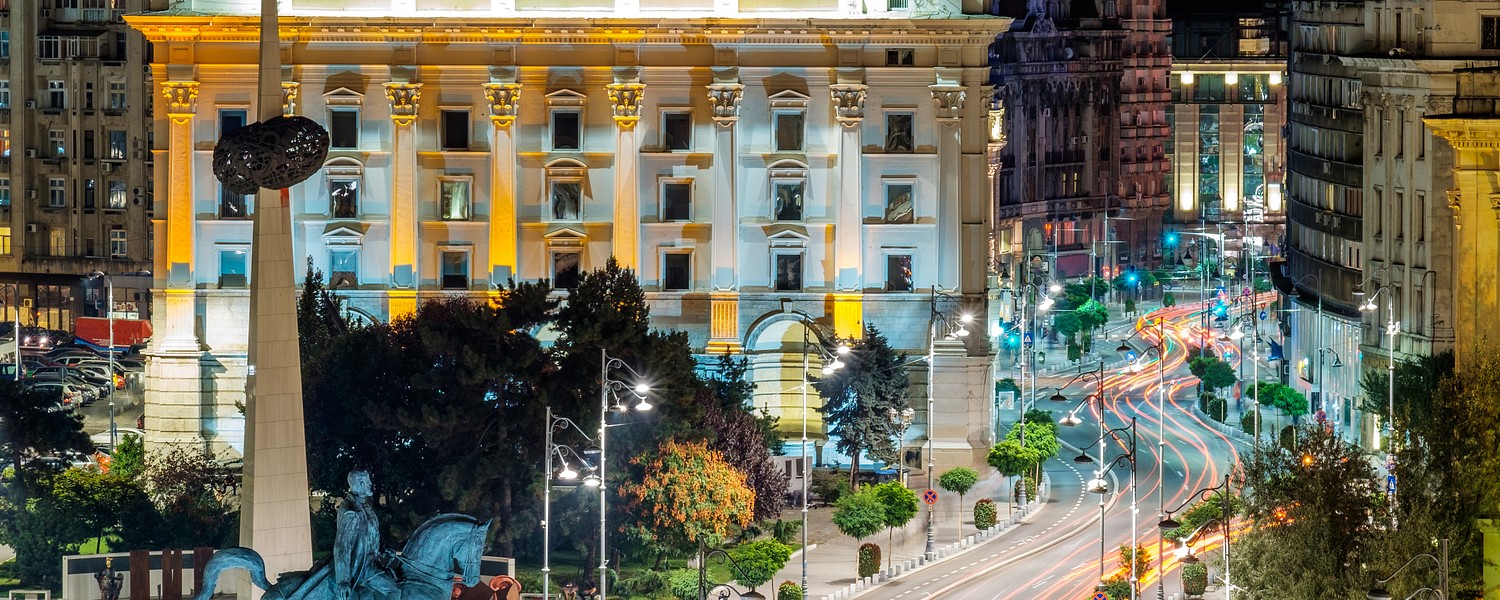
Our travel guides are free to read and explore online. If you want to get your own copy, the full travel guide for this destination is available to you offline* to bring along anywhere or print for your trip.
Limited time: €2
- View on map
- Do & See
- Restaurants
- Bars & Nightlife
- Tourist Information
Section in Bucharest Do & See Bucharest boasts many beautiful monuments and landmarks, the most prominent being the Palace of Parliament — an imposing structure that now houses, among other things, one of the city's best museums: The National Museum of Contemporary Art. Other museums worth visiting are the Museum of the Romanian Peasant and the National Art Museum, housed in the old royal palace. Alternatively, enjoy the vast green spaces the city has to offer, like the gorgeous Parcul Carol, or wander around the charming old town. Read more
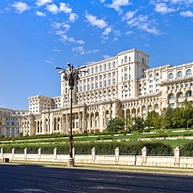
Palace of Parliament
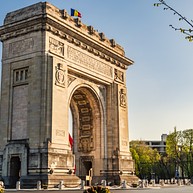
Triumphal Arch
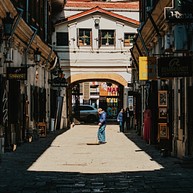
Lipscani District

National Museum of Art
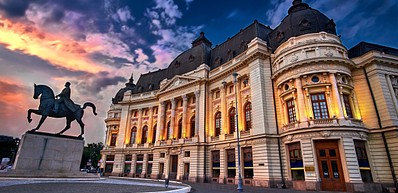
University of Bucharest
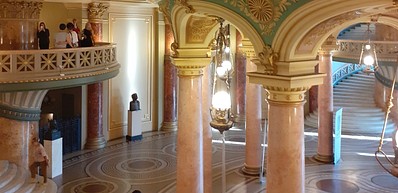
Romanian Athenaeum
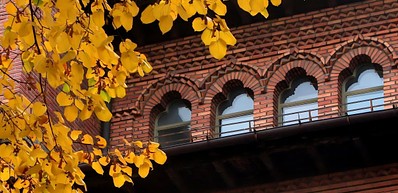
Museum of the Romanian Peasant
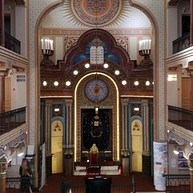
Museum of the History of the Romanian Jews
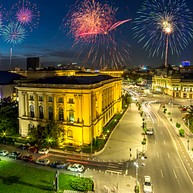
Revolution Square
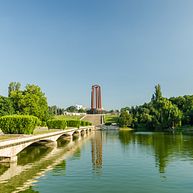
Stavropoleos Monastery Church

Dimitrie Gusti National Village Museum
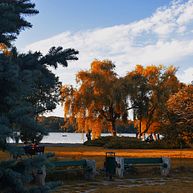
Herăstrău Park
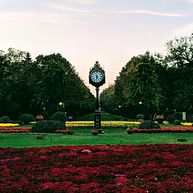
Cișmigiu Gardens
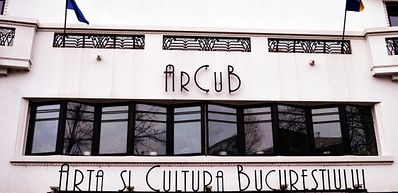
Romanian Patriarchal Cathedral
Ultimate Romania Travel
A Luxury Voyage Blog
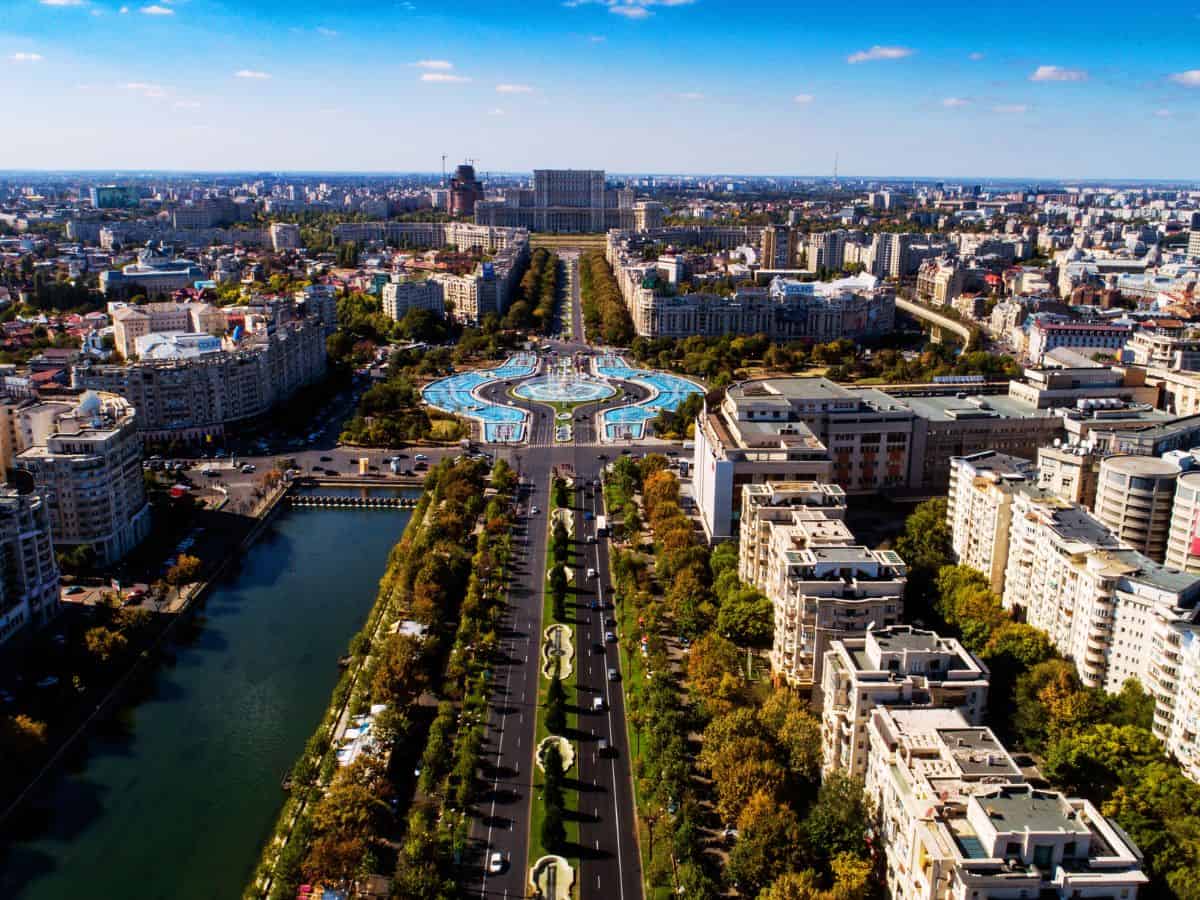
2024 Bucharest Travel Guide: Local Insights for Top Things to Do and See
Welcome to Bucharest, where the rich tapestry of history intertwines seamlessly with vibrant contemporary life. As a proud local, I am thrilled to guide you through the heart of Romania ‘s capital, offering insights that go beyond the usual tourist trails. In this Bucharest Travel Guide, we embark on a journey that encapsulates the essence of the city, revealing hidden gems, cherished traditions, and the pulse of daily life.
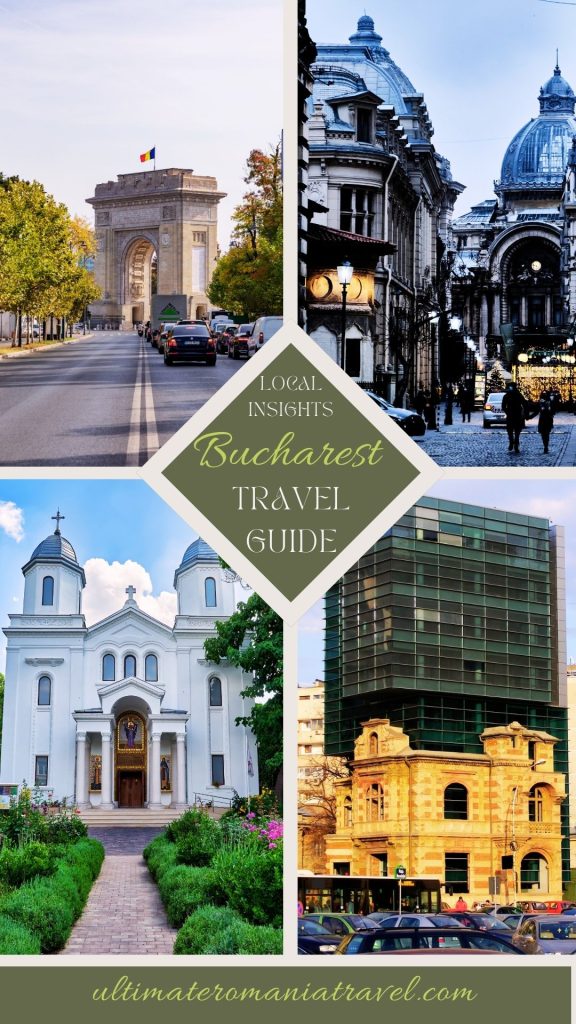
Looking for a destination with a rich history, vibrant culture, natural beauty, and affordability? Look no further than Bucharest! From iconic landmarks to tucked-away gems, this Bucharest Travel Guide delves into the unique blend of old-world charm and modern allure that defines Bucharest. Let’s explore the top things to do and see through the eyes of a local.
From iconic landmarks to tucked-away gems , prepare to immerse yourself in the unique blend of old-world charm and modern allure that defines Bucharest. Let’s explore the top things to do and see through the eyes of a local, creating unforgettable memories in this dynamic city.
Whether indulging in the diverse culinary scene, partaking in local festivals, or navigating the city’s dynamic neighborhoods, this guide is your key to unlocking the authentic charm of Bucharest. Let’s explore the top things to do and see through the eyes of a local, creating unforgettable memories in this dynamic city.
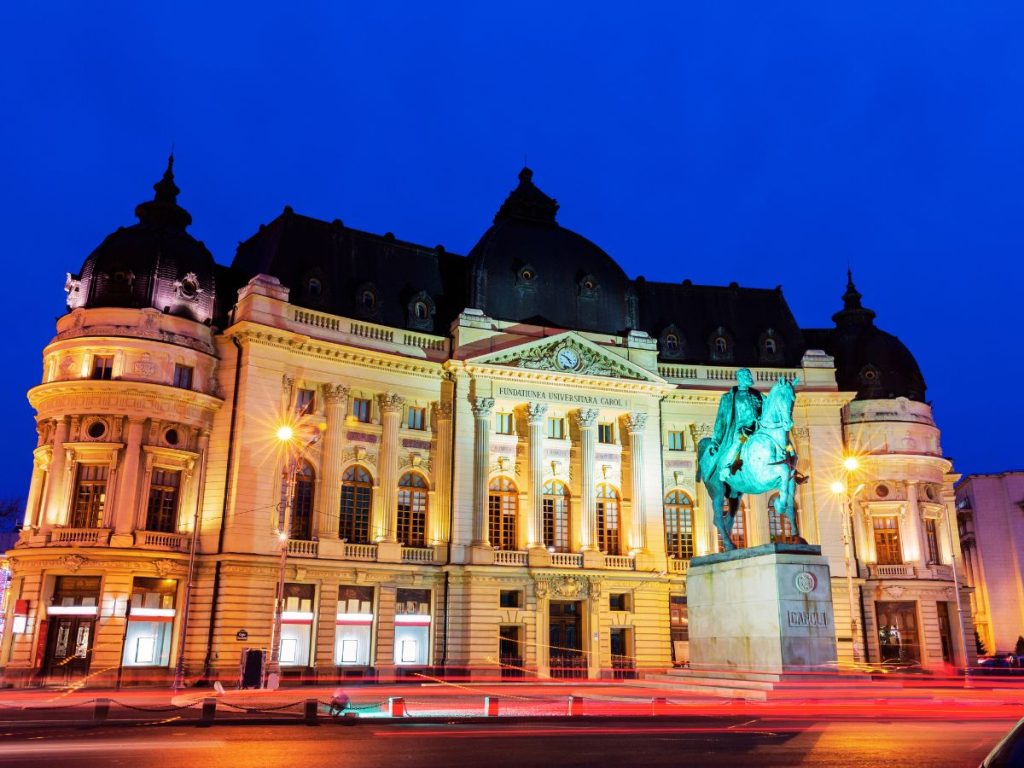
Bucharest Travel Guide
Begin your adventure by strolling down the iconic streets of the Old Town, where centuries-old architecture whispers tales of Bucharest’s past. Venture into the bustling markets, like the historic Obor Market, to experience the lively atmosphere where locals gather to share stories and savor traditional flavors.
As the day unfolds, immerse yourself in the thriving arts scene, exploring the eclectic mix of galleries and street art that adorns the city. Discover the soul-soothing melodies of live music in local cafes or dive into the underground music scene that echoes the city’s rebellious spirit.
For a taste of Bucharest’s royal history, visit the stunning Palace of the Parliament, a colossal structure that stands as a testament to the city’s resilience and architectural grandeur. Uncover the city’s green oasis in Herastrau Park, where locals escape the urban bustle to enjoy serene lakeside views and charming boat rides.
⚕️Getting Travel Insurance Must Be Your Top Priority! Check out the greatest rates offered by Safety Wing !
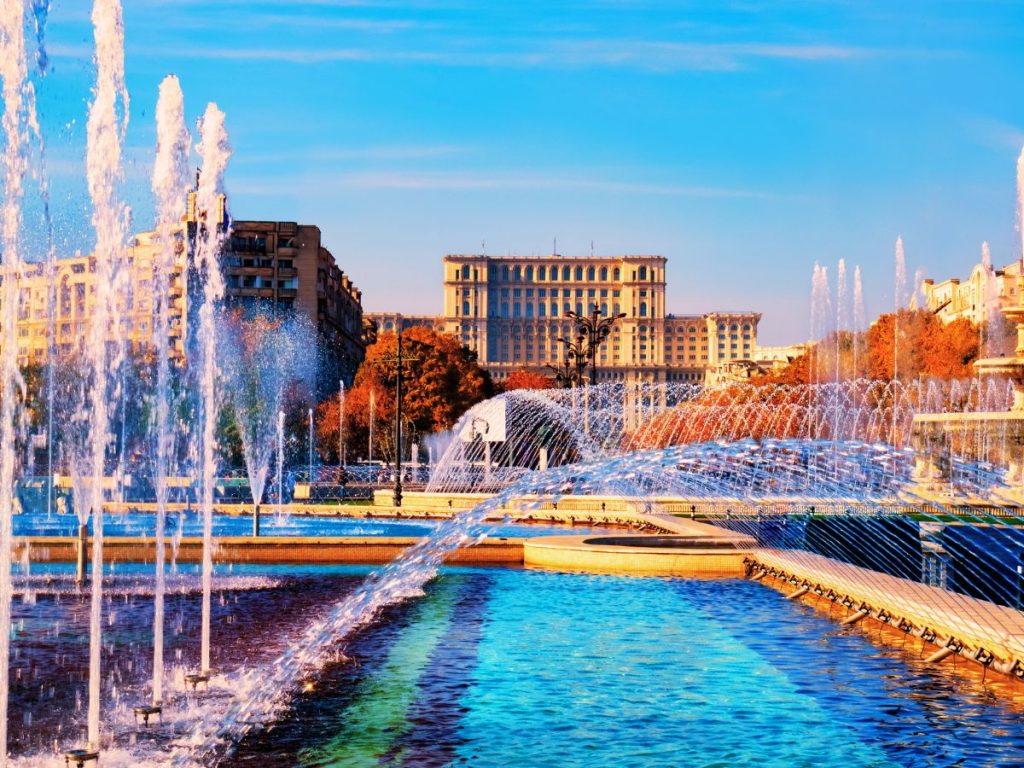
Top Things to Do and See
Explore the hidden alleys of old town.
Dive into the enchanting labyrinth of Bucharest’s Old Town, where cobblestone streets lead you past charming cafes, vibrant street art, and centuries-old architecture. Lose yourself in the history and lively atmosphere of this cultural hotspot.
Savor Local Flavors at Obor Market
Indulge your senses at Obor Market, where locals gather for a feast of colors, aromas, and tastes. From fresh produce to artisanal treats, this market is a culinary adventure, offering a glimpse into the heart of Romanian gastronomy.
Immerse Yourself in Arts at Control Club
Discover the beating heart of Bucharest’s alternative scene at Control Club. This iconic venue not only hosts live concerts but also boasts an ever-evolving art space, capturing the city’s vibrant creative spirit.
Enjoy Lakeside Serenity at Herastrau Park
Escape the urban hustle in Herastrau Park, a green oasis surrounding a serene lake. Rent a boat, take a leisurely stroll, or simply unwind with a picnic, all while soaking in the tranquil beauty that makes this park a local favorite.
Step Back in Time at the Village Museum
Wander through centuries of Romanian history at the Village Museum, an open-air exhibit featuring traditional houses from various regions. It’s a captivating journey through time, showcasing the nation’s rich cultural diversity.
Marvel at the Palace of the Parliament
Stand in awe of the colossal Palace of the Parliament , a monumental masterpiece that tells the story of Romania’s complex history. Take a guided tour to explore the opulent interiors and gain insights into the country’s political past.
Peruse Contemporary Art at MNAC
Elevate your artistic senses at the National Museum of Contemporary Art (MNAC). Housed in the imposing Palace of Parliament, this museum showcases a diverse collection of contemporary Romanian and international artworks.
🎫 Looking for Great Activities to Enjoy While in Romania? Look no further than Viator !
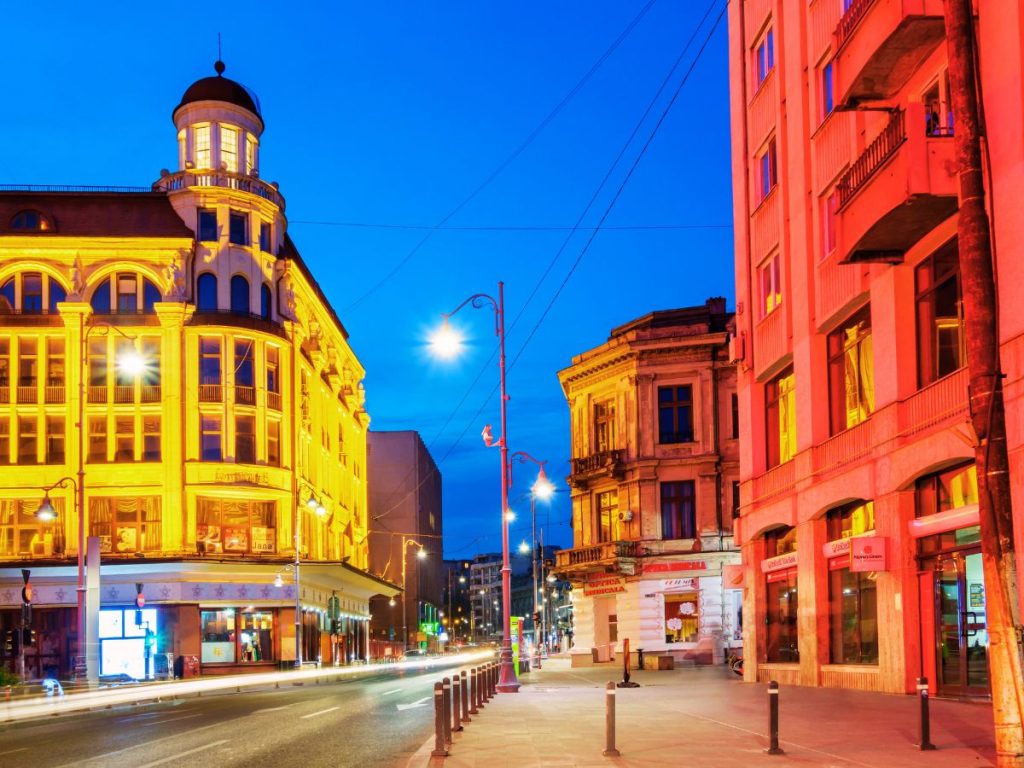
Discover Bucharest’s Hidden Gems
Discover the secret garden of carturesti carusel.
Dive into the literary haven of Carturesti Carusel, a bookstore that goes beyond the ordinary. Beyond the shelves of books, ascend to the top floor for the hidden garden, a quiet retreat with a panoramic view of the city. It’s the perfect spot to get lost in a good book or simply savor the moment.
Relax in the Green Haven of Gradina Icoanei Park
Escape the crowds at Gradina Icoanei Park, a verdant oasis in the heart of the city. This hidden gem offers a peaceful retreat with tree-lined paths, a serene lake, and a sense of tranquility that feels a world away from the bustling streets of Bucharest.
Marvel at the Glass Ceiling of the National Bank of Romania
Venture into the lobby of the National Bank of Romania for a breathtaking sight—the mesmerizing glass ceiling. A hidden architectural gem, this masterpiece bathes the space in natural light, creating an ethereal atmosphere. It’s a serene escape for those seeking a moment of quiet reflection amidst the city’s pulse.
Step into the Ermil Pangratti Museum
Discover the artistic legacy of Ermil Pangratti at this lesser-known museum. Tucked away in a tranquil neighborhood, this museum showcases the works of one of Romania’s prominent painters. It’s an intimate journey through art, offering a unique perspective on the local creative scene.
Experience Time Travel at Pasajul Villacrosse
Pasajul Villacrosse is more than just a passage; it’s a portal to another era. Lined with charming cafes and antique shops, this hidden passage exudes old-world charm. Take a leisurely stroll, absorb the vintage ambiance, and transport yourself to a time when Bucharest was a city of grandeur.
Escape to Vacaresti Nature Park
Nature meets urbanity at Vacaresti Nature Park, a unique urban delta tucked within the city limits. This untouched wilderness is a haven for birdwatchers and nature enthusiasts. Wander through the serene landscapes, observe the local flora and fauna, and escape the urban chaos without leaving the city.
Unearth Curiosities at the Museum of Old Maps
For history buffs and cartography enthusiasts, the Museum of Old Maps is a treasure trove of curiosities. Located in a discreet corner, this small museum showcases antique maps that unfold the city’s evolution over the centuries. It’s a captivating journey through the cartographic history of Bucharest.
✈️ Check out Great Deals on Flights with Skyscanner ! Here You will Find the Best Rates !
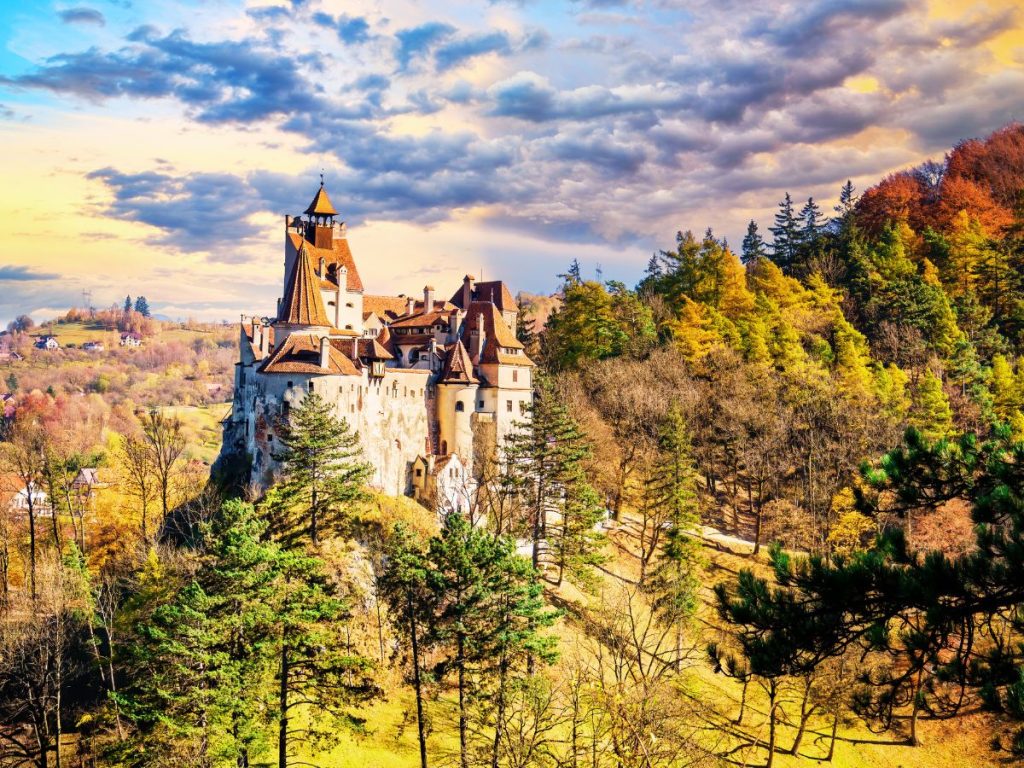
Day trips from Bucharest to Amazing Destinations
Escape to the tranquil beauty of snagov monastery and lake.
Just a short drive from Bucharest lies the serene retreat of Snagov Monastery and Lake. Nestled in lush greenery, this historical site is not only a haven for spiritual contemplation but also a picturesque escape. Take a boat ride on the lake, explore the island monastery, and immerse yourself in the tranquility that feels a world away from the city’s hustle.
Uncover the Mysteries of Peleș Castle in Sinaia
Embark on a royal day trip to the enchanting town of Sinaia, home to the fairytale-like Peleș Castle. Nestled against the Carpathian Mountains, this architectural gem invites you to explore its opulent rooms, lush gardens, and captivating history. It’s a journey into Romania’s regal past that promises awe-inspiring views and a touch of elegance.
Wander Through the Medieval Charm of Brasov
A scenic drive to Brasov unfolds a captivating blend of medieval architecture, cobblestone streets, and a lively town square. From the iconic Black Church to the panoramic views from Tampa Mountain, Brasov offers a day trip filled with historical allure and vibrant local culture. Don’t forget to indulge in a traditional Romanian meal at a local eatery.
Hike the Bucegi Mountains and Discover Sphinx Rock
For those craving adventure, a day trip to the Bucegi Mountains is a must. The hiking trails lead you to stunning viewpoints, and the highlight is the Sphinx, a natural rock formation resembling the mythical creature. The mountain air, panoramic vistas, and a touch of mystique make this day trip a favorite among nature enthusiasts and explorers.
Venture into the Legends of Bran Castle, the Dracula Fortress
No exploration of day trips from Bucharest is complete without a visit to the iconic Bran Castle, often associated with the Dracula legend. Nestled on the border between Transylvania and Wallachia, this medieval fortress exudes an aura of mystery and history. Wander through its creaking corridors, climb the towers for panoramic views of the surrounding landscapes, and immerse yourself in the tales that have made Bran Castle a timeless symbol of Romanian folklore. It’s a journey into the heart of Transylvania that combines history, myth, and breathtaking architecture for an unforgettable day trip.
🚗 Find the Best Deals on a Rental Car with Discover Cars ! They have the most affordable options and the best customer service !
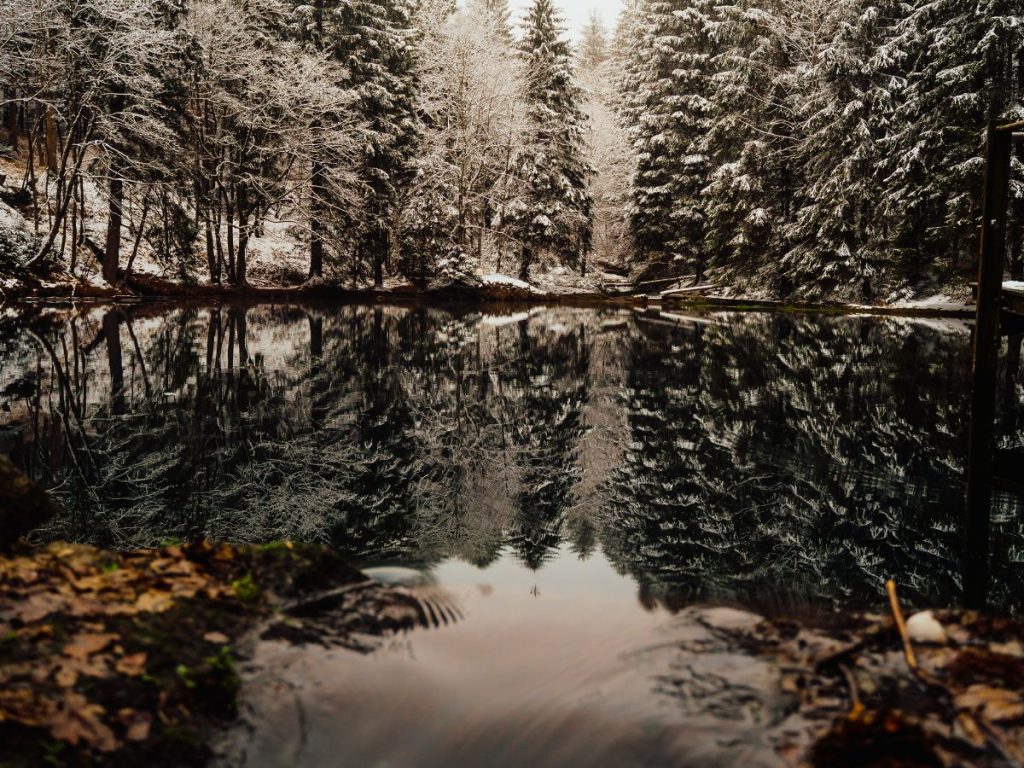
What is the best time of year to visit Bucharest?
Spring-summer.
Bucharest experiences its peak tourist season during the summer months, from June to August, and the latter part of spring, from late April to May . During these periods, the weather is generally warm and pleasant, with temperatures ranging from 20°C to 30°C (68°F to 86°F). The city comes alive with outdoor events, festivals, and vibrant street life. Parks and gardens, such as Herastrau Park and Carol Park, are in full bloom, creating a picturesque backdrop for leisurely strolls. Outdoor cafes bustle with activity, and the cultural scene is at its zenith, making it an ideal time to explore the city’s attractions, dine in open-air terraces, and partake in various cultural events.
Autumn-winter
Autumn, from September to November , brings a crispness to the air, with temperatures ranging from 10°C to 20°C (50°F to 68°F). This season offers a more relaxed atmosphere, perfect for exploring the city’s museums, historical sites, and indoor attractions. The fall foliage adds a touch of warmth to the parks, making it a delightful time for nature walks. Winter, from December to February, brings colder temperatures, occasionally dipping below freezing. While the city is adorned with festive lights and holiday decorations, it’s also a season for indoor activities. Visitors can enjoy the city’s Christmas markets, explore Bucharest’s vibrant nightlife, and savor hearty Romanian cuisine in cozy restaurants. Additionally, winter is an excellent time for those interested in winter sports, with nearby mountain resorts offering skiing and snowboarding opportunities.
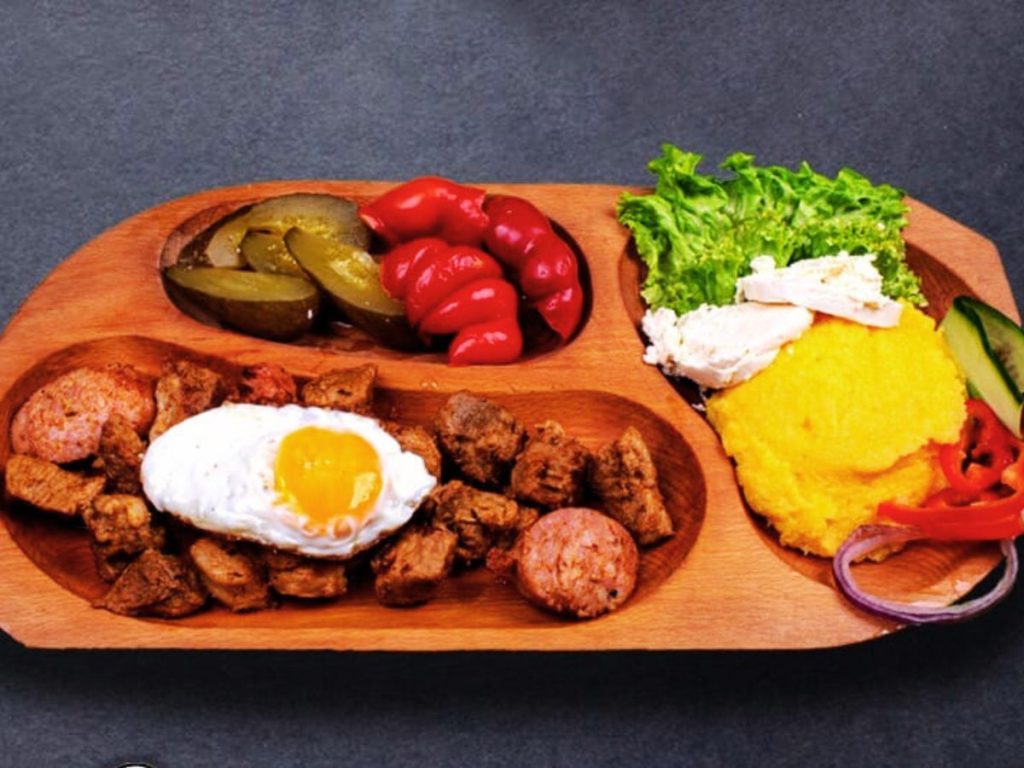
Enjoy traditional cuisine at local restaurants
Embark on a culinary journey in Bucharest with my Local Guide to the 21 Best Restaurants You Must Visit ! From traditional Romanian delights in the heart of Lipscani to the modern gastronomic experiences of the Primăverii neighborhood, this curated list ensures that every palate discovers the vibrant flavors Bucharest has to offer.
Dine Like a Local at Caru’ cu Bere
Experience the true taste of Romanian cuisine at Caru’ cu Bere, a historic beerhouse that combines delicious local dishes with a lively, convivial atmosphere. From mămăligă to sarmale, let your taste buds revel in authentic flavors.
Sip Artisanal Coffee at Steam Coffee Shop
Escape the mainstream coffee scene and discover Steam Coffee Shop, a hidden haven for coffee enthusiasts. Tucked away in a cozy corner, this artisanal coffee spot offers a carefully curated selection of beans, expertly brewed to perfection. It’s a caffeine oasis where locals savor every sip in style.
Embark on a Culinary Adventure at Macca Villacrosse Passage
Uncover the gastronomic delights hidden within the historic Macca Villacrosse Passage. This quaint arcade, adorned with colorful umbrellas, houses a diverse array of eateries, cafes, and bistros. From authentic Romanian dishes to international flavors, this tucked-away culinary hub invites you to indulge in a delightful journey of tastes and aromas, all while surrounded by the charm of a hidden city gem.
Unwind at Hanul cu Tei
Tucked away in the heart of Bucharest, Hanul cu Tei is a hidden gem that transports you to a bygone era. This charming courtyard, adorned with vintage shops and cozy cafes, is a serene escape from the city bustle. Take a moment to sip on a coffee, explore the boutiques, and feel the historical charm that permeates every corner.
Indulge in Sweet Delights at Atelierul de Tarte
For a taste of heaven in every bite, head to Atelierul de Tarte. This boutique pastry shop, nestled in a quiet corner, crafts artisanal tarts that are as visually stunning as they are delicious. Treat your taste buds to a symphony of flavors, each tart a testament to culinary craftsmanship.
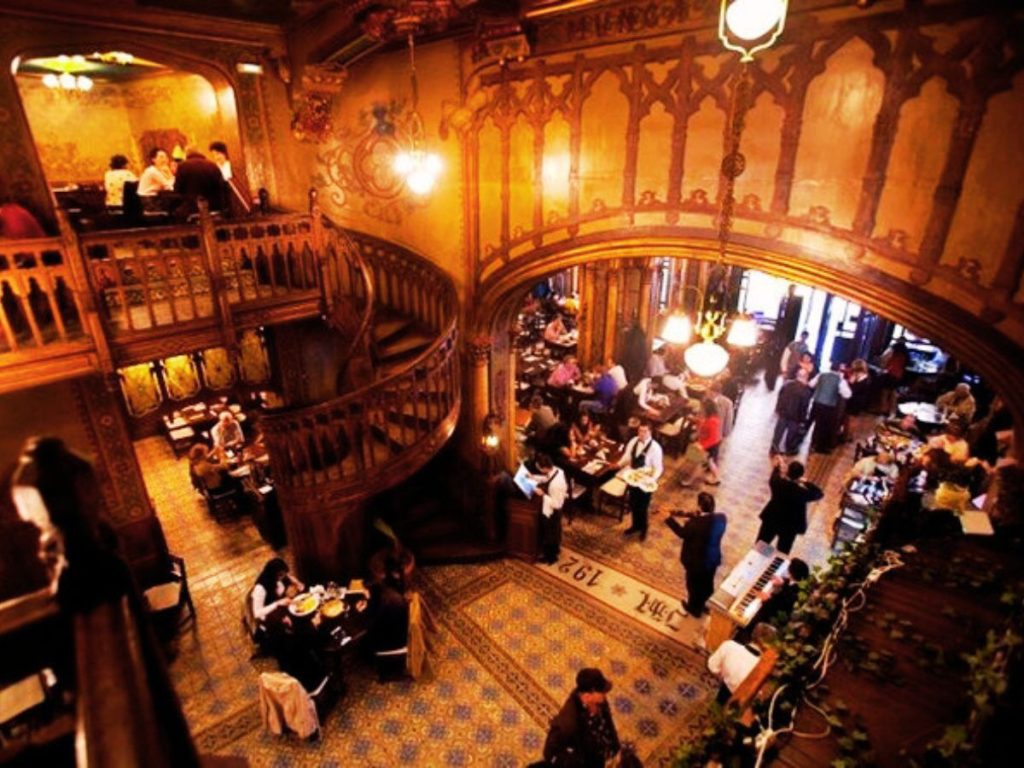
Experience the nightlife in the city
Join the nightlife extravaganza in lipscani.
As the sun sets, immerse yourself in the vibrant nightlife of Lipscani. From trendy bars to eclectic clubs, this district pulsates with energy, offering an unforgettable evening of music, dance, and local camaraderie.
Attend a Local Festival at Carol Park
Embrace the festive spirit at Carol Park, hosting a myriad of events and festivals throughout the year. From music festivals to cultural celebrations, this green expanse becomes a lively stage for Bucharest’s dynamic and diverse community.
Navigate the Street Art of Fabrica Club
Fabrica Club isn’t just a nightlife destination; it’s a canvas of urban expression. Venture beyond the dance floor to explore the vibrant street art that adorns the exterior. Each mural tells a story, adding an extra layer of character to this hidden artistic haven.
🏨 Booking.com is Your Go-To Site for the Best Places to Stay in Romania!
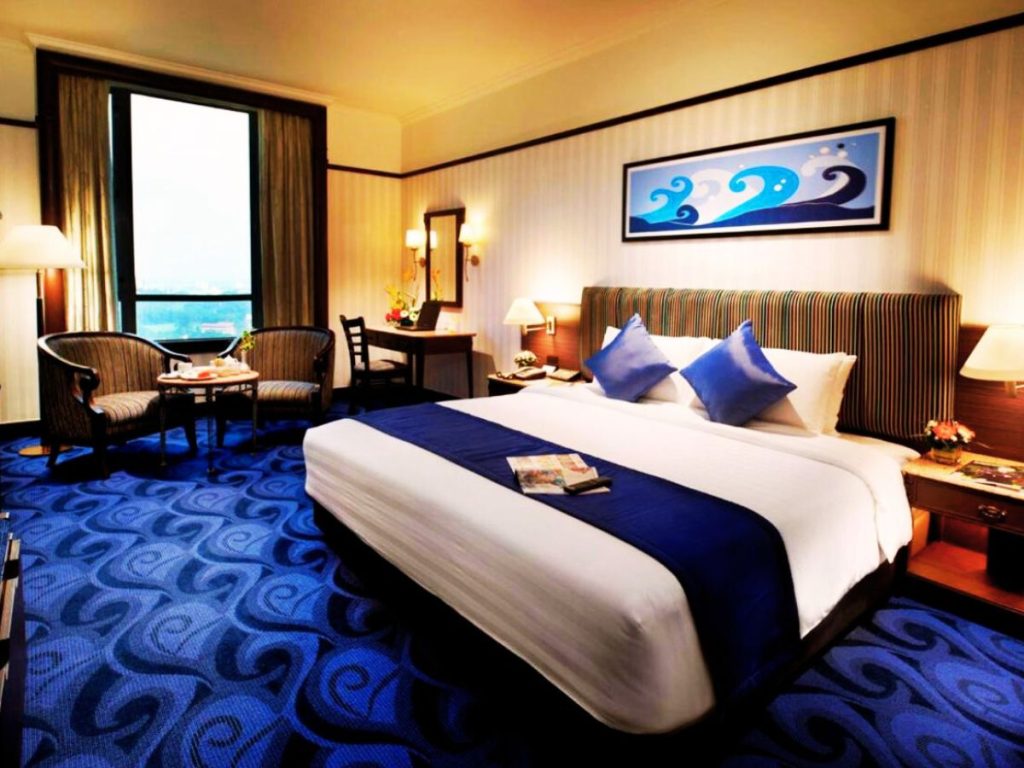
Accommodation in Bucharest
When deciding where to stay in Bucharest, explore the diverse neighborhoods for a personalized experience. From the historic charm of Old Town to the chic ambiance of Dorobanti,my curated list of the 13 best neighborhoods and hotels in Bucharest ensures you find the perfect accommodation to complement your adventure.
Luxury Retreat at Athénée Palace Hilton
Located in the heart of Bucharest, Athénée Palace Hilton is synonymous with opulence and sophistication. This historic hotel has welcomed royalty and celebrities, offering luxurious rooms, impeccable service, and exquisite dining. Its central location allows guests to explore the city’s cultural landmarks and vibrant nightlife easily. With a blend of classic elegance and modern comfort, Athénée Palace Hilton stands as an epitome of luxury in the heart of Bucharest.
Chic Boutique Vibes at Epoque Hotel
Tucked away in a quiet corner near Cismigiu Park, the Epoque Hotel provides an intimate and stylish retreat. This boutique hotel seamlessly combines modern design with historic charm, offering spacious rooms and personalized service. The serene courtyard and spa facilities add to the overall sense of tranquility, making Epoque Hotel an ideal choice for those seeking a refined and relaxed atmosphere.
Mid-Range Comfort at Europa Royale Bucharest
Situated in the lively Old Town, Europa Royale Bucharest strikes the perfect balance between affordability and comfort. The hotel’s classic yet contemporary design, along with its proximity to key attractions and buzzing nightlife, makes it an excellent choice for mid-range budgets. Comfortable rooms, a rooftop terrace with city views, and a central location contribute to the overall appeal of Europa Royale.
Budget-Friendly Stay at K+K Hotel Elisabeta
For those watching their budget without compromising on quality, K+K Hotel Elisabeta offers a fantastic value proposition. Centrally located and within walking distance of major landmarks, this hotel provides modern amenities and a cozy atmosphere. Clean and comfortable rooms, coupled with friendly service, make K+K Hotel Elisabeta an excellent choice for budget-conscious travelers looking for a convenient and pleasant stay.
Social Hub at Antique Hostel Bucharest
For the more adventurous and socially inclined traveler, Antique Hostel Bucharest offers inviting and economical accommodation. The communal spaces foster a sociable atmosphere, and the hostel’s central location makes it easy for guests to explore the historic charm of the Old Town, all while keeping costs in check. With its friendly ambiance and affordability, Antique Hostel Bucharest is a reliable choice for budget-conscious travelers seeking a convenient and communal experience.
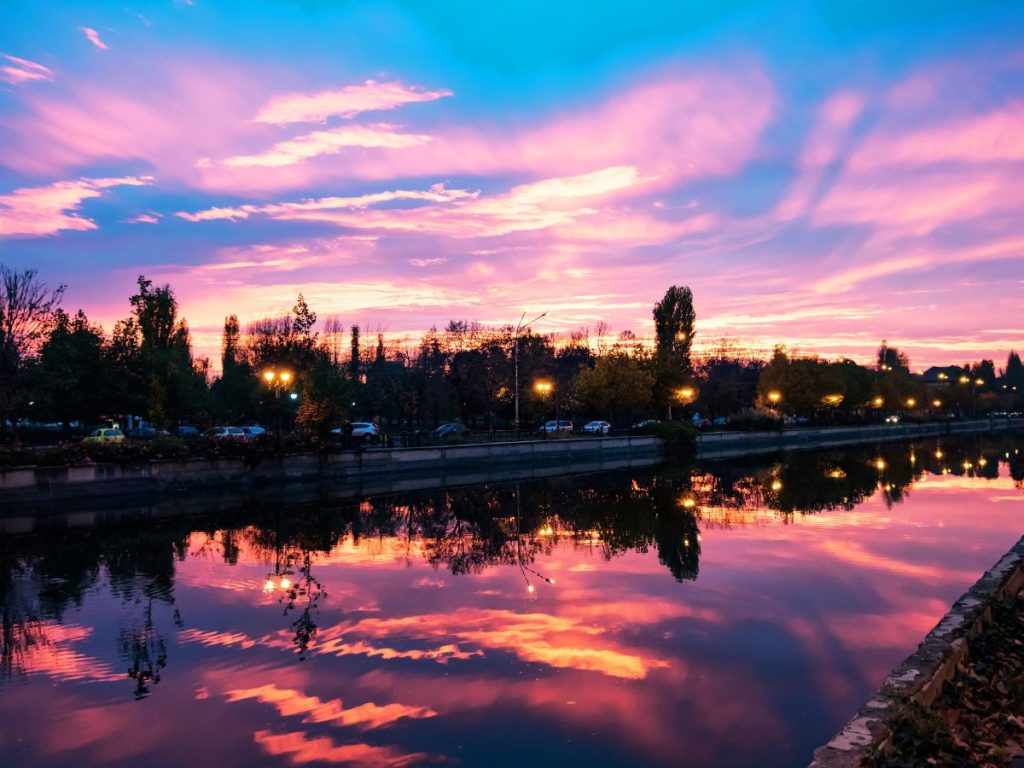

FAQs: Bucharest Travel Guide
Why is bucharest so popular.
Bucharest’s popularity stems from its rich history reflected in landmarks like the Palace of the Parliament, its vibrant cultural scene, and a unique blend of historical charm with a modern urban vibe. The city’s lively atmosphere, diverse culinary offerings, and dynamic nightlife contribute to its appeal, making it a must-visit destination for those seeking a multifaceted travel experience.
What should I be careful of in Bucharest?
Whether you are a solo female traveler in Bucharest or visiting the city with your family or a group of friends, you must exercise caution against pickpocketing in crowded areas and be wary of traffic when crossing streets, as drivers may not always adhere to strict pedestrian rules. Additionally, be cautious with taxi services; it’s advisable to use reputable companies or ride-sharing apps to ensure fair fares.
How many days are enough for Bucharest?
The ideal duration for a visit to Bucharest depends on your travel preferences, but spending 3 to 4 days allows you to explore the city’s main attractions, delve into its cultural offerings, and experience the local atmosphere. This timeframe allows a balance between seeing the key sites and immersing yourself in the vibrant life of Romania’s capital.
What is Bucharest best known for?
Bucharest is best known for its rich history reflected in landmarks like the Palace of the Parliament, vibrant cultural scenes, and the charming architecture of the Old Town. Additionally, it’s renowned for its lively nightlife, diverse culinary scene, and the fusion of historical charm with modern urban energy.
Is Bucharest worth seeing?
Yes, Bucharest is worth seeing for its unique blend of history, culture, and contemporary vibrancy, showcased in landmarks like the Palace of the Parliament, eclectic neighborhoods, and dynamic arts scene. The city offers a diverse range of experiences, from exploring historical sites to enjoying local cuisine and vibrant nightlife.
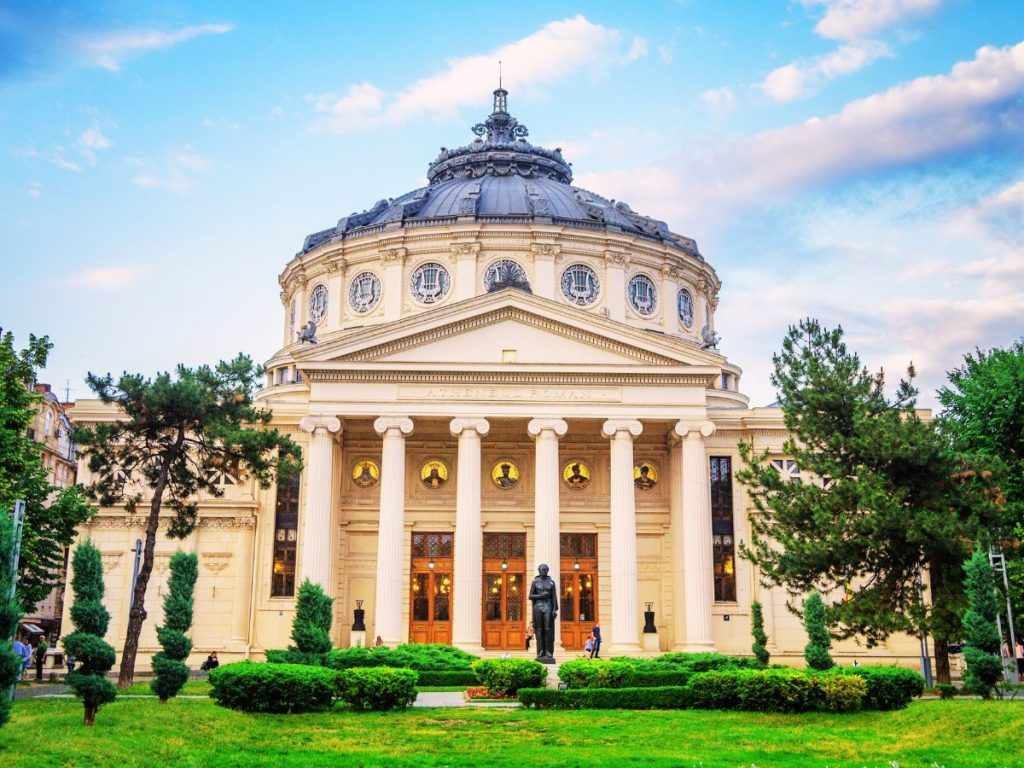
Conclusion of Bucharest Wanderlust
As I conclude this Comprehensive Travel Handbook, consider the city as a captivating fusion of history and contemporary vibrancy. From the monumental Palace of the Parliament to the charm of Old Town, Bucharest beckons with diverse experiences. Whether exploring hidden gems, savoring local flavors, or embracing the arts scene, may your time in Bucharest be a tapestry of vibrant moments and local discoveries. Safe travels, and may you find the heart of my city in every corner you explore!
Similar Posts

What is Romania Known for? Answers from a Local for Your 2024 Trip

When to Travel to Romania? Best Time to Go to Romania by Month!
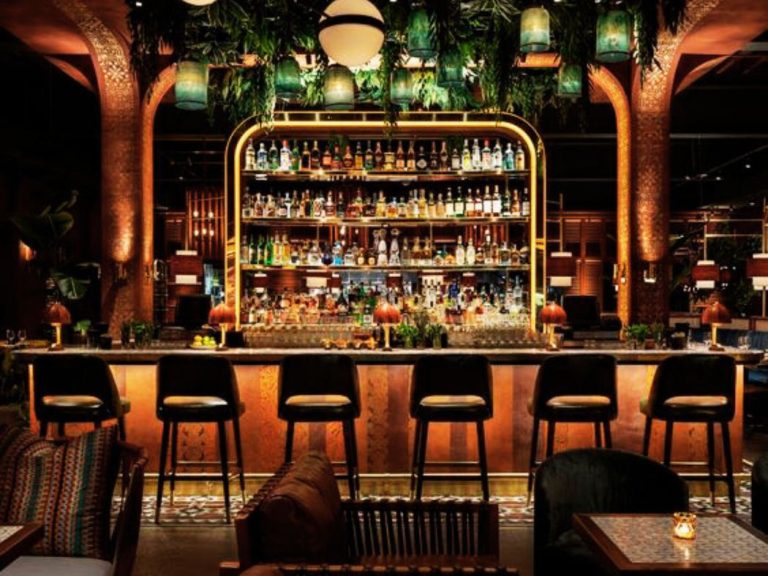
A Local Guide to Bucharest Nightlife: 41 Hotspots & Hidden Gems in 2024
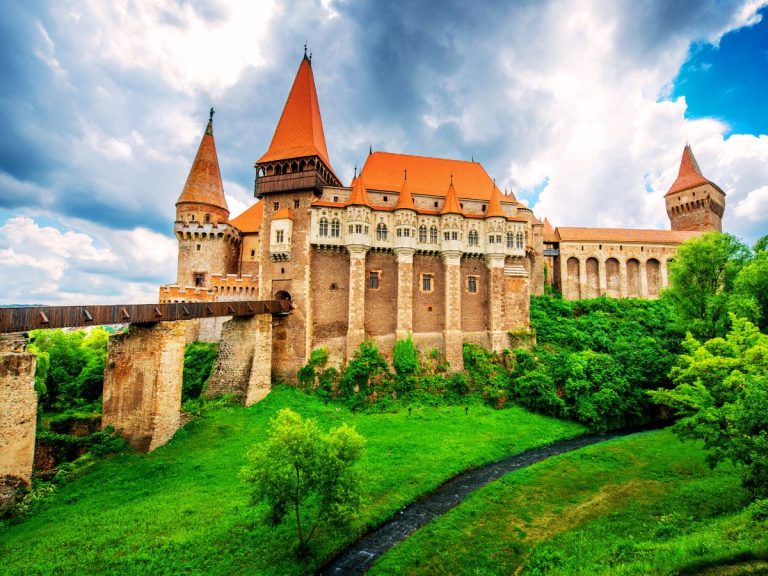
What Are the Most Underrated Destinations in Romania? 71 Hidden Treasures!
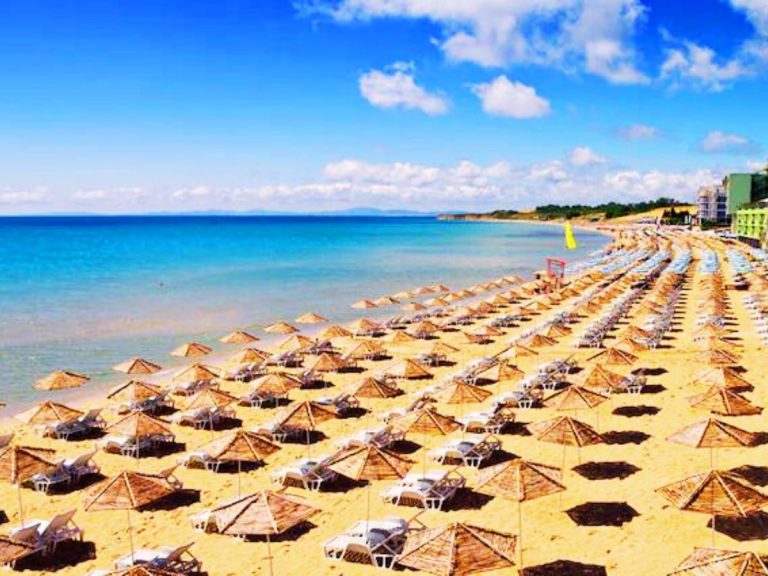
13 Best Summer Beach Resorts in Romania! Local List of Coastal Escape in 2024
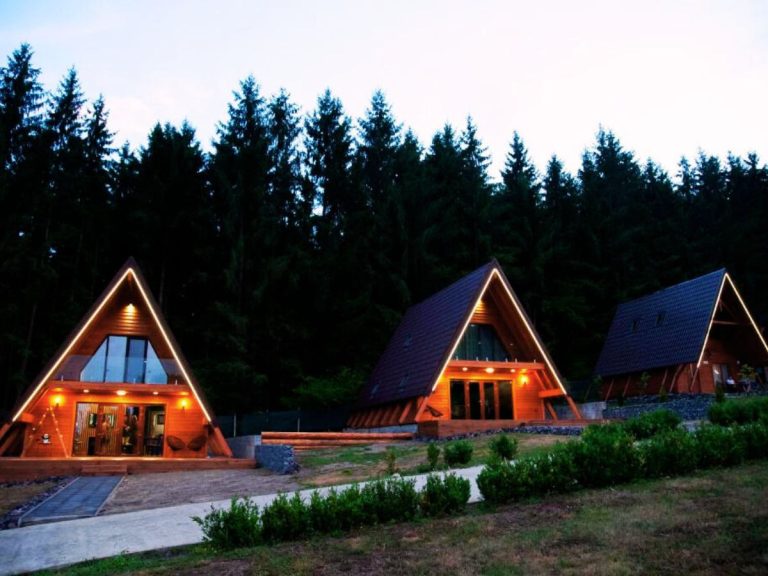
Best Romania Hotels Unveiled by a Local: A Guide to Exquisite Stays in 2024
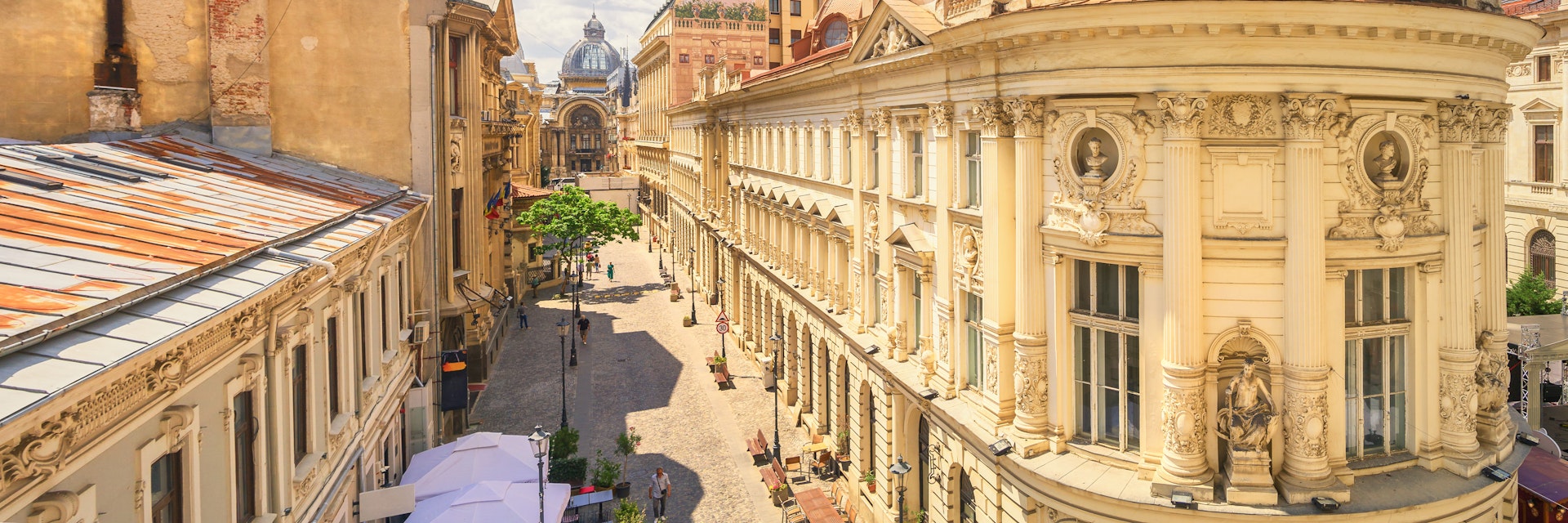
Getty Images/iStockphoto
Romania’s capital sometimes gets a bad rap, but in fact it's dynamic, energetic and lots of fun. Many travellers give the city just a night or two before heading off to Transylvania, but that’s not enough time. Allow at least a few days to take in the very good museums, stroll the parks and hang out at trendy cafes and drinking gardens. While much of the centre is modern and the buildings are in various stages of disrepair, you'll find splendid 17th- and 18th-century Orthodox churches and graceful belle époque villas tucked away in quiet corners. Communism changed the face of the city forever, and nowhere is this more evident than at the gargantuan Palace of Parliament, the grandest (and arguably crassest) tribute to dictatorial megalomania you’ll ever see.
Attractions
Must-see attractions.
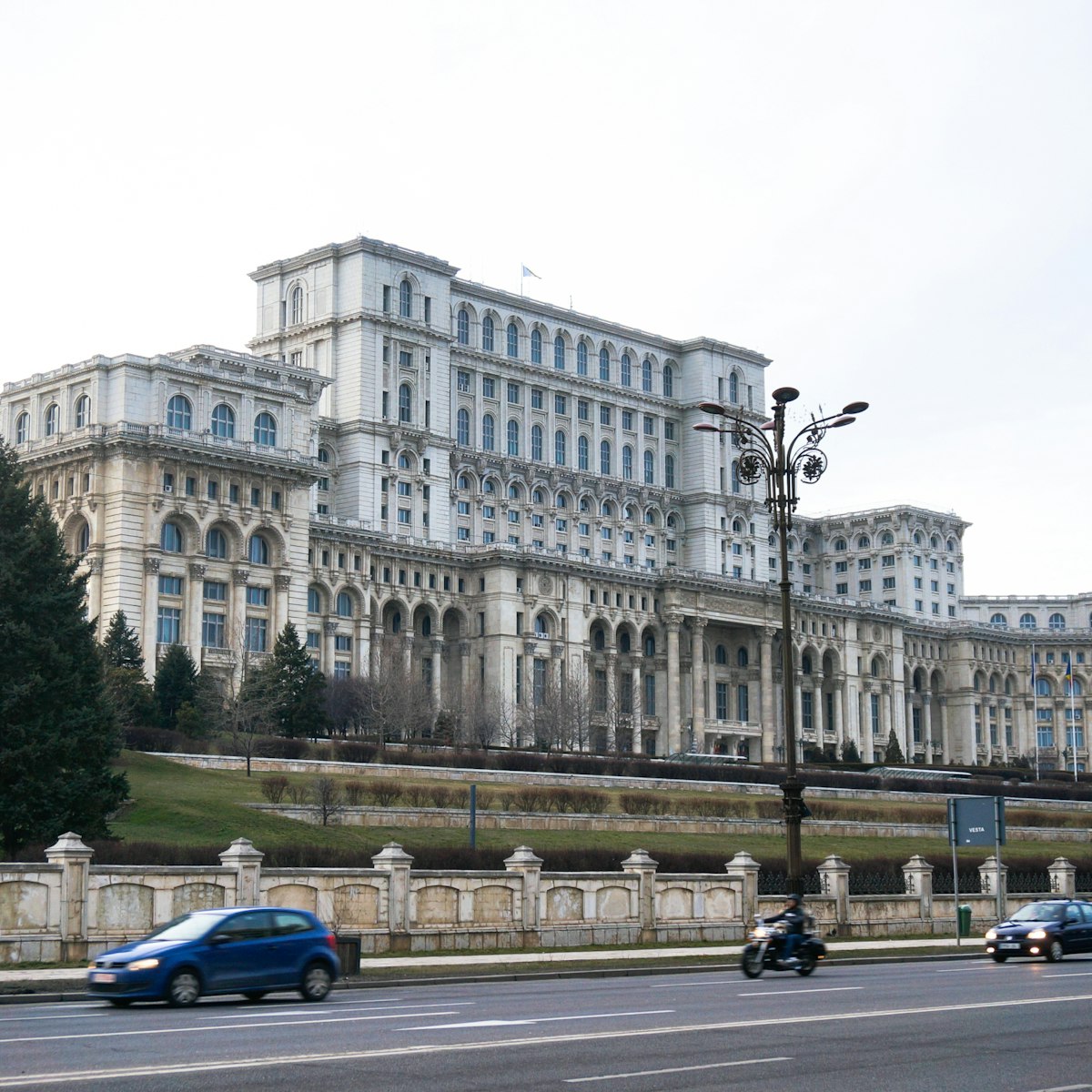
Palace of Parliament
The Palace of Parliament is the world’s second-largest administrative building (after the Pentagon) and former dictator Nicolae Ceauşescu’s most infamous…
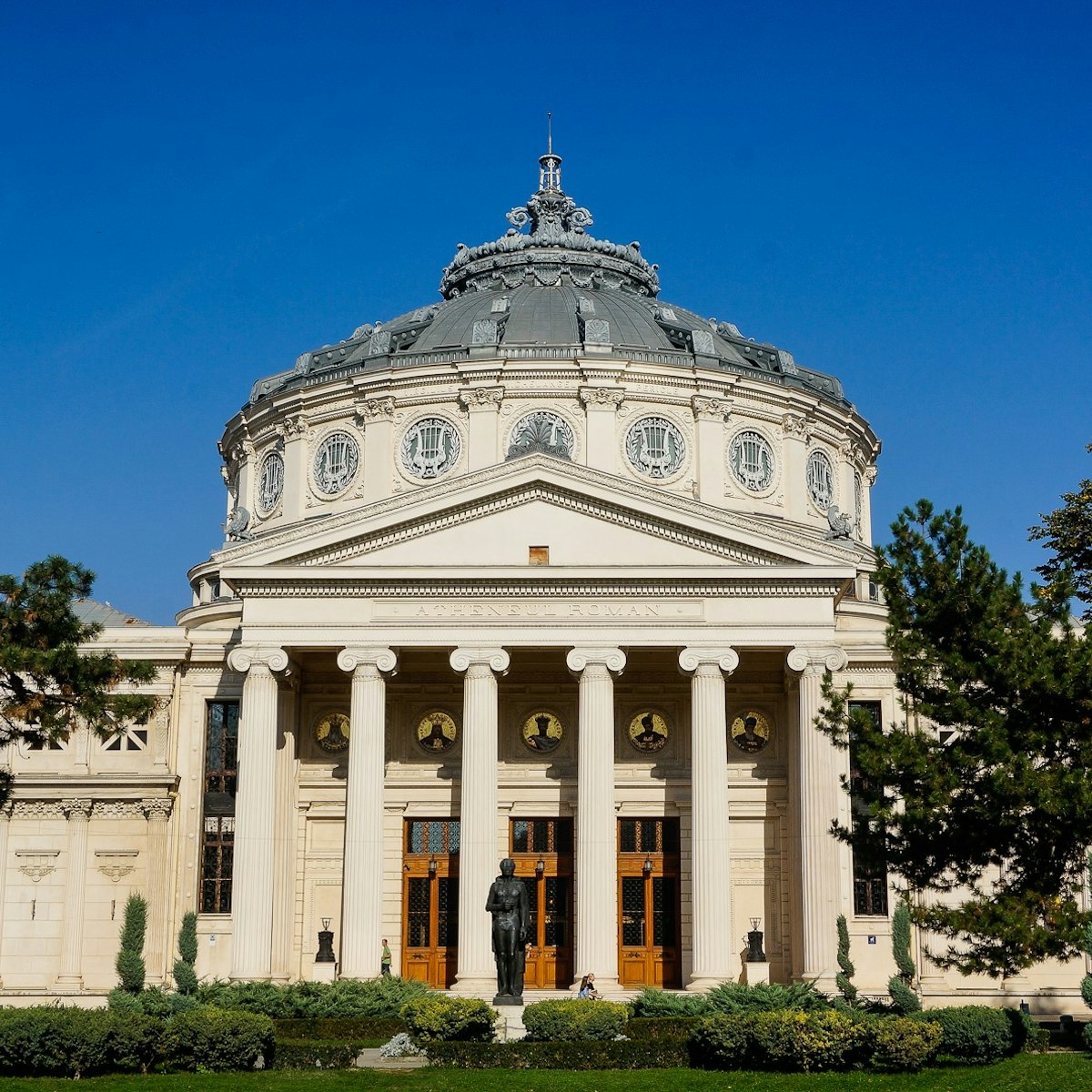
Romanian Athenaeum
The exquisite Athenaeum is the majestic heart of Romania’s classical-music tradition. Scenes from Romanian history are featured on the interior fresco…
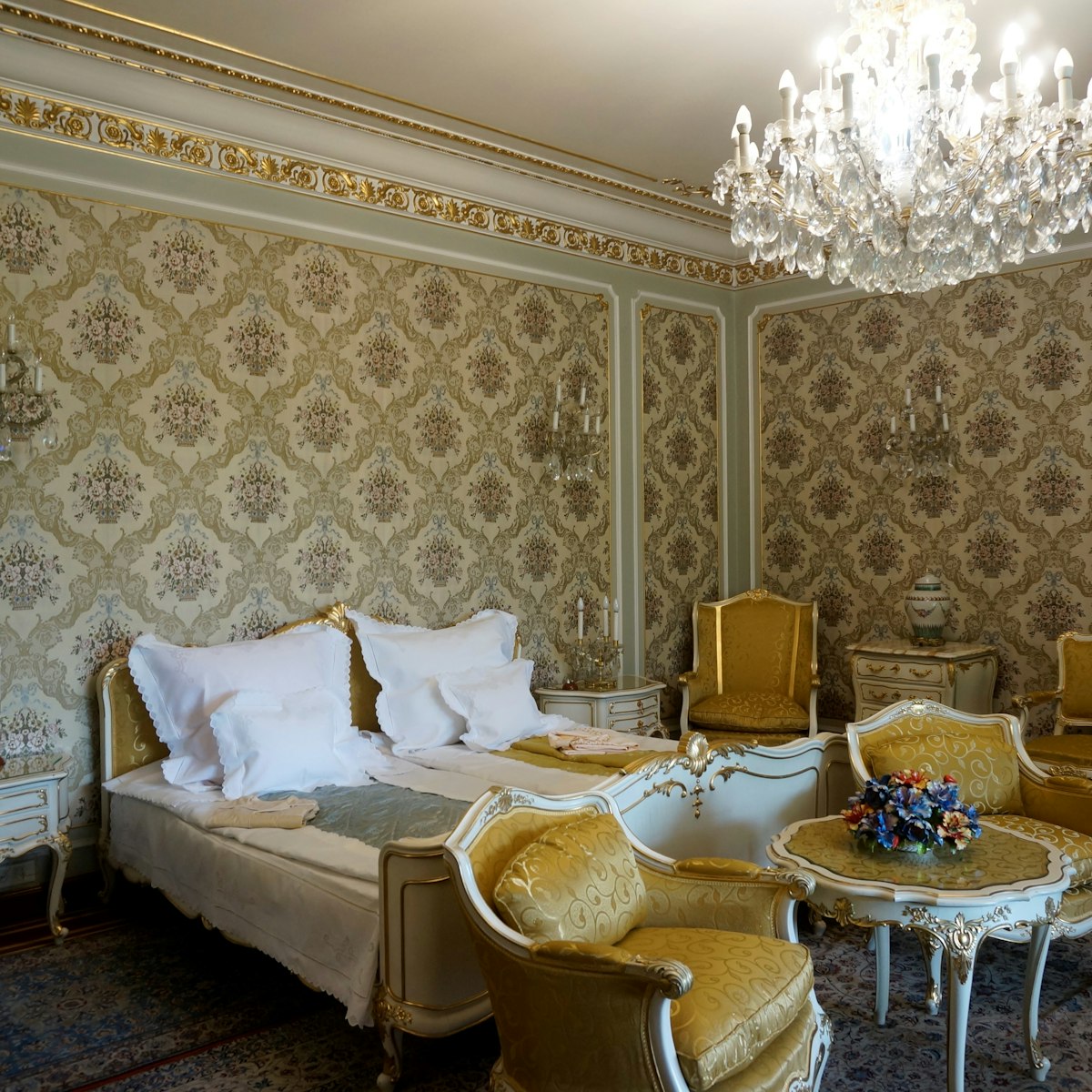
Former Ceauşescu Residence
This restored villa is the former main residence of Nicolae and Elena Ceauşescu, who lived here for around two decades up until the end in 1989…

Grigore Antipa Natural History Museum
One of the few attractions in Bucharest aimed squarely at kids, this natural-history museum, showing off Romania's plant and animal life, has been…

Cişmigiu Garden
West of Calea Victoriei is the locally beloved Cişmigiu Garden, with shady walks, a lake, cafes and a ridiculous number of benches on which to sit and…
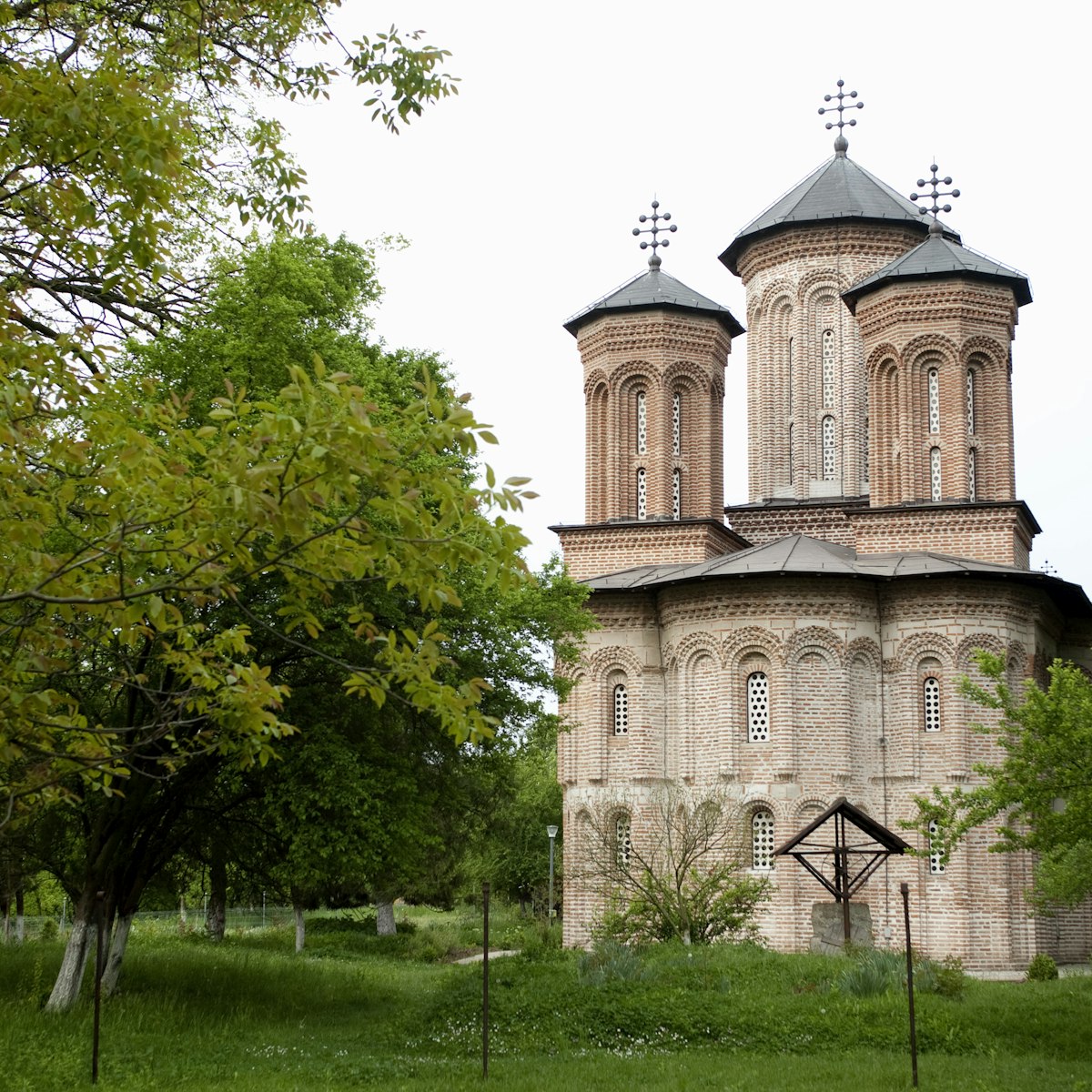
Snagov Monastery
Tiny Snagov Island, at the northern end of Snagov Lake, is home to Snagov Monastery and Vlad Ţepeş' alleged final resting place. The small stone church…
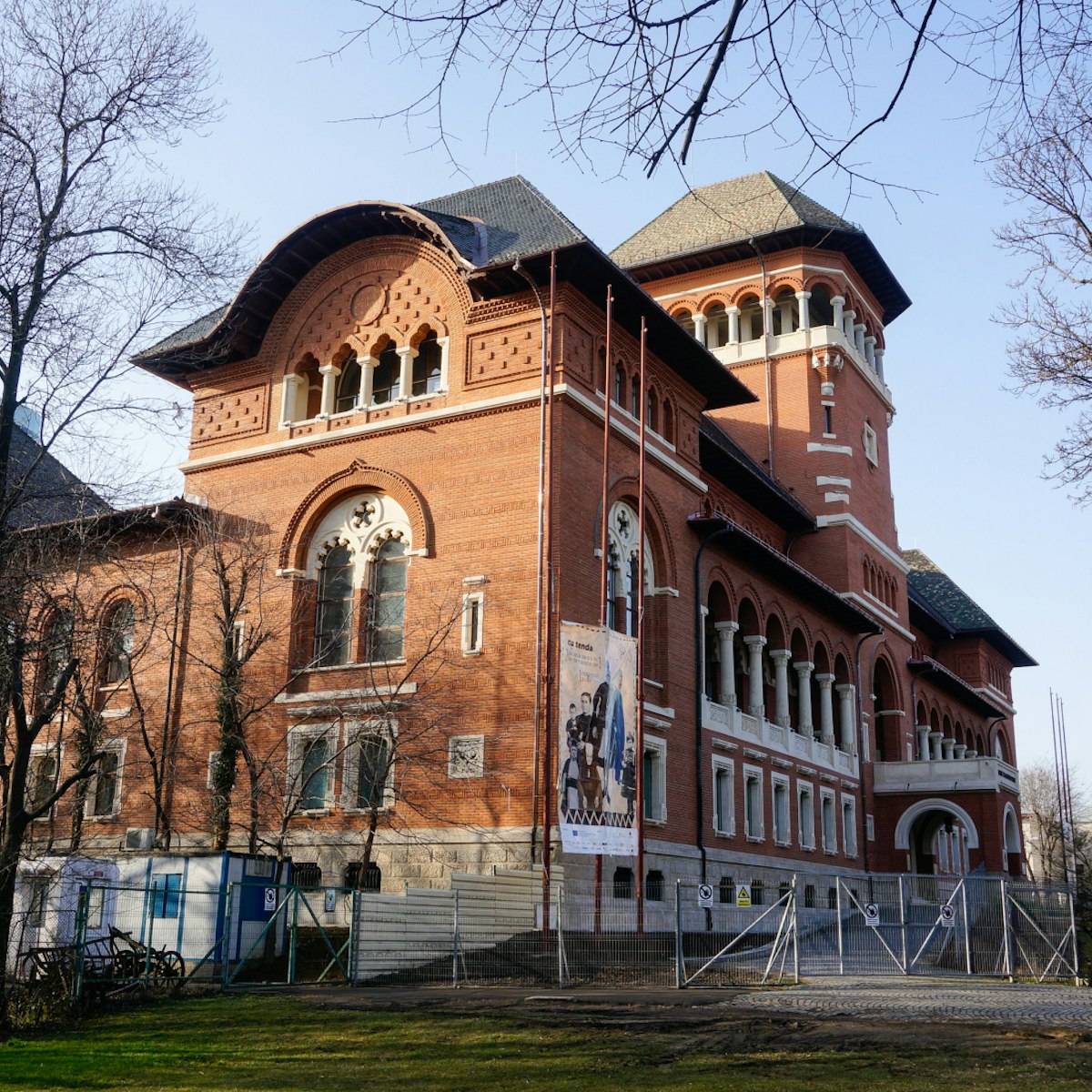
Museum of the Romanian Peasant
The collection of peasant bric-a-brac, costumes, icons and partially restored houses makes this one of the most popular museums in the city. There’s not…
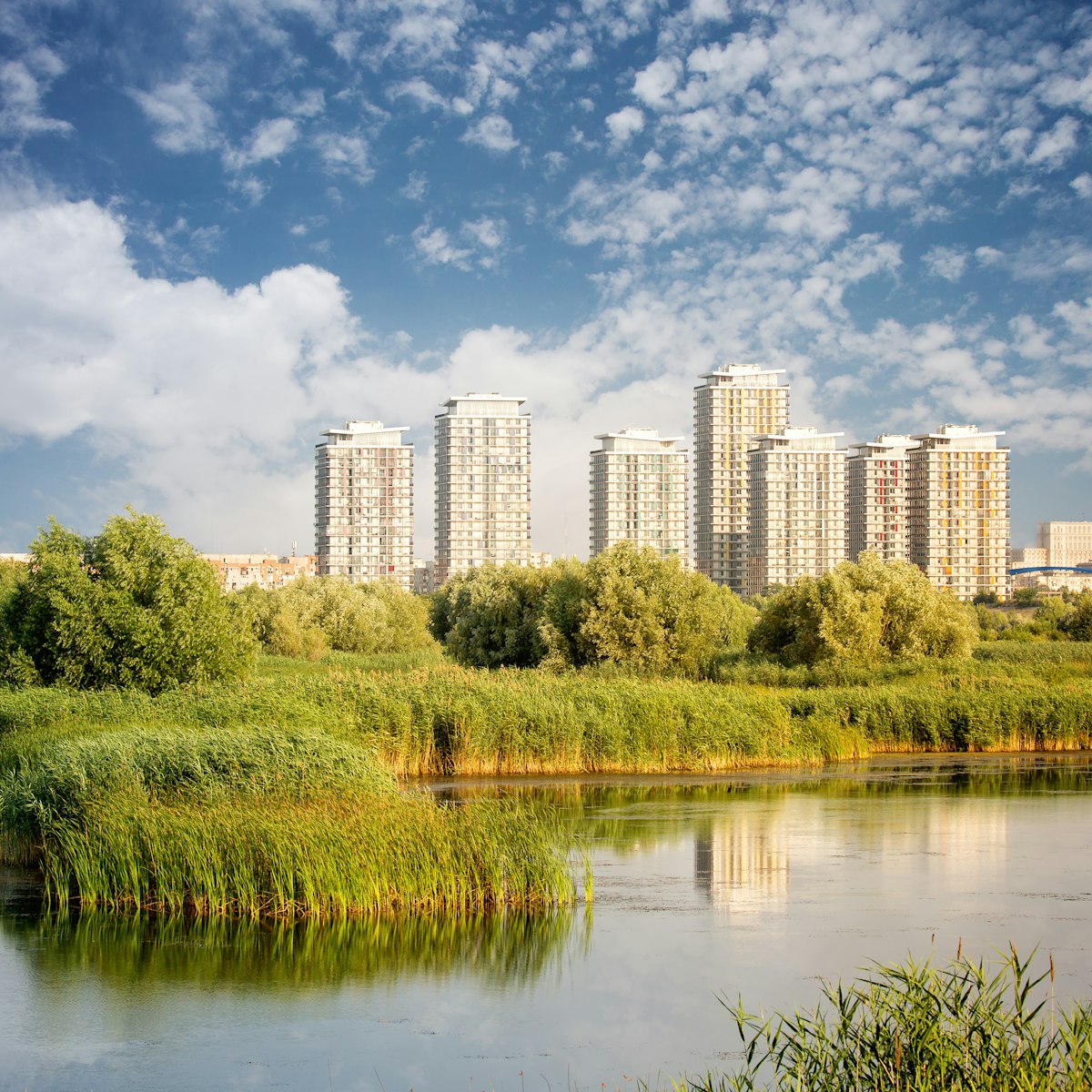
Văcărești Nature Park
What was supposed to be a 6km-long dam during the communist era, left abandoned after the 1989 Revolution, turned over 22 years into a vast urban delta…
Latest stories from Bucharest
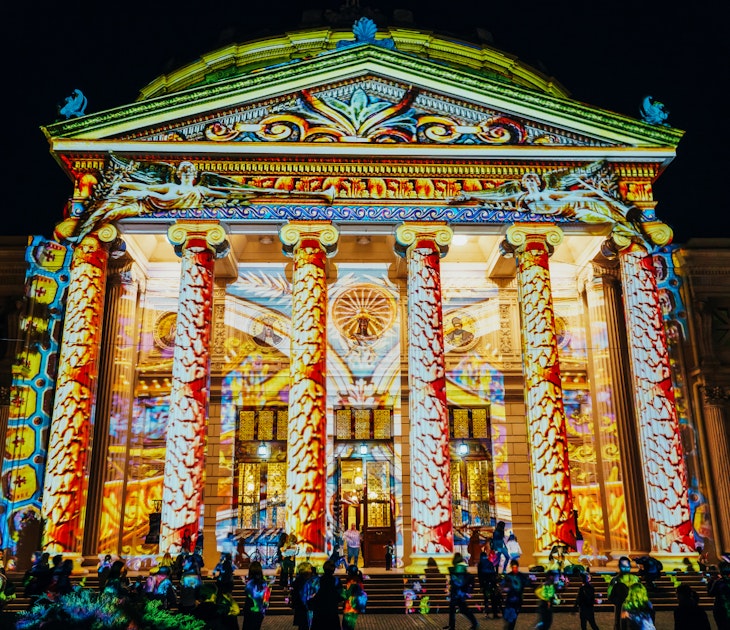
Festivals & Events
Apr 17, 2019 • 6 min read
Planning a trip to Bucharest but not sure when’s the best time to visit? From April to September, Bucharest becomes a stomping ground for the creative…
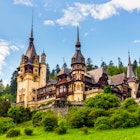
Apr 15, 2019 • 5 min read
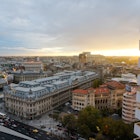
Dec 5, 2018 • 6 min read
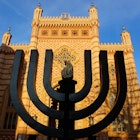
Dec 20, 2017 • 5 min read
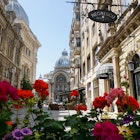
Nov 3, 2017 • 5 min read
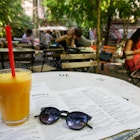
Aug 8, 2017 • 4 min read
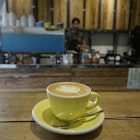
Jan 13, 2017 • 6 min read

Oct 5, 2016 • 5 min read
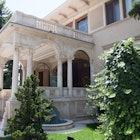
Jul 19, 2016 • 5 min read
in partnership with getyourguide
Book popular activities in Bucharest
Purchase our award-winning guidebooks.
Get to the heart of Bucharest with one of our in-depth, award-winning guidebooks, covering maps, itineraries, and expert guidance.
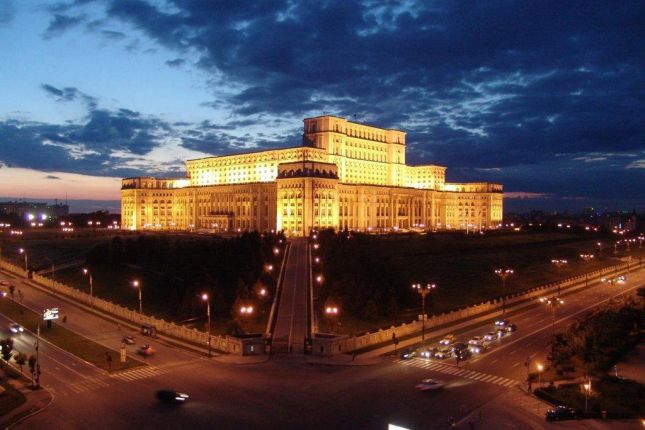
2024 FULL Bucharest Travel Guide: what to do, places to visit, day trips, going out & more!
Why visit Bucharest? Because Romania’s capital will surprise you with its rich history and multiple personalities: a Balkan vibe with Oriental influences, French-inspired beautiful buildings, megalomanic communist architecture, huge green spaces, and now a thriving Western-inspired city with Latin blood in its people.
Bucharest is an eclectic city - and that's the top reason why you should visit in 2024!
This made by locals guide updated in January 2024 will help you find out what to do in Bucharest, which places to visit, top tourist attractions, day trip ideas, where to go out, and practical info about public transport.
You'll find 50+ ideas for the very best things to do in Bucharest and unique tours and day trips we created so you have a great time on your holiday - so get ready!
Table of contents
Intro: Bucharest at a glance
Landmarks in bucharest, 1. take a walk on calea victoriei, 2. admire the george enescu museum, 3. visit the romanian athenaeum, a cultural landmark, 4. get royal at the national museum of art, 5. a first step into romanian history at the statue of king carol i, 6. take a look at bucharest’s weirdest statue, the rebirth memorial, 7. step into communist history at the former communist party headquarters, 8. admire the art deco architecture at the odeon theater, 9. visit one of the oldest buildings in bucharest, casa capsa, 10. take a look at the national military circle, 11. take a walk through the beautiful macca-vilacrosse passage, 12. admire cec palace, 13. learn about the dacians at the national museum of romanian history, landmarks in bucharest old town, 14. visit the old princely court ruins, 15. step into romanian traditions at hanu’ lui manuc, 16. discover the unique romanian architecture at stavropoleos church, 17. check out the impressive national bank of romania, 18. feel the atmosphere on lipscani street, 19. visit the beautiful carturesti carusel library, 20. visit one of the oldest restaurants in the country: caru’ cu bere, what to visit in bucharest: tourist attractions, museums, and more, 21. palace of the parliament: bucharest’s top tourist attraction, 22. step into ceausescu’s villa, 23. visit the national museum of contemporary art, 24. a museum for the whole family: grigore antipa natural history museum, 25. make a stop at the museum of art collections, 26. explore traditional romanian houses at bucharest village museum, 27. discover romanian rural culture at dimitrie gusti national village museum, 28. challenge your perception at the museum of senses, 29. visit the special museum of romanian records, 30. look at the stars at the astronomic observatory vasile urseanu, 31. discover the 1920s bucharest at the little paris museum, 32. be a scientist at the romanian science experiment museum, 33. step into a communist apartment.
- Things to do in Bucharest: sightseeing, history, culture & local life
34. Check out the Romanian Arch of Triumph
35. go for a walking tour around soseaua kisselef, aviatorilor, and calea dorobanti, 36. get lost in the cotroceni neighbourhood, 37. discover bucharest street art, gentrification, and local culture, 38. relax in cismigiu park, 39. admire the parliament building from izvor park, 40. go to the ww i memorial at carol park.
- 41. Take a walk in Bucharest's biggest park, Herastrau Park
42. Go to the vibrant Tineretului Park
43. natural diversity in the heart of bucharest: delta vacaresti.
- Day trips & tours from Bucharest
44. Go on a Transylvania tour from Bucharest
45. discover the impressive transfagarasan highway, 46. visit the romanian coast, 47. discover a unique place: the danube delta, 48. take on your hiking boots and discover the romanian mountains, 49. taste the romanian wine in the dealu mare region.
- 50. Connect with the locals at Obor Farmer's Market
Explore Bucharest by bike, starting in Piata Victoriei
Where to go out in bucharest: restaurants, coffee shops, and bars, bucharest nightlife the best in europe.
- Budget, transport & safety in Bucharest
Where to stay in Bucharest
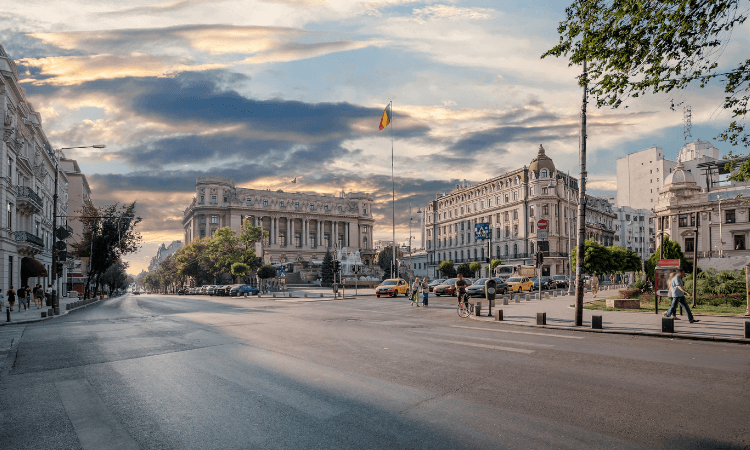
Before we start, I want to be honest with you: Bucharest doesn't have a good reputation as a tourist destination, and here's why:
- like all of Romania, there's no official tourist identity or strategy so tourists don't have a good reason why they should visit in the first place, even for a short time!
- local authorities don't support, invest, or promote local tourism, so it's up to locals with limited resources and fragmented impact to do this
- most tourists rely on foreign travel bloggers, guides, and the typical TripAdvisor "best places to visit" when planning their visit, so they don't really discover what makes Bucharest interesting and worth visiting
- before 2015 there were some reports about foreign tourists getting scammed by Bucharest taxis and at the airport (no longer an issue) which created a bad reputation for the city; that's no longer the case, and we covered this in our safety section at the end of this guide
And that's why some people avoid visiting Bucharest altogether or plan to spend one day at most before going to Brasov and other parts of the country.
Which is a shame... Though it may seem rough around the edges, the capital city of Romania has something to offer to all types of travelers, especially those looking for an off-the-beaten path non-touristy experience.
So besides the typical tourist attractions and places to visit such as the Palace of Parliament and the Old Town area, in this guide, we'll tell you about many lesser-known things to do in Bucharest and how to have a great time visiting Romania's capital.
Because Bucharest is full of glaring, sometimes absurd contrasts and not your typical Western capital where everything is neat and clean, by the book. Some people don't enjoy these urban jungles. Others - like me - do! But, as they say, beauty is in the eyes of the beholder :)
- Local tip: Bucharest is not flooded with tourist hoards like other capitals in Eastern Europe. Prices are not too high either and there are no 'big bus' style tours (except for Dracula Castle day trips - the only thing heavily touristified in our country). So you can have an amazing holiday with great value for money!
Also - the Romanian capital has A LOT of cool places to go out with many hipster cafes, trendy bars, chic restaurants, fine-dining spots (for very good prices!), urban gardens and skybars.
And - most importantly - Romanian people are welcoming and eager to show you a good time! If this is your first time, check our guide on how to visit Romania with more practical info.
View this post on Instagram A post shared by Bucharest | București (@discoverbucharest)
Just like any other capital, Bucharest has a list of top places to visit and famous landmarks, which we will discuss in detail in the following sections. Thanks to its long and wide boulevards the best way to see Bucharest landmarks is to go on a long walk from the Northern Piata Victoriei (Victory Square) to the Southern Piata Unirii (Union Square) or Piata Parlamentului (Parliament Square) - or in reverse.
View this post on Instagram A post shared by My Bucharest (@my.bucharest)
Calea Victoriei (Victory Boulevard) is the main pedestrian artery that connects the major two poles of our city. With a length of 2,7 km and lots of photo stops, high end shops as well as local, vintage ones, coffee shops and snacks boutiques - this will be a 1-2h walk.
Dating from 1692, this boulevard has always been the beating heart of the city and lots of historical events took place here. It's where major Romanian figures, politicians and 'who's who' in our history lived.
That's why you'll see many of Bucharest most famous landmarks, tourist attractions and impressive Romanian buildings here -without having to check Google Maps every 10 min :)
- Local tip: during Summer weekends Calea Victoriei is closed for cars and turns into a huge pedestrian area. Locals love going on long walks, stopping for ice cream, coffee, or a drink. Lots of street events take place here too, so watch out!
If you start your walking tour of Victory Boulevard from the North (from the metro station), one of the first landmarks you'll come across is the George Enescu Museum. This is where our country's most famous classical compose, George Enescu, lived. His work blends classical music with traditional Romanian folk sounds, motifs and instruments. Check out one of his most famous works:
Every year in September the George Enescu International Music Festival takes places in his honour in Bucharest. Orchestras from all over the world concert in the city and classical music fans rejoice.
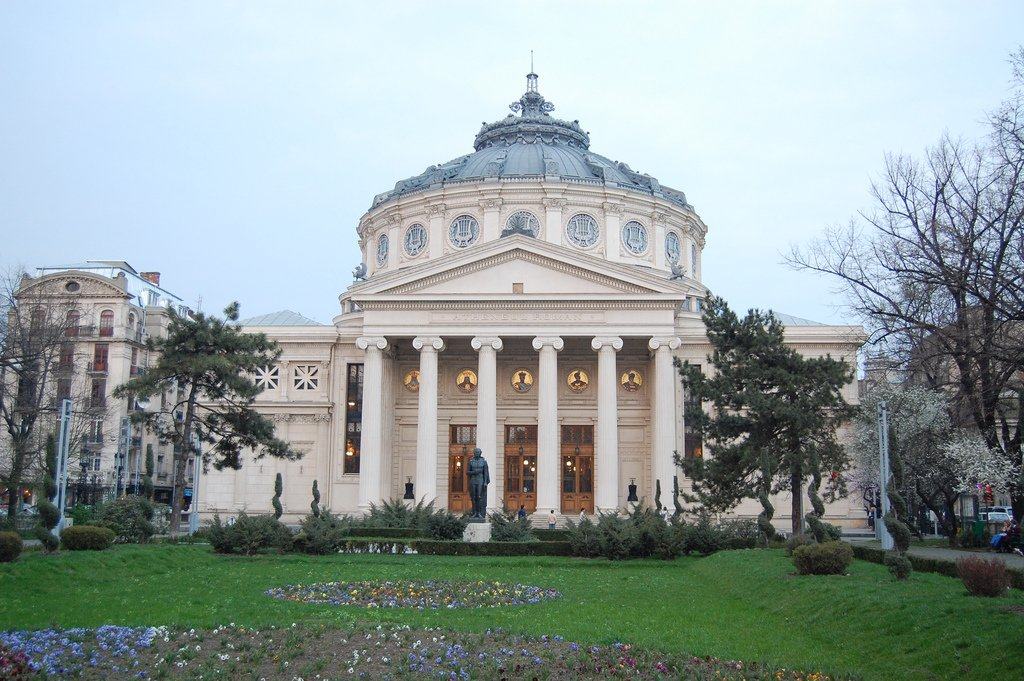
Romanian Athenaeum: more than a concert hall, a landmark of historical significance
The Romanian Athenaeum is Bucharest's most emblematic cultural landmark and concert hall. The building has a lot of significance for Romanian history and is spectacular on the inside, which is why you should visit .
While on Victory Avenue and just across the Romanian Athenaeum you'll see the former Royal Palace, which now hosts the National Museum of Art of Romania. Besides the art collections, the museum of the palace is worth visiting too.
Opposite the National Museum of Art, you'll notice the statue of King Carol I the first king of Romania and a significant figure in our history. The bronze statue weighs 13 tons and stands at a total height of 13 meters, with the actual statue measuring 7 meters and the plinth 6 meters.
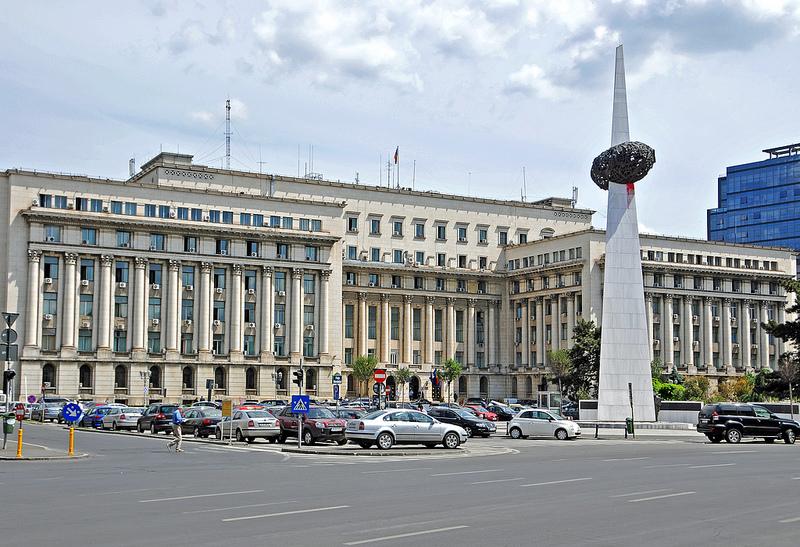
Revolution Square known as Palace Square before the 1989 Romanian revolution
By now you probably noticed the weird-looking statue that looks like an impaled potato as locals call it. That's the Rebirth Memorial in Revolution Square where the 1989 anti-communist revolution took place.
The massive building behind the Rebirth Memorial was the Romanian Communist Party headquarters.
From its balcony dictator Nicolae Ceausescu made his last speech on 21 December when people started booing him - to his incredible disbelief captured on video. This is where the violent 1989 Romanian revolution started in Bucharest (it first started on 16 Dec in Timisioara).
Continuing down South on Calea Victoriei, you will see Odeon Theater on the left, a cosy contemporary art deco building fit for the modern, avant-garde plays it hosts.
On Calea Victoriei, you can also see one of the oldest historical buildings in Bucharest, Casa Capsa (Hotel Capsa), built in the mid-19th century. This is one of the most famous hotels in Bucharest and a walk through its lobby is worth it.
It's also said to have the best pastry shop in town - as you pass the building make a left on the side street and look for the sign.
Where Calea Victoriei crosses Elisabeth Boulevard leading down to Cismigiu Gardens, you'll come across the impressive Palace of the National Military Circle.
Built in 1911 in the French neoclassical style, this building is now recognized as both a historical and architectural monument, and there's a small military museum you can visit on its left side.
Further down on Calea Victoriei you'll come across the late 19th century Macca-Vilacrosse Passage which connects this thoroughfare with Bucharest Old Town.
Inside the passage you'll find lots of sisha cafes and restaurants - and don't forget to look up and see the glass ceiling.
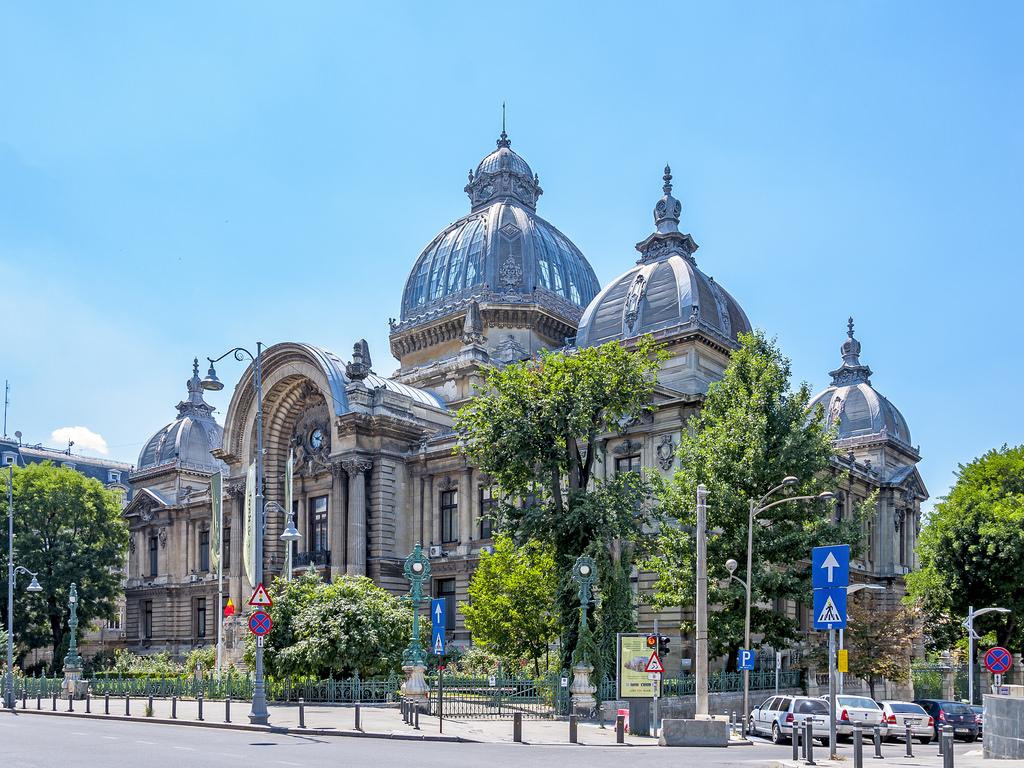
CEC Palace, one of the most beautiful buildings in Bucharest, epitomizes the city's Little Paris identity with its impressive eclectic architecture.
Crowned by a glass and metal dome, the entrance showcases an arch supported by composite-style columns. Sadly, this one can't be visited, but you can still gaze at it from the street.
The impressive National Museum of Romanian History is one of the best places to learn about our ancestors, the Dacians, who settled these lands before they were conquered by the Romans. You'll also see 2,000-year-old gold bracelets made by them ***
Bucharest Old Town is a pedestrian area in the city centre between Piata Universitatii, Piata Unirii and Calea Victoriei. It's filled with old buildings (obviously!) some restored, others not so much, and cobblestone streets.
- Local tip: contrary to what most foreign travel bloggers and guides will tell you, this is not the place to discover the Little Paris side of Bucharest; keep reading to find out the best place for that!
Over 120 bars, coffee shops, and restaurants are here so this central location is known as the hotspot for Bucharest nightlife.
This is not a place for shopping and because of the constant noise and agitation it's not a great place to stay either. There are a few hotels in the area such as Hilton Garden Inn or Europa Royale - but they're very expensive and mostly filled with tourists who think they're staying in the city centre.
Curtea Veche or the Old Princely Court was built as a palace or residence in 1459. This was the seat of power for the ruling princes of Wallachia, including Vlad the Impaler, also known as Vlad Dracula, who built it and whose statue you'll find nearby.
The nearby Hanu’ lui Manuc (Manuc's Inn) is one of the oldest historic buildings in the city with its impressive courtyard and very good traditional Romanian restaurant.
It always functioned as an inn for locals, travelers and merchants passing the city and with business at the Old Court, and legends have it this is where most deals and political decisions were made.
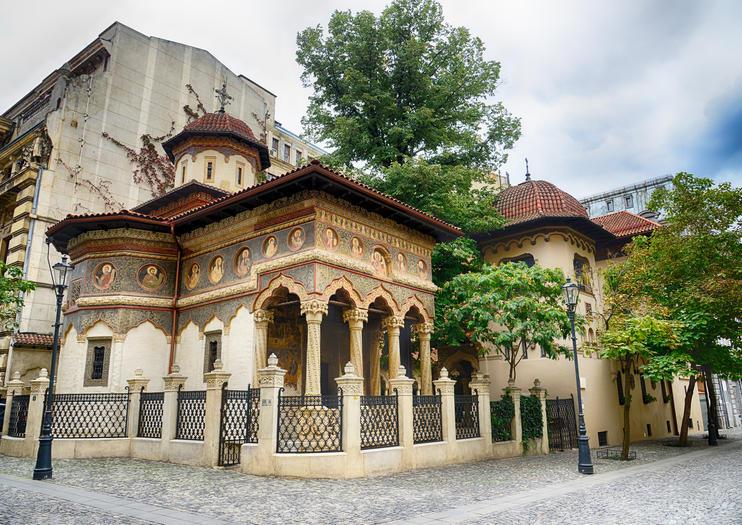
Stavropoleus Church, the oldest church in the Old Town
Stavropoleos Church is built in the unique Romanian architectural style known as Brancovenesc or Wallachian Renaissance and is one of the historic sites of Bucharest.
It has special features like covered balconies with columns carved in flower designs, detailed door and window frames, and the use of columns inside. Go inside - just remember to be respectful!
The National Bank of Romania building is another architectural landmark worth spending a few minutes on. With its imposing Reinassance architecture dating from the end of the 19th century, the building is like a fortress.
Unfortunately, you can only admire it from the outside.
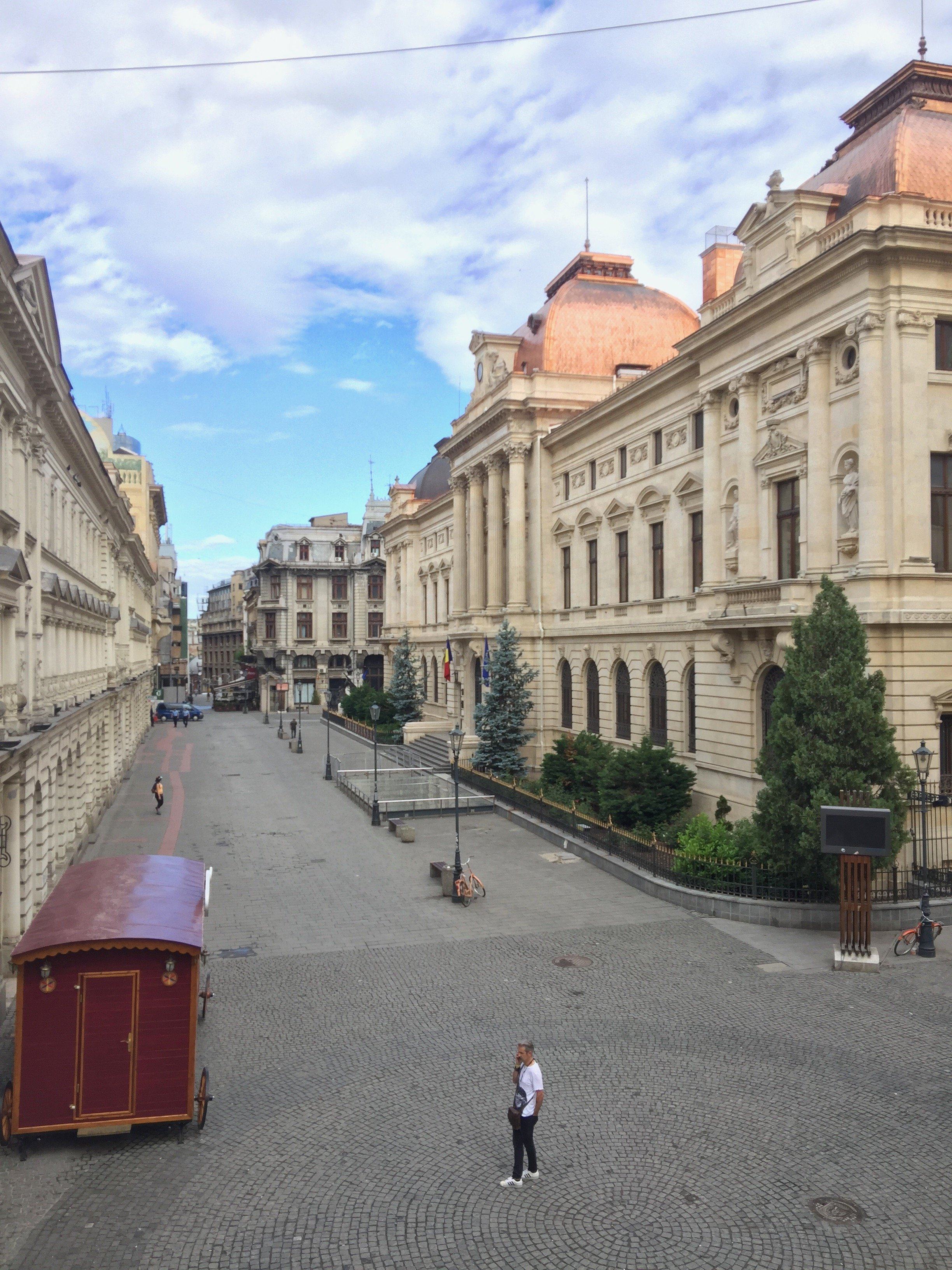
Lipscani Street is not an attraction per se - it's just the most popular street in the Old Town. It used to be filled with the finest merchant shops and artisan workshops from all over the country. During the communist regime they were all shut down as they were seen as luxury items, and then the buildings were abandoned and went derelict.
By 2010 this forgotten area was slowly renovated and bars and restaurants started opening here. Gradually it became the favoured going out spot for locals and at night it turns into a real party center.
The Carturesti Carusel library is on Lipscani Street, and is one of the most beautiful bookstores in the country and possibly in Europe.
The building was the headquarters of a bank but it's now a great place for book lovers.
Caru cu Bere restaurant is one of the oldest and most authentic in the country. Here, you can savor the tastiest Romanian traditional dishes and enjoy a beer crafted from a unique, original recipe dating back to 1879.
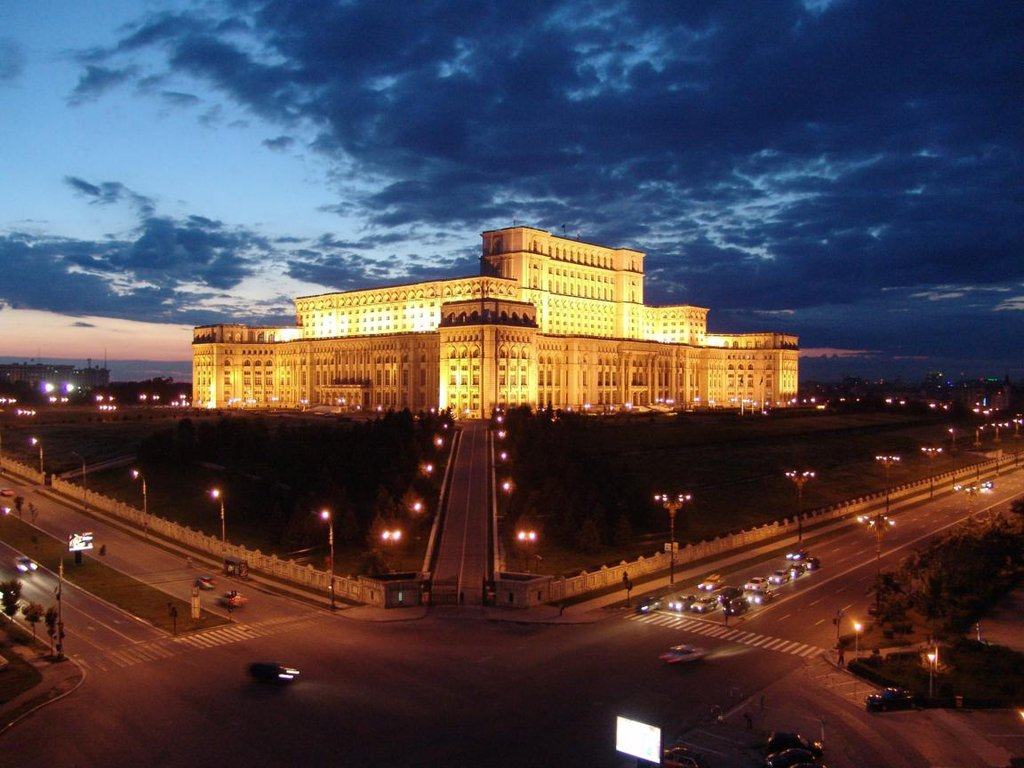
Bucharest extends far beyond the Old Center and Calea Victoriei, which, though popular among tourists, represent only a fraction of the city's complexity. To truly grasp the diverse facets of Bucharest, exploring other landmarks is essential.
When thinking about Bucharest, the massive Palace of the Parliament (with its many aliases: Ceausescu Palace, House of People, House of Parliament, Parliament Palace) probably comes to mind as one of the grand buildings of the Romanian capital city.
It’s the heaviest building in the world and the second-largest administrative building after the Pentagon in the US with a surface of 365.000 square meters! And probably the most famous landmark in Bucharest.
Why tour the Romanian Parliament building? Because you’ll get to see what communist megalomania and opulence can do - and the price people paid to satisfy a dictator’s whims at a time of food and basic supply shortages. A painful reminder for most Romanians...
The massive exterior may look uninspiring but the interior was lavishly decorated with premium materials of 100% Romanian origin: 1 million square meters of marble, a 3t carpet, and a 5t crystal chandelier among others.
As one of the top things to visit in Bucharest but also an administrative building - a parliamentary palace! - it’s important to plan your visit in advance.
- Local tip: visits to the Palace are led by an official tour guide who talks about the building without saying anything about Romania's communist past, Nicolae Ceausescu, or the 1989 Romanian revolution; so if you're interested in learning more about that you'll need to go on a private, communist-themed tour with a specialist local guide.
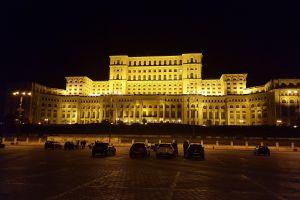
Complete Bucharest Communism Tour: Palace of Parliament & Ceausescu's Home
Start from: Bucharest
Ceausescu's Villa (where he lived) is another tourist attraction that you can visit. This is one of the best places to see the huge discrepancy between the dictator's luxurious lifestyle while the Romanian people were queuing for basic foods and necessities in the '80s...
- Bucharest museums: the classics & cool
As the capital of Romania, Bucharest has the standard collection of national museums - and they’re very good and a nice thing to do if you have a particular interest in their subject or the weather is not great for an outdoor free walking tour.
The National Museum of Contemporary Art is located in a new glass wing of the Palace of the Parliament. The museum presents four floors of exhibitions and events throughout the year. At the top, you'll find an observation point with panoramic views of Bucharest.
Grigore Antipa Natural History Museum has reconstructed dinosaur models that children will love, so that's a fun thing for families to do.
The Museum of Art Collections is on Calea Victoriei just before the Romanian Athenaeum concert hall and is among the best places for art connoisseurs to visit.
My favorite place to visit is the Bucharest Village Museum because of its unique character: an open-air museum where you can find over 60 real-size replicas of traditional Romanian village houses from 36 regions and parts of the country.
The Dimitrie Gusti National Village Museum regularly hosts exhibitions and events to promote Romanian rural culture. It will give you a taste of what the famous Romanian countryside looks like especially if you're not spending a long time in our country on this occasion :) Bucharest also has of the most unconventional and interesting museums in Romania .
The Museum of Senses is a quirky and very cool experience with optical illusions. This is a great place for both kids and adults.
The Museum of Records hosts world-record collections of peculiar items. It lets you explore forgotten parts of human history and see how clever people were at different points in time.
The Astronomic Observatory Vasile Urseanu will thrill kids and passionate astronomers. Here, you can visit a permanent exhibition but also look at the stars and planets through a telescope.
The Little Paris Museum will help you understand why Bucharest was once called Little Paris, and get a glimpse of life in the capital in the 1920s.
The Romanian Science Experiment Museum is a wonderful destination for both kids and adults, where you need to press buttons, pull levers and make things work.
In Romania’s capital you’ll also find a communist apartment from the 1970s turned into a time-capsule museum. A typical Romanian worker family lived here and the apartment is preserved in its original state with objects, decorations, and food from past times. This is probably the best place to understand what life was like during the Romanian communist regime.
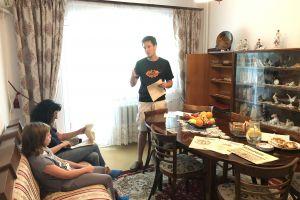
Museum of Communism: A Time-Capsule of Ordinary Lives
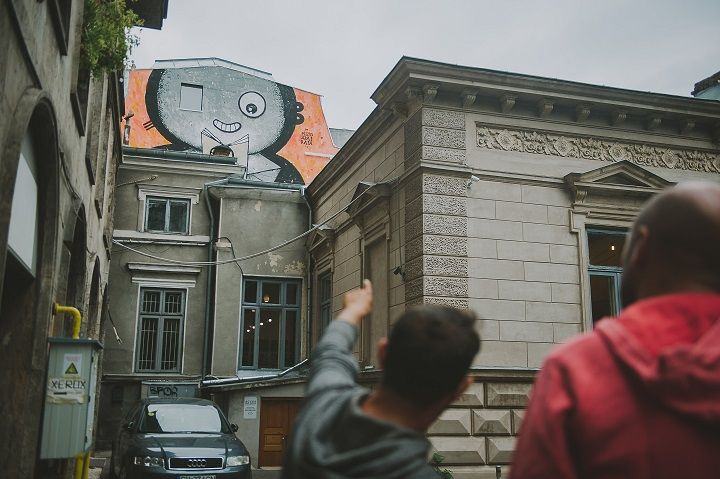
Things to do in Bucharest: sightseeing, history, culture & local life
We're done with classical tourist sightseeing - so let's see some of the lesser known, thematic things to do in Bucharest so you have a good time.
- Romanian history and Bucharest landmarks
The three historical provinces that make up Romania (Wallachia, Moldova, and Transylvania) each had their capital (Bucharest, Iasi, and Transylvania), political life, culture, and powerful families. But the Romanian dream was always to unite in one state.
This happened in 1859 when the first two united and in 1918 Transylvania joined. However, not all Romanians are happy about Bucharest being their capital or see it as representative of Romanian national identity and culture.
That's why knowing a bit of Romanian history will give you more context about the tourist landmarks and historic buildings in Bucharest.
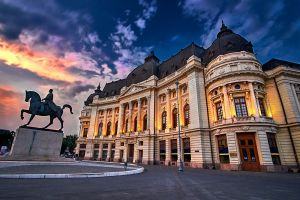
Essential Walking Tour of Bucharest: Old Town & Revolution Square
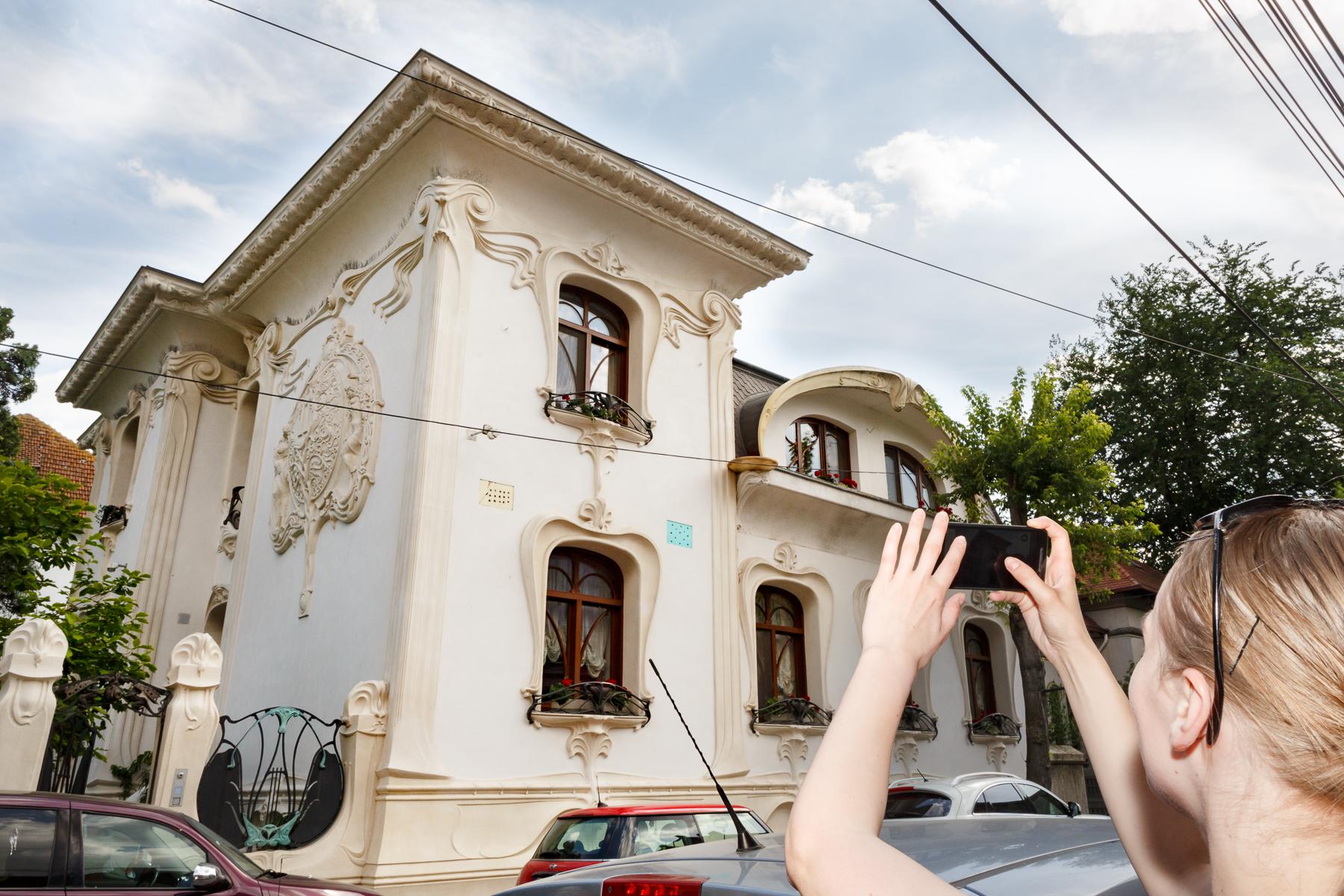
- Bucharest Little Paris and Belle Époque architecture
In the early 1900s Bucharest earned its nickname of Little Paris thanks to French-inspired Belle Époque buildings, monuments, and beautiful architecture.
That's because most of the Romanian aristocracy, rich businessmen, and major cultural figures from the 18th-20th century were educated in France and inspired by the culture and life there.
This made Bucharest unique in Eastern Europe, unlike other European capitals in the region such as Sofia, Budapest, or Belgrade. The rich history of Bucharest and its architecture Belle Epoque architecture was significantly influenced by this.
So if you think Bucharest doesn't have nice places to visit you couldn't be more wrong! There are entire neighborhoods and streets where you'll find a unique blend of architectural styles made even more charming with time.
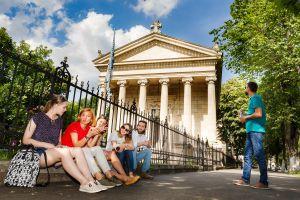
The "Little Paris" Bucharest: Architecture, Old Houses & Bourgeois Stories
Start from: University Square
Bucharest is very popular for its rich blend of historical (neo-classical), interbellum (Bauhaus and Art Deco), communist, and modern architecture mix. Many of the city's best hotels, companies, or best restaurants occupy some incredible buildings - monuments of architecture.
The Arch of Triumph (Arcul de Triumf) is a WW I memorial monument, though smaller than the French version, is proof of this cultural affinity. If you are in Romania on December 1st or November 24th, you can watch the military parade here.
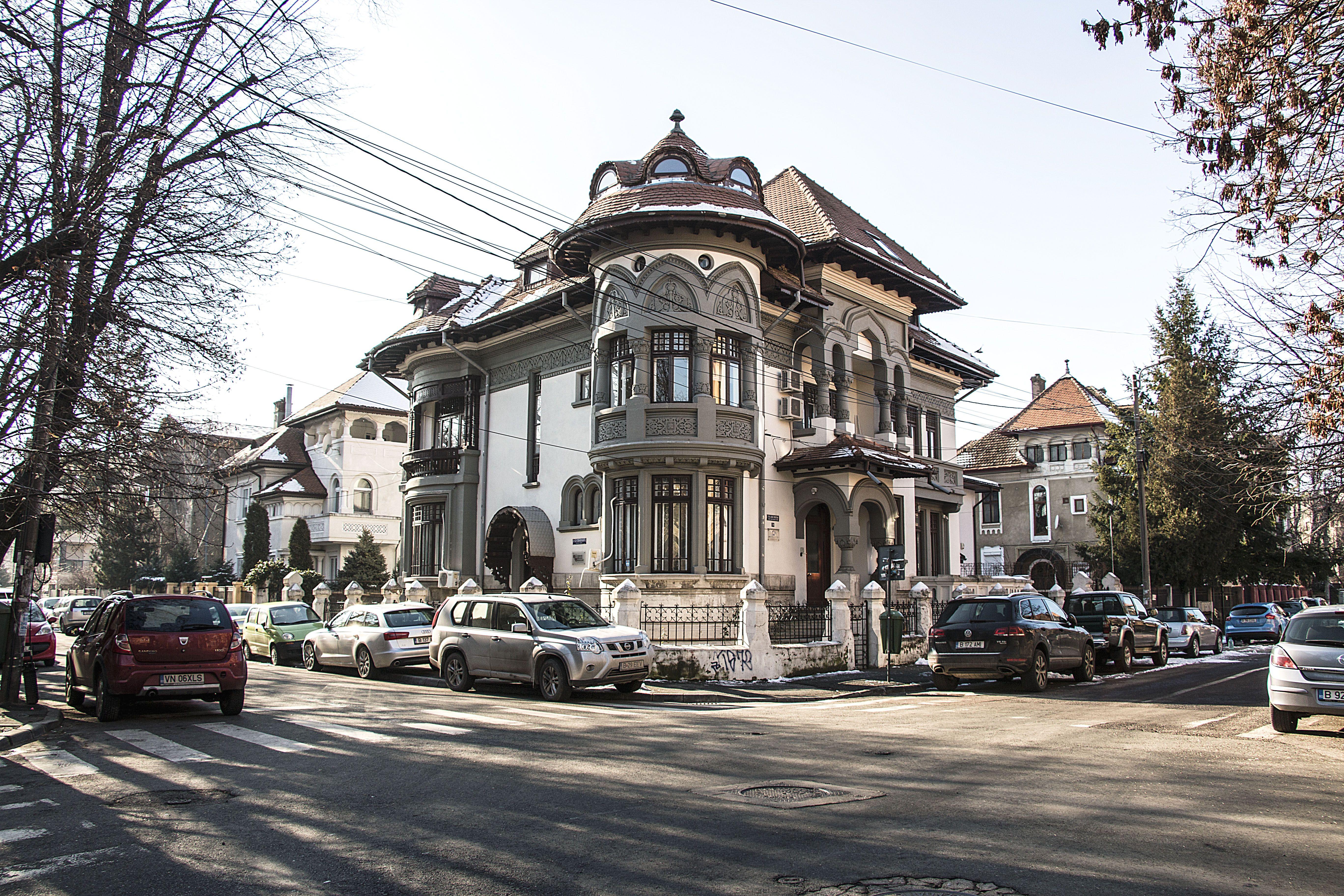
Cotroceni neighbourhood, one of the most beautiful in Bucharest
Just go for a walking tour aka get lost in the area between Soseaua Kisselef, Aviatorilor Boulevard, and Calea Dorobanti to understand the Bucharest’s beautiful blend of cultures. Also around Gradina Icoanei Park. Unfortunately these are not tourist attractions per se so without a local tour guide to take you deep into the neighbourhoods and show you around, it will be hard for you to find these spots on your own.
The Cotroceni neighbourhood is known for its superb eclectic architecture, the botanical garden, and beautiful buildings.
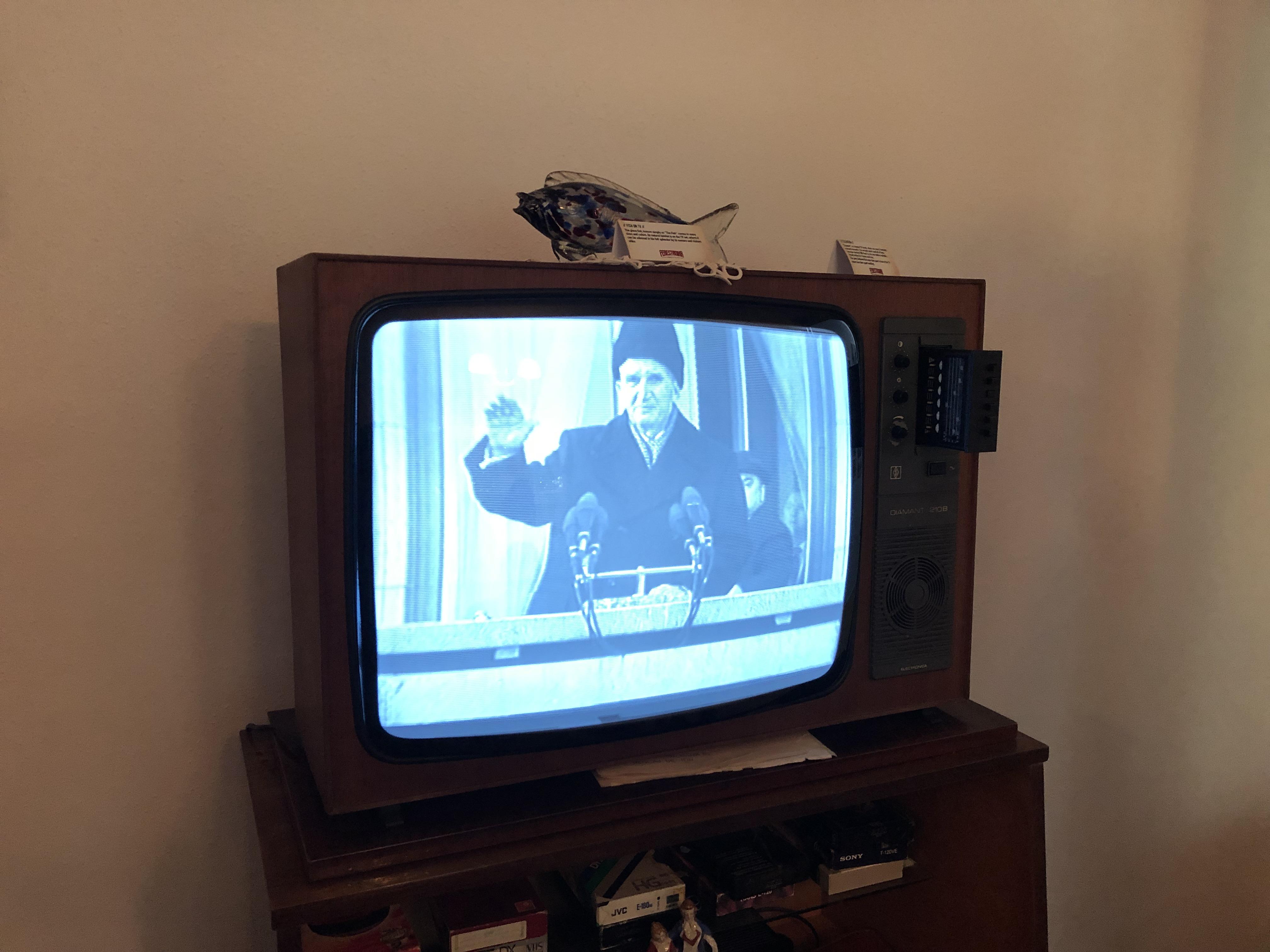
Visit a typical communist apartment in Bucharest turned time-capsule museum
- Communist Bucharest: forced transformation
Bucharest bourgeois identity was literally demolished and transformed during the Romanian communist regime which ruled from 1944-1989 (Romania was not part of the USSR!).
But besides the ideological agenda, dictator Nicolae Ceausescu who came to power in 1965 and ruled for 25 years (making him one of the most famous Romanians ) had bigger ambitions...
Driven by megalomanic dreams, a personality cult, and absurd realities, Ceausescu brutally changed Romanian society and turned Bucharest into an experiment for his idealistic communist vision. So:
- an entire neighbourhood was demolished to make way for the Palace of Parliament
- wide boulevards such as Unirii, Magheru, and Aviatorilor were built (and there's a specific reason for that!)
- churches were literally moved or 'hidden' by apartment buildings
- entire worker neighbourhoods were built from scratch to house factory workers relocated here from the rest of the country
And much more. Bucharest was painfully transformed with significant consequences not just for its architecture, but also for its culture and local life.
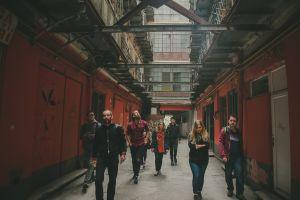
Untold Stories of Bucharest: Prostitution, Holocaust and Communist Terror
Start from: Piata Romana (Romana Square)
All over the city there are signs of this transformation. One of our specialist communist tour guides will show them to you on a walking tour, including pictures from old times, and tell you more about life back then.
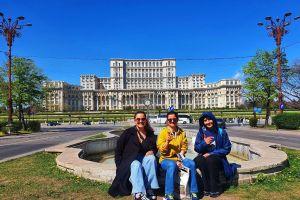
Communist Walking Tour: History, Megalomania & Hidden Sights
Start from: Revolution Square next to the Rebirth Memorial (The patatoe)
After the Little Paris years, the communist transformation and the Western re-vitalisation - many parts of Bucharest started showing glaring contrasts. A vibrant and exotic street art showed up to cover the uglier parts of the city, especially in the local neighbourhoods where foreign tourists don't venture and locals rarely go.
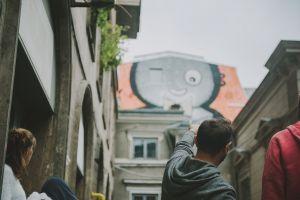
Bucharest Street Art & Architecture Tour
This is the reason why one of the best things to do in Bucharest is to go off-the-beaten path and explore local life beyond the top attractions and tourist hotspots.
the famous Bucharest 3D iMapp competition There are also lots of events going on - check online or ask a local when you're here. Various exhibitions, sports competitions, street food or art fairs happen throughout the year, usually in front of the Romanian Athenaeum, in Piata Universitatii, or on Calea Victoriei.
- Relax in Bucharest’s many green spaces
If you’re getting tired of so much urban exploring, many beautiful parks in Bucharest will help you disconnect from the hustle and bustle of the city.
The most beautiful park in the center of Bucharest is Cismigiu Park on Regina Elisabeta Boulevard. It's sometimes called Cismigiu Gardens because it has many areas with different interests, sights, and cultural significance - so this is a perfect place to take a break from your walking tour of the city!
*Izvor Park*, a relatively small park, is another great place to relax and admire the massive Parliament Building. Here, you can enjoy a short walk in a relaxed setting.
Carol Park has another WW I memorial on a hill with great views. Here, many locals gather to engage in sports activities on the stairs leading to the memorial.
41. Take a walk in Bucharest's biggest park, Herastrau Park
King Michael I park (formerly Herăstrău Park) is the largest park in the city and also the largest park located inside a city in Europe. Spanning 187 hectares, the park has various sections. One favorite spot is the Japanese Garden, known for its beautiful cherry blossoms and Japanese acacia trees with hanging branches.
Tineretului Park is another popular park in Bucharest with a pretty big lake, perfect for a jog, or bike ride, and the right place for renting a boat.
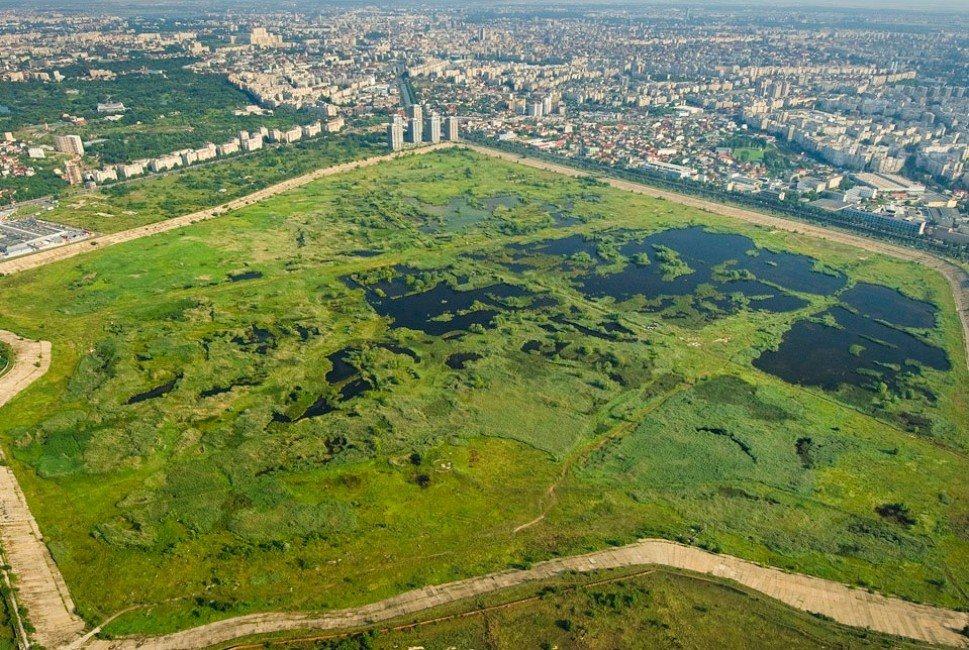
The newest addition to this list of green spaces in Romania's capital is Delta Vacaresti. In the South Eastern part of the city a large area was cleared by the communist regime for a major project - later abandoned!
Over time, Mother Nature reclaimed this area and turned it into a wonderful natural biosphere: a huge park more like a wetland where many species of plants, birds, and small animals now live!
In 2016, Vacaresti Natural Park was granted protected status by law. This is a unique open-air museum of natural diversity in the heart of a European capital and a great place to visit (best time is from April - October) if you want to combine urban sightseeing with nature.
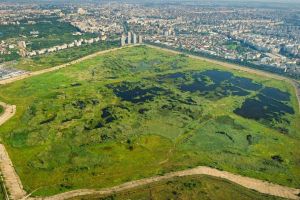
Vacaresti Natural Park: the Newest Urban Delta
- Pro tip: most young people speak good English, are friendly and helpful, especially in the city hotspots, so you don't have to worry about getting lost in translation
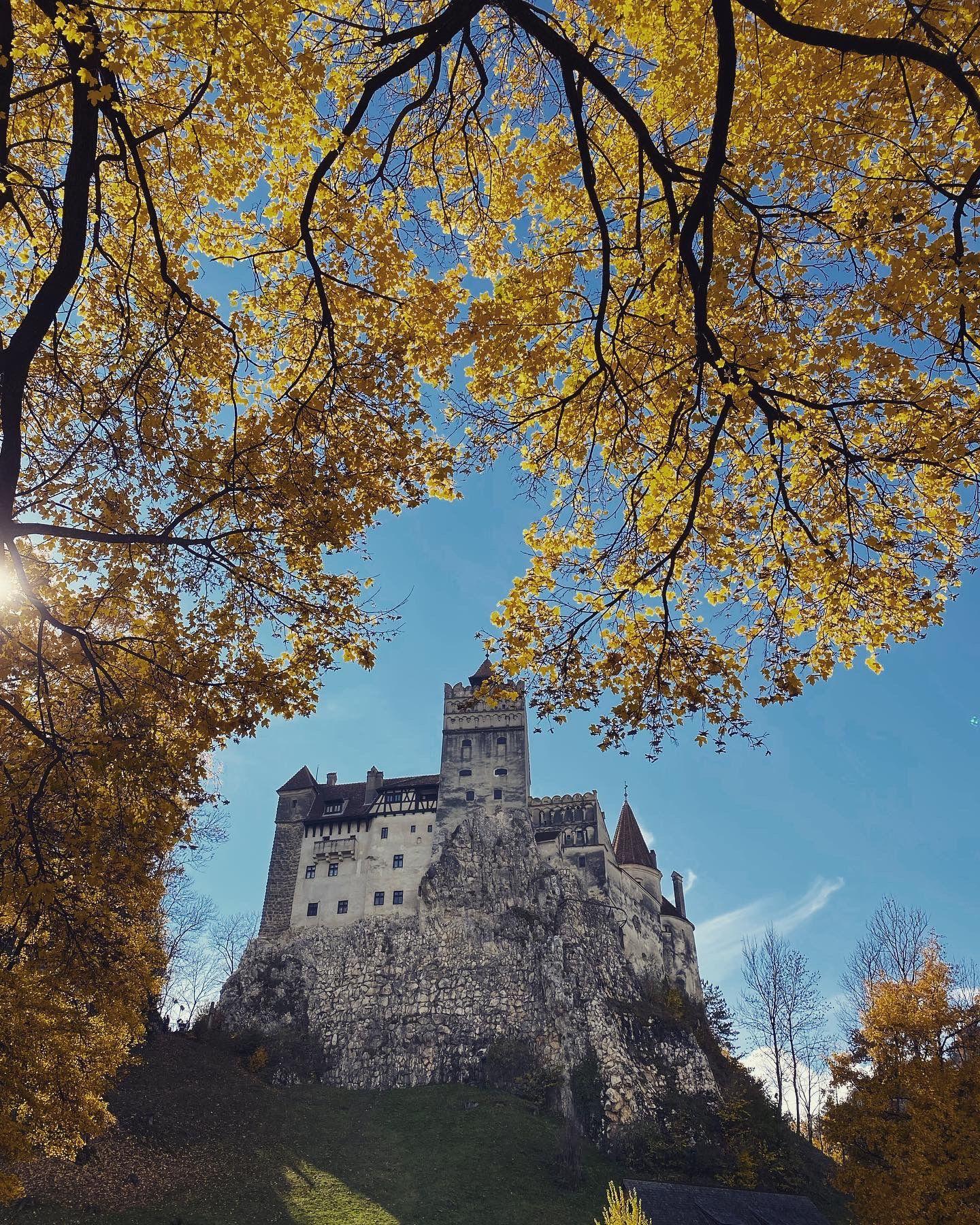
Day trips & tours from Bucharest
Bucharest is a great place to tick off some of the best things to do in Romania . With our network of specialist tour guides we can organise any kind of trip for you - so contact us we're happy to help!
Contrary to what most people think - going on a day trip to visit Peles Castle, Brasov and Bran Castle (the most popular day trip in Bucharest) does NOT mean you visited Transylvania. The region is huge with a history and culture that can't be experienced in one day. Read our blog on how to visit Transylvania for more.
That's why we created a unique 3-day best of Transylvania tour that will give you an authentic experience of this popular tourist region of Romania.
The famous Transfagarasan Highway can also be seen from Bucharest and the best time for that is July - October when the road is open for driving.
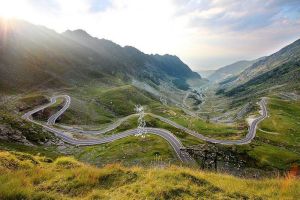
Road trip to Poenari Castle & Transfagarasan Highway
Another popular day trip is to the Romanian Black Sea and the city of *Constanta*. So, if you love spending time on the beach, Constanta is a must while in Romania.
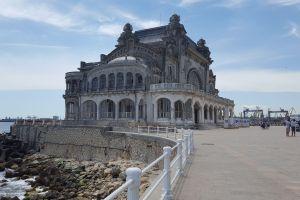
The Black Sea Calling: Day Trip to Constanta & Mamaia Beach
If you want to visit a unique place, the UNESCO Danube Delta reserve is what you are looking for. To visit the Danube Delta, you need to get to Tulcea (4h away from Bucharest, possibly only by car). From there you'll enter the Delta through a boat ride, so you need a minimum of 2-3 days to see its beauty, birds, and fauna.
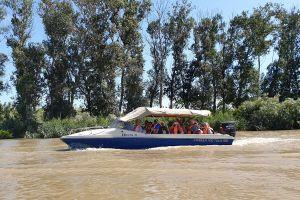
2-Day Danube Delta & Birdwatching Tour from Bucharest
You can also go hiking in the Romanian Mountains known for their wilderness and impressive heights of over 2,500m altitude. Bucegi Mountains are one of the most popular national parks in Romania . The Romanian Sphinx and Babele are major natural attractions tourists want to see when in Bucharest.
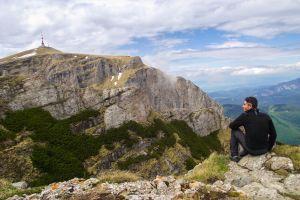
1 or 2 Day Hiking Trip in Bucegi Mountains: Sphinx, Babele, Omu Peak
Start from: Bucharest OR Brasov
But there are a lot more options for hiking day trips from Bucharest - check our guide on the best hikes in Romania .
Just 1,5h away from Bucharest, in the Dealu Mare region, you can find some of the country's best wineries. This is one of the best places to discover the long history and high quality of Romanian wines (#7th producer in the world!) with superb views too!
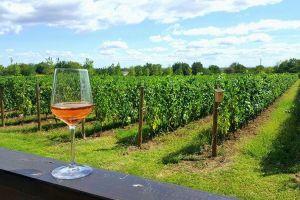
The Wine Tradition of Romania: Premium Wine Tasting in Dealu Mare
Check our full list of unique tours and hand-picked day trips in Bucharest so you have the best time in our country:
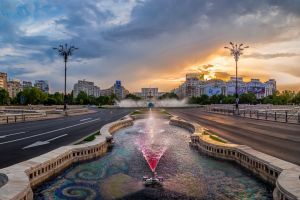
Tours & Day Trips in Bucharest
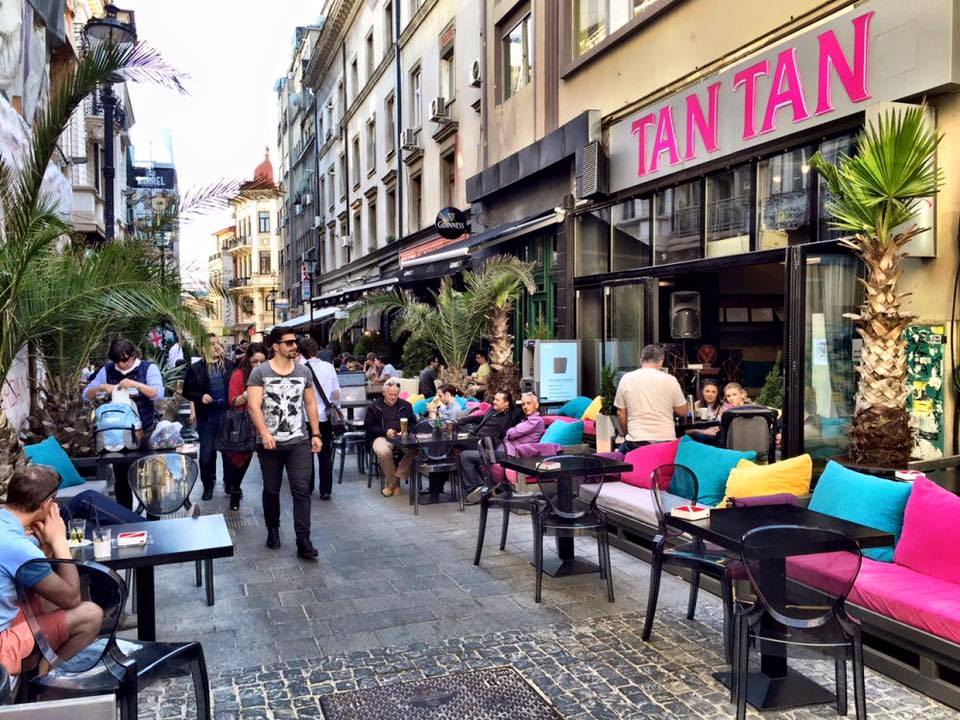
50. Connect with the locals at Obor Farmer's Market
If you're interested in traditional Romanian food and want a true cultural shock, head over to Obor farmer's market the largest and oldest in Romania where small farmers and everyone else sell their stuff. Or go on our tour with a local guide who will show you the best way to experience this:
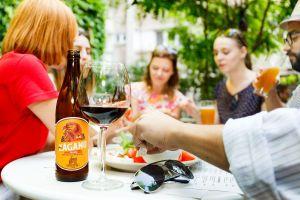
Bucharest Street Food Tour: Farmers' Markets & Hidden Streets
Because of the wide boulevards and long distances in Romania's largest city, renting a bike is a great way to explore Bucharest. Calea Victoriei has a dedicated bike lane so traveling by bike makes everything easier and you get to see much more, especially in the beautiful Northern part of the city (Kisselef and Aviatorilor Boulevard, Herestrau Park, Arch of Triumph).
You can rent a bike on your own from a public docking station (check here ), or go on a guided tour by bike with one of our guides who will take care of everything so you can focus on enjoying the experience AND learn about Bucharest.
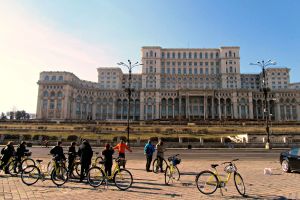
Panoramic Bike Tour of Bucharest
Start from: Bucharest - Hard Rock Cafe
After all these Bucharest attractions and tourist places you’ve visited, you’re probably hungry, looking for the best restaurants in Bucharest, a good coffee shop, or a nice place to go out in the evening. Best places to eat in Bucharest
Romania’s capital is a great - and affordable - place for a food-tasting getaway: lots of variety and international-inspired cuisine, cool places to eat with an inspiring design and fancy menus with a modern twist, fresh locally-sourced ingredients and great customer service. And there are lots of choices for all budget types.
It's hard for me to describe in words just how much Romanian people love to go out (part of our Latin blood!) and why Bucharest has a very diverse and high-quality offering. Here are some suggestions to get you started:
- Romanian traditional food: Zexe, Jaristea, La Mahala, Beca’s Kitchen, Maize (Romanian up-scale), La Copac, Lacrimi si Sfinti, City Grill, Vatra Neamului, Hanu’ lui Manuc, Caru cu Bere
- Italian (the nation’s favorite): Trattoria Don Vito, Grano, Il Peccato, Trattoria Fresca, SARA Restaurant
- British & Irish pub: The Harp, Trafalgar
- Lebanese (as there’s a minority living here): Piccolo Mondo, Zaitoone, Four Seasons, Al Mandaloun
- burger places (always cool): Burger van Bistro, Switch.eat, Vivo fusion bar
- steak houses: Osho, Prime Steaks & Seafood, VacaMuuu
- cool & urban places to eat (modern European): Energiea, Biutiful, Uanderful, Simbio, Lente, Alt Shift
- international fine dining: Joseph, Casa Doina, Stejarii Pool Club, Casa di David, Le Bistrot Francais, L’Atelier
- street food (shaorma - a must!): Calif, Divan, Dristor
- Local tip: vegetarians or vegans should not despair – there are plenty of delicious dishes thanks to Orthodox lent (fasting) periods; read our article on traditional Romanian food to find out more.
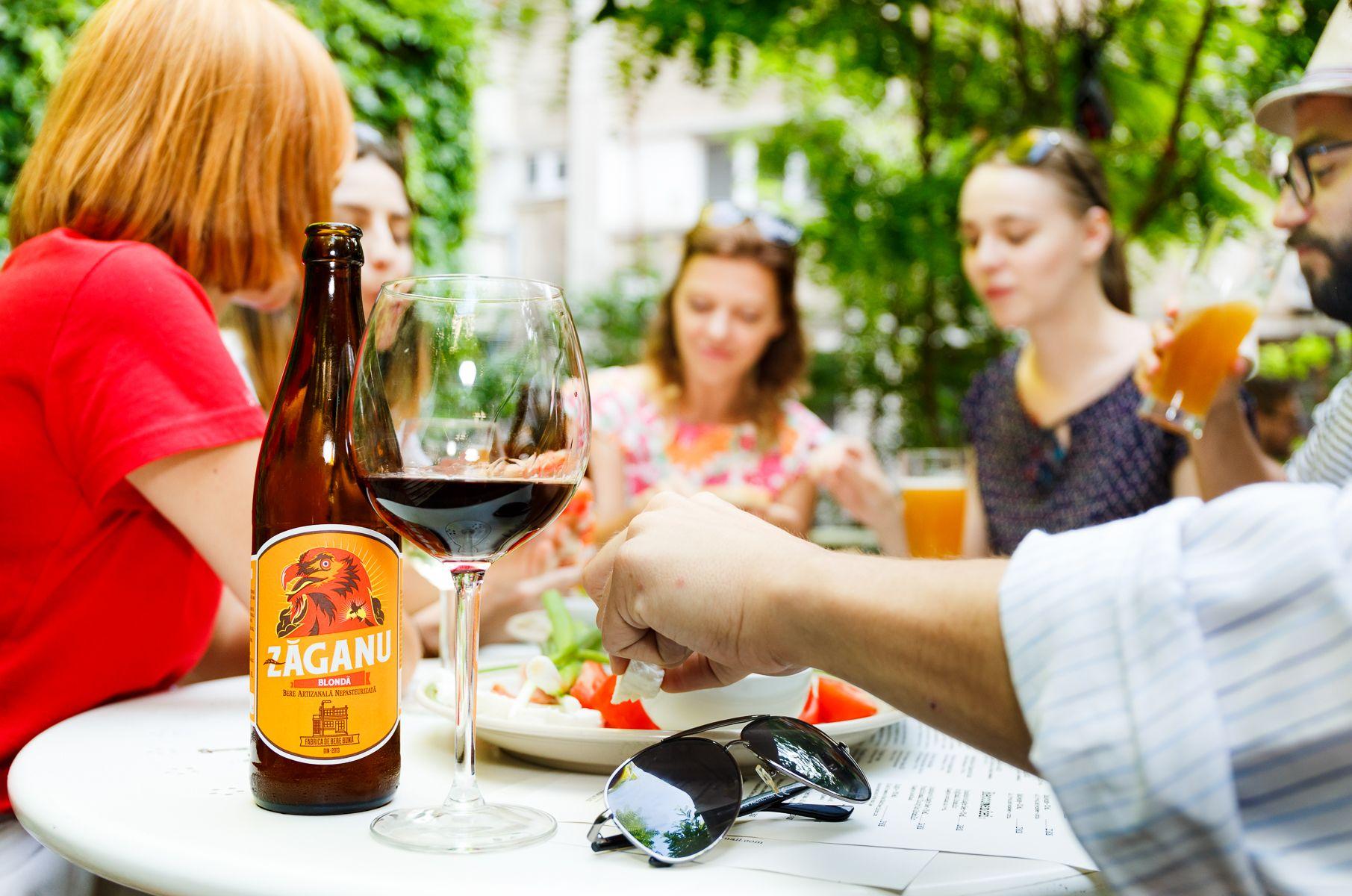
- Romanian beers and wine in Bucharest
First, you should know that Romanians enjoy drinking - a lot! In Southern Romania, most people prefer drinking beer (unlike in Transylvania). Local brands you should try Silva, Ciuc, or Ursus.
Craft beers have been on the rise recently with young looking for new tastes: Nenea Iancu, Zaganu, Hophead, Ground Zero, or Gambrinus. So beer bars have popped up and quickly became favorite places to go out for locals:
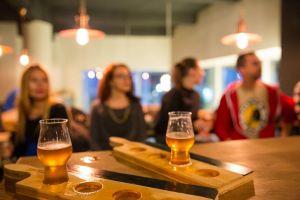
Bucharest Nightlife Tour: Craft Beer & Hip Bars
As for having a surprisingly good glass of Romanian wine in a nice setting - it’s one of the best things you can do in Bucharest! Try Corcova Rose at Entourage, Liliac White Young Fresh at Energiea, or Lacerta Cabernet Sauvignon & Shiraz at Corks Cozy Bar to get a sense of Romanian wines being damn fine! Domeniul Coroanei Segarcea or Prince Stirbey are also very good choices if you see them on the menu. Do not skip dessert and coffee shops in Bucharest
Since 2010, the specialty coffee culture BOOM-ed in Bucharest. So now you have lots of hispter, cosy, or inspiring coffee shops serving single or blended origin, on-the-spot roasted DELICIOUS coffee!
The most popular, old, and famous coffee shop is Origo, but you should also try Coftale, Beans&Dots, Steam, Orygyns, Two Minutes, Garage Cafe, T-Zero, On-Off, or The Coffee Factory. What’s a cortado or V60? Go and find out - and be sure to check our list with the best coffee shops in Bucharest to find out more. Fans of sweets and desserts should definitely consider papanasi (a traditional dish) at Stadio, éclairs at French Revolution, or profiteroles at Chocolat Boutique Ateneu – all of them are local businesses. Or just stop at any street pastry shop and ask for an apple pie (placinta cu mar) or cheese pie (placinta cu branza).
There are several reasons why the Bucharest nightlife is so good and famous - our article will tell you more and also the best bars and places to go out. Or maybe there's a Romanian music festival happening when you're visiting?
Suffice it to say that you should prepare for a long night out and dress well (shirts & skirts) if you want to blend in with the locals. Put on your friendly and relaxed face – don’t give yourself away after the long day you’ve visiting Bucharest! Sip on a few cocktails
Go for an Aperol Spritz on the rooftop at Deschis Gastrobar or any cocktail you can literally think of at Newton Cocktail Bar or Fix Me a drink. For a warm summer evening, I recommend a cider in the garden at Control – a hip cool place to be or a beer at Eden Garden – a let’s-chill-in-the-forest, unpretentious yet vibrant place.
But the trending place right now among Bucharest locals is Expirat, with beautiful green spaces and terraces, cool music, and that great & young Bucharest vibe I was talking about – that’s my last insight for you! The Old Town is a must-experience part of Bucharest nightlife
Some colorful shots at Shoteria are highly recommended before starting the mandatory restaurant - pub – terrace – club crawling in Lipscani Old City Center (Lipscani Centrul Vechi) – a historical area which hosts a great variety of bars, pubs and clubs. I should tell you that in recent years the Old Town of Bucharest has become quite touristy, with too many places, people and tourists in a frenzy looking for alcohol-induced fun.
While I don’t personally like it and some locals avoid it, it’s a must-see part of the vibrant Bucharest nightlife and you won't find anything similar in other European capitals. Looking for a fancy night out in Bucharest?
If you want an even more fancy night out, girls should consider wearing high heels and guys should go for a dress shirt at minimum. The places to go out in Bucharest for proper, high-end clubbing are located in the northern part of the city, in Floreasca or Herestrau area, and are a great choice for a night out warm nights. Consider Biutiful, Fratelli or Funky Lounge (the last two are located in Herestrau Park). Nuba, Tuya, Kayo, and Hiro are fine-dining restaurants turning into clubs as the night starts.
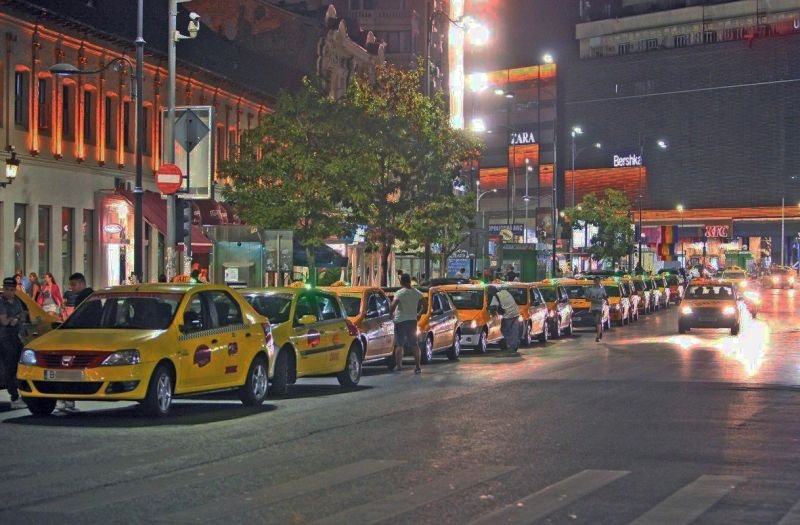
Budget, transport & safety in Bucharest
Check our article on Bucharest public transport with all the info you need about Bucharest Otopeni Airport, public transport in the city, taxis and official tourism infrastructure.
We also prepared a guide on what you need to know about safety in Bucharest because there are a lot of misconceptions about this beautiful city. But with a little information and awareness, you'll have a great time here.
You don’t need to spend much to have a good time in Bucharest
Coming from London, Paris, Milano, or Munich, you’ll be shocked to see how affordable your Bucharest travel budget needs to be! Imagine paying between 6-15 EUR for a main course, appetizer/dessert, and a drink, 2-3 EUR for a coffee, or 4-5 EUR for a fantastic cocktail or a glass of wine in most places. Attraction tickets to museums and other places to visit in Bucharest are usually between 3-5 euros. A reasonable budget per day for visiting the city should start at 30 Euro. Take the metro or a taxi, buses are unreliable
The most efficient public transport is the subway which is quite affordable and convenient: a bit over 1 Euro for 2 rides, 5 Euro for 10. Taxis are also inexpensive with around 2,5 Lei/km (0,5 Euro) but ridesharing apps such as Uber and Bolt are the most popular choice for getting around in our capital. I don’t recommend using buses or trains in Bucharest: besides them being unfriendly for a foreigner, their irregular schedule combined with hectic traffic make them unreliable even for locals!
You've got lots of options on Airbnb or booking.com - check to see what fits your preferences and budget.
The general rule of where to stay in Bucharest is close to a metro station because it's the best, quickest, and easiest way to navigate Bucharest.
For hotels, there will be plenty around Union Square, Cismigiu Gardens, Piata Romana, Piata Victoriei, and Revolution Square. But even if you stay further away you can navigate the city using a taxi and metro.
You'll find all the main international hotel chains (Mariott, Ramada, Hilton, etc), including a selection of boutique, charming hotels in beautiful buildings from the Little Paris era.
Places to visit
- City Travel Guides (5)
- All Tourist Attractions (22)
- Tourist Regions (5)
Check our tours
- By category

4 times a year we prepare a newsletter with local stories, places and our special insights about Romanian culture and local life that will inspire you to visit our country and have an authentic local experience. Would you like to get it?
Follow Romanian Friend on:
#romanianfriend.
Bucharest Travel Guide
Book your individual trip , stress-free with local travel experts
- roughguides.com
- Travel guide
- Itineraries
- Local Experts
- Travel Advice
- Accommodation
Plan your tailor-made trip with a local expert
Book securely with money-back guarantee
Travel stress-free with local assistance and 24/7 support
For many people, initial impressions of Bucharest (Bucureşti), a sprawling, dusty city of some two million people, are less than favourable. It’s Romania’s centre of government and commerce, and site of its main airport, so most visitors to the country will find themselves passing through the city at some point, but its chaotic jumble of traffic-choked streets, ugly concrete apartment blocks and monumental but mostly unfinished communist developments is often enough to send most travellers scurrying off to the more obvious attractions further north. Yet it’s a city that rewards patience, with a raft of terrific museums, first-rate restaurants and bars, and, behind the congested main arteries, some superb architecture and abundant greenery.
Bucharest’s festival calendar
Bucharest’s markets, calea victoriei, the centru civic, drinking and nightlife, entertainment, mogoşoaia palace, the northern suburbs, the old town, piaţa revoluţiei and piaţa enescu, piaţa universităţii, piaţa victoriei, systematization, the fall of the ceauşescus, west of piaţa universităţii.
The architecture of the old city, with its cosmopolitan air, was notoriously scarred by Ceauşescu’s redevelopment project in the 1980s, which demolished an immense swathe of the historic centre – including many religious buildings and thousands of homes – and replaced it with a concrete jungle, the compellingly monstrous Centru Civic . The centrepiece of this development was an enormous new palace for the communist leader, now known as the Palace of Parliament , which is Bucharest’s premier tourist attraction.
The heart of the city is the Piaţa Revoluţiei , the scene of Ceauşescu’s downfall and site of the old Royal Palace – now home to the superb National Art Museum , housing a fine collection of Romanian medieval art. It lies halfway along Bucharest’s historic north–south axis, the Calea Victoriei , which is still the main artery of city life; the city’s main junction, however, is the Piaţa Universităţii , scene of major events immediately after the 1989 revolution. To the south of here lies the scruffy but atmospheric historic centre , which these days owes its popularity to the welter of bars and restaurants crammed into its agreeably tatty streets.
North from Piaţa Victoriei, along the broad sweep of Şoseaua Kiseleff, lie Bucharest’s two best museums – the Museum of the Romanian Peasant , with its marvellous exhibits on peasant life and superbly reconstructed buildings, and the Village Museum , an assemblage of vernacular buildings garnered from Romania’s multifarious regions. There’s plenty of greenery to explore, too – most obviously the tranquil Cişmigiu Gardens in the heart of the city, and the more expansive Herăstrău Park , on the shores of the lake of the same name.
From Bucharest, there are excellent rail and road connections to the rest of the country, but local bus and train services to the towns and villages in the immediate vicinity are often limited or tortuous. There are, however, some enjoyable visits to be had just outside the capital, most notably the lake and monastery at Snagov , the palace at Mogoşoaia and the village of Clejani , known for its outstanding Gypsy music.
Tailor-made travel itineraries for Romania, created by local experts

7 days / from 1944 USD
Relaxing beach fun - the Black Sea Coast in Bulgaria and Romania
The perfect trip for those that are looking for sun, sea and sand while also getting to know the culture and history of both Bulgaria and Romania. Start and end in Bucharest and discover Constanta, Sunny Beach, Nessebar, Burgas and Madara Rider.

8 days / from 1944 USD
The legend of Dracula
Transylvania is known to be the land of Dracula. Are you curious to visit the places mentioned in the book and the castles that hosted the major life events of Vlad the Impaler, the cruel ruler known as Dracula? Explore mysterious places and breathtaking landscapes all over Romania.

12 days / from 3899 USD
Luxurious Highlights of Romania: From Bucharest to Transylvania
Romania offers plenty for the discerning traveller, including beautiful Boutique properties. On this trip, discover Bucharest, the Danube Delta, Bucovina and Transylvania with Dracula's castle. A private guide will accompany you throughout the trip, well-equipped with Romanian knowledge and facts.
Bucharest’s festival scene has been slow to gather pace but there now exists a handful of excellent events. The undoubted highlight of the city’s cultural offerings is the biennial (odd numbered years) George Enescu Festival in September, which features three weeks of classical concerts by some of the world’s finest musicians, including the likes of the Berlin Philharmonic and the London Symphony Orchestra. The event features a full programme of concerts at the Atheneum and Sala Palatalui venues, as well as recitals, movie screenings, events on Piaţa Revoluţiei and exhibitions on Enescu. Taking place in the second week of May, Europafest is the year’s most eclectic event, a gathering of Europe-wide artists performing pop, jazz, blues and classical music concerts, plus workshops, competitions and jam sessions at venues around the city. The big screen is represented courtesy of the April Bucharest International Film Festival (BIFF), which features an impressive roster of both new domestic and foreign (mainly European) movies, with screenings at Cinema Studio on B-dul Magheru and Elvira Popescu inside the French Institute. In November, the UrbanEye Film Festival presents an intriguing selection of films centred on urban themes, with a strong architectural bent to many of the works.
Bucharest hosts some terrific – if occasionally chaotic – markets. The daddy of them all is the recently modernized Piaţa Obor (Metro Obor), which offers all sorts, from fresh produce and clothing to communist-era memorabilia; you can grab some superb mittitei here too. On Friday, Saturday and Sunday mornings, there’s a terrific farmer’s market (Targul Ţaranului) at the intersection of B-dul Unirii and Str. Nerva Traian (tram #32 from Piaţa Unirii), where you can pick up all manner of fresh foodstuffs. Otherwise, the best of the daily food markets are Piaţa Amzei, near Piaţa Romană, and Piaţa Matache, near the Gara de Nord, the latter useful for stocking up for before a long journey. The vast Sunday-morning flea market (Târgul Vitan) on Şos. Vitan-Bârzeşti, fifteen minutes’ walk south of the Dristor I metro station (or bus #123 from Piaţa Unirii), alongside the Dâmboviţa embankment, is something to behold. Beware of pickpockets here.
Originally laid out in the late seventeenth century as a wood-paved avenue named Podul Mogoşoaiei, Calea Victoriei (Avenue of Victory) has been Bucharest’s most fashionable street since wealthy boyars first built their residences along it. The arrival of the boyars encouraged Bucharest’s most prestigious shops to open along the avenue and, after it was repaved and took its present name in 1918, strolling along the avenue became de rigueur , causing the writer Hector Bolitho to remark that “to drive down the Calea Victoriei between twelve and one o’clock will prove you a provincial or a stranger”. Along the street were “huddles of low, open-fronted shops where Lyons silk and Shiraz carpets were piled in the half-darkness beside Siberian furs, English guns and Meissen porcelain”, while lurking in the side streets were starving groups of unemployed, lupus-disfigured beggars and dispossessed peasants seeking justice in the capital’s courts. An avenue of marked contrasts, the quieter northern end still seems verdant and sleepy with touches of Old-World elegance, while to the south it becomes an eclectic jumble of old apartment buildings, upmarket hotels, shops and banks. A more recent addition is an excellent cycle lane (a rarity in Bucharest), which, encouragingly, the locals seem to have taken to with relish.
In 1971, Ceauşescu visited North Korea and returned full of admiration for the grandiose avenues of Kim II Sung’s capital, Pyongyang. Thirteen years later, inspired by what he had seen, Ceauşescu set out to remodel Bucharest as “the first socialist capital for the new socialist man”, and to create a new administrative centre which was to be “a symbolic representation of the two decades of enlightenment we have just lived through”. In truth, of course, this Centru Civic was meant to embody the state’s authority and that of Ceauşescu himself. Implementing this megalomaniac vision entailed the demolition of a quarter of Bucharest’s historic centre (about five square kilometres), said to be slums damaged by the 1977 earthquake, but in fact containing nine thousand largely untouched nineteenth-century houses, whose forty thousand inhabitants were relocated in new developments on the outskirts of the city. There was worldwide condemnation of this vandalism, particularly since many old churches were to be swept away. Though some of the churches were in the end reprieved, they are now surrounded by huge modern apartment blocks and are separated from the urban context that gave them meaning. The core of the complex was largely completed by 1989, just in time for the dictator’s overthrow.
Uniting the two halves of the Centru Civic is Bulevardul Unirii which, at 4km long and 120m wide, is slightly larger – intentionally so – than the Champs-Élysées, after which it was modelled. Midway along is Piaţa Unirii (Square of Union), an oversized expanse of concrete dominated by traffic, and notable only as a key metro interchange, as the site of the city’s main department store – the slicked-up Unirea – and as the best place to view the extraordinary Palace of Parliament.
Palatul Parlamentului
Dominating the entire project from the western end of Bulevardul Unirii is the colossal Palatul Parlamentului (Palace of Parliament), claimed to be the second-largest administrative building in the world – after the Pentagon – measuring 270m by 240m, and 86m high. It epitomizes the megalomania that overtook Ceauşescu in the 1980s; here he intended to house ministries, Communist Party offices and the apartments of high functionaries. Built on the site of the former Spirei Hill, which was razed for this project, the sheer size of the building can only be grasped by comparison with the toy-like cars scuttling past below. It has twelve storeys, four underground levels (including a nuclear bunker), a 100m-long lobby and 1100 rooms, around half of which are used as offices while the remainder are redundant. The interiors are lavishly decorated with marble and gold leaf, and there are 4500 chandeliers (11,000 were planned), the largest of which weighs 1.5 tonnes, but the decoration was never finished due to the Ceauşescus’ ever-changing whims. They were demanding patrons, allowing little more than a technical role to the architects, of which there were around seven hundred – one staircase was rebuilt three times before they were satisfied.
This huge white elephant was officially known as the Casa Republicii, then as the Casa Poporului, but more popularly as the Casa Nebunului (Madman’s House), before taking on its present name. The new government spent a long time agonizing about an acceptable use for it, and in 1994 it was finally decided to house the Senate and Parliament here; it is now also used for international conferences.
There are several different tours available. The standard one is a 45-minute trek through ten of the most dazzling, most representative or simply the largest of the halls, such as the extraordinary, glass-ceilinged Sala Unirii (Unification Hall), where legendary Romanian gymnast Nadia Comaneci was married in 1996. One of the last chambers you’re led to is the Alexandru Ioan Cuza room, whose balcony offers defining views of the city. Other tours take in the basement, terrace or both. The palace is so popular (particularly with tour groups) that you’d do well to time your visit for the start or the end of the day.
Muzeul Naţional de Artă Contemporană
Located in the building’s west wing (to the rear of the palace) is the Muzeul Naţional de Artă Contemporană (National Museum of Contemporary Art). Accessed via a specially constructed glass annexe and external elevators (which, as they take you up, give you some idea of the breathtaking scale of this building), it’s a superbly designed space covering four floors. All the works on display are temporary (typically two- or three-month rotating programmes), featuring both Romanian and international artists, and mostly take the form of multimedia installations (including large-screen projections), sculptures, collages, montages and photographic displays.
Some 40km southwest of Bucharest is the small village of CLEJANI , renowned throughout the region as a centre for Gypsy music , spawning members of the world-famous bands Taraf de Haidouks and Mahala Rai Banda, as well as a number of other wonderfully talented musicians. If you’re a fan of such music, or if you’re just interested in experiencing Gypsy culture close up, then take half a day to visit the village – if you’re lucky, you may get to hear some of the spellbinding music first-hand.
Bucharest does not immediately strike visitors as a place bursting with nightlife, but this is partly because, like the best of the city’s restaurants, many places are discreetly tucked away or concentrated in unlikely areas of the city. That said, the Old Town quarter has undergone a remarkable resurgence, and on any given night you’ll find the tightly packed ranks of cafés and bars full to the gills. It’s here, too, that you’ll find a growing number of wine bars , something that it was hitherto impossible to find in Bucharest. The city’s club scene is among the best in the Balkans, and there are now some choice venues scattered around town, increasingly catering to a more discerning range of musical tastes. Bucharestians, however, have long been starved of decent live music , a situation reflected in the dearth of quality venues.
Between the World Wars, Bucharest was famed for its bacchanals, gourmet cuisine and Gypsy music – but all this ended with the puritanical postwar regime of communism. The immediate post-communist era was little better – a veritable culinary wasteland – but in recent years the restaurant scene has improved beyond all recognition. There’s been a welcome diversification in both the range of cuisines available and the types of establishments entering the fray, such as The Artist , currently performing gastronomic wonders, and Beca’s Kitchen , where fresh, inventive cooking is the order of the day. Moreover, eating out, even at the more upmarket places, remains remarkably affordable.
Bucharest’s cultural forte is undoubtedly classical music , thanks largely to the work of the internationally renowned George Enescu Philharmonic Orchestra. Opera , ballet and theatre performances, too, are invariably excellent, with ostentatious sets and huge casts. Prices for performances are incredibly cheap, typically costing between €2 and €15. It’s still the case that few genuinely major rock or pop stars play Bucharest, and – with a few exceptions – those that do tend to be past their sell-by date. Note that most theatres and concert halls close during the summer.
The lovely palace at MOGOŞOAIA , 10km northwest of Bucharest along the DN1, is perhaps Wallachia’s most important non-religious monument. Designed by Constantin Brâncoveanu between 1698 and 1702 as a summer residence for his family, it’s a two-storey building of red brick with a fine Venetian-style loggia overlooking a lake. After Brâncoveanu’s execution, the palace became an inn then, after a fire destroyed the interior, a warehouse. Towards the end of the nineteenth century, the palace was passed to the Bibescu family (descendants of Brâncoveanu), before finally being handed over to the state in 1956, following the arrest of Martha Bibescu (1886–1973); one of Romania’s great literary heroines, Bibescu spent the remainder of her life in Paris.
The Şoseaua Kiseleff , a long, elegant avenue lined with lime trees, extends north from Piaţa Victoriei towards the Herăstrău Park and the Village Museum , one of Romania’s best open-air museums, before heading out towards the airports and the main road to Transylvania. Modelled on the Parisian chaussées (typically, long straight avenues made from gravel or crushed stone), though named after a Russian general, Şoseaua Kiseleff is a product of the Francophilia that swept Romania’s educated classes during the nineteenth century; it even has its own version of the Arc de Triomphe.
Muzeul Satului
Bucharest’s most outstanding sight is the Muzeul Satului (Village Museum) on the shores of Lake Herăstrău – the entrance is on Şoseaua Kiseleff, just up from the Arc de Triumf. Established in 1936, this wonderful ensemble of over three hundred dwellings, workshops, churches, windmills, presses and other structures from every region in the country illustrates the extreme diversity of Romania’s folk architecture.
Most interesting are the oak houses from Maramureş with their rope-motif carvings and shingled roofing, and beamed gateways carved with animals and hunting scenes, Adam and Eve and the Tree of Life, and suns and moons. Other highlights are the heavily thatched dwellings from Sălciua de Jos in Alba county; dug-out homes, or “pit” houses (with vegetables growing on the roof) from Drăghiceni and Castranova in Oltenia; colourfully furnished homesteads from Moldavia; and windmills from Tulcea county in the Delta. Keep an eye out, too, for the beautiful wooden church from the village of Dragomireşti in Maramureş. Mud-brick dwellings from the fertile plains ironically appear poorer than the homes of peasants in the less fertile highlands where timber and stone abound, while the importance of livestock to the Székely people of Harghita county can be seen by their barns, which are taller than their houses. The terrific souvenir shop here is the best place in the city to buy folk art objects, including textiles and costumes, ceramics and woodenware.
Parcul Herăstrău
Laid out in 1936, Parcul Herăstrău provides welcome respite from the city’s sweltering heat. Beyond the entrance, paths run past formal flowerbeds to the shore of Lake Herăstrău , one of the largest of a dozen lakes strung along the River Colentina. Created by Carol II to drain the unhealthy marshes that surrounded Bucharest, these lakes form a continuous line across the northern suburbs. Arched bridges lead to the small and fragrant Island of Roses , where the alleyways are lined with the busts of Romanian and foreign luminaries – Brâncuşi, Eminescu, Shakespeare and the like (some are more convincing than others). Beyond here, paths wend their way round to numerous lakeside snack bars and restaurants, as well as a landing stage from where you can rent rowing boats or take a thirty-minute lake cruise. Located near the park’s other entrance, which is at the northern end of Şoseaua Kiseleff, near Piaţa Presei Libere, is the Expo – an enormous pavilion now hosting what must surely be one of the biggest beer halls anywhere in Europe.
The residential area east of the park is one of Bucharest’s most exclusive neighbourhoods. It is where the communist elite once lived, cordoned off from the masses they governed; the Ceauşescus lived at the east end of Bulevardul Primăverii, in the Vila Primavera, which is set to be opened to tourists. The area is still inhabited by technocrats, artists and members of the elite.
The Skopţi coachmen
The Skopţi coachmen , who worked along the Şoseaua Kiseleff until the 1940s, made up one of the curiosities of Bucharest. Members of a dissident religious sect founded in Russia during the seventeenth century – and related to the Lipovani of the Danube Delta – the Skopţi ritually castrated themselves in the belief that the “generative organs are the seat of all iniquities”, interpreting literally Christ’s words on eunuchs in the Gospel of St Matthew. This was done after two years of normal married life – a period necessary to ensure the conception of future Skopţi. Driving droshkys pulled by black Orloff horses, the coachmen wore caftans sprouting two cords, which passengers tugged to indicate that the driver should turn left or right.
Bound by Piaţa Unirii to the south, Calea Victoriei to the west and Bulevardul I.C. Brătianu to the east, the Old Town – an area more commonly known as Lipscani – was mercifully spared Ceauşescu’s bulldozers, and it now offers a welcome respite from the concrete monotony of the Centru Civic. The main thoroughfare is Strada Lipscani itself, a lively street named after the merchants from Leipzig who traded here in the eighteenth century. An otherwise picturesque and agreeably ramshackle maze of streets and decrepit houses, Bucharest’s oldest neighbourhood has been undergoing painfully slow regeneration for years, and while many parts of it remain desperately run-down, the sheer volume of restaurants, cafés and bars in the area makes it the place to party in town.
Piaţa Revoluţiei (Square of Revolution), a large, irregularly shaped square sliced down the middle by Calea Victoriei, was created in the 1930s to ensure a protective field of fire around the Royal Palace in the event of revolution. While Romania’s monarchy was overthrown by other means, the square fulfilled its destiny in 1989, when the Ceauşescus were forced to flee by crowds besieging Communist Party headquarters; two days of fighting left the buildings around the square burnt out or pockmarked with bullet holes – with the conspicuous exception of the Central Committee building, which was at the centre of the storm.
Across the road from the Royal Palace, you can’t fail to notice the 13m-high statue of King Carol I on horseback, erected as recently as 2010, though not without controversy. The original statue, by renowned Croatian sculptor Ivan MeŠtrovíc, was melted down by the communists in 1948 following the abolition of the monarchy (conveniently, the bronze was reused to make a statue of Lenin), though this current edition is widely regarded as far inferior to MeŠtrovíc’s, in part because the authorities failed to reach agreement with the MeŠtrovíc family over the use of the sculptor’s original sketches. Behind the statue is the University Library , totally gutted in December 1989 – with the loss of some half a million books – but now rebuilt and housing offices. Piaţa Enescu sits just to the north of Piaţa Revoluţiei, and is notable for a couple of historically and culturally important buildings.
Ateneul Român
Laying fair claim to being Bucharest’s finest building, the Ateneul Român (Romanian Atheneum) is a magnificent Neoclassical structure built in 1888 by French architect Albert Galleron. It’s fronted by six elegant columns, behind which, in the peristyle, are five circular mosaics, each one depicting a Romanian ruler, including King Carol I. Funded almost entirely by Bucharest’s citizens, after the original patrons ran out of money, this is one of the few remaining circular auditoriums in Europe, the magnificent interior featuring a rampantly fin-de-siècle dome decorated with lyres. If at all possible, you should try and catch a concert by the resident George Enescu Philharmonic Orchestra, named after Romania’s beloved national composer. Piaţa Enescu, the tidy little park in front, features a statue of Enescu, who first performed at the Atheneum in 1898.
Palatul Regal and Muzeul Naţional de Artă
The most imposing of the buildings surrounding the Piaţa Revoluţiei is the former Palatul Regal (Royal Palace), which occupies most of the western side of the square. When the original single-storey dwelling burnt down in 1927, the king, Carol II, decided to replace it with something far more impressive. The surrounding dwellings were razed in order to build a new palace, with discreet side entrances to facilitate visits by Carol’s mistress, Magda Lupescu, and the shady financiers who formed the couple’s clique. However, the resultant sprawling brownstone edifice has no real claim to elegance and the palace was spurned as a residence by Romania’s postwar rulers, Ceauşescu preferring a villa in the northern suburbs pending the completion of his own palace in the Centru Civic.
Since 1950, the palace has housed the Muzeul Naţional de Artă (National Art Museum) in the Kretzulescu (south) wing. During the fighting in December 1989, this building was among the most seriously damaged of the city’s cultural institutions, and over a thousand pieces of work were destroyed or damaged by gunfire and vandals. After a massive reconstruction project, during which time many of the items were repaired, the museum reopened and now holds a marvellous collection of European and Romanian art. Before entering, take a look at the photographs hung along the rails, which graphically illustrate the damage sustained by the palace during both the 1927 fire and the revolution.
Gallery of Romanian Medieval Art
Comprising works from every region of the country, the museum’s exhaustive Gallery of Romanian Medieval Art is quite spectacular, and the one section to see if pushed for time. Highlights of the first few halls include a fresco of The Last Supper – a mid fourteenth-century composition retrieved from St Nicholas’s Church in Curtea de Argeş – and a carved oak door from 1453 with shallow figurative reliefs from the chapel of Snagov monastery (which no longer exists). The Monastery Church in Curtea de Argeş is represented by some remarkably well-preserved icons and fresco fragments, while there are also some quite beautiful Epitaphios, liturgical veils embroidered on silk or velvet which were usually used for religious processions. Among the most memorable pieces is a sumptuous gilded Kivotos (a vessel used for holding gifts) in the shape of an Orthodox church, which was presented to Horezu monastery by Constantin Brâncoveanu, and some exquisite miniature wood-carved processional crosses from Moldavia, chiefly remarkable for the astonishing detail contained within – typically, scenes from the life of Christ. The standout items from the latter halls are the church door and iconostasis retrieved from Cotroceni Palace, fresco fragments from Enei Church, and a wood-carved iconostasis by Brâncoveanu from Arnota monastery. Trumping both of these, however, is a 6m-high, nineteenth-century carved walnut iconostasis taken from the Prince Şerban Church in Bucharest, albeit without the icons. The workmanship is extraordinary, featuring, in the finest detail, angels and cherubs, double-headed eagles and warriors on horseback.
Gallery of Romanian Modern Art
Up on the second floor, the Gallery of Romanian Modern Art features the best of the country’s nineteenth- and twentieth-century painters, not least Romania’s greatest artist, Nicolae Grigorescu. Look out for his brilliant character paintings, The Turk, Jew with a Goose, Gypsy Girl from Ghergani and the dramatic The Spy . There are no less sizeable contributions from Aman and Andreescu, both of whom were heavily influenced by the Barbizon School. Pallady, meanwhile, is represented by a clutch of typically suggestive nudes.
There’s a terrific assemblage of sculpture, too, by the likes of Storck ( Mystery ) and Paciurea, whose grisly God of War is just one of several Chimeras. Most visitors, though, come to see the work of Constantin Brâncuşi, Romania’s one truly world-renowned artist. Using various media, Brâncuşi displayed his versatility in a sublime body of work, including the beautiful white marble head of a sleeping woman ( Sleep ), a bronze, weeping nude ( The Prayer ) and the limestone-carved Wisdom of the Earth .
European Art Gallery
Though not nearly as exciting as the Romanian galleries, the European Art Gallery (entrance A1) nevertheless contains an impressive array of work spanning the fourteenth to the twentieth centuries. Divided by schools, it has particularly fine paintings from Italian and Spanish artists, including Tintoretto’s The Annunciation and Cano’s beautifully mournful Christ at the Column . Among the line-up of predominantly lesser-known artists is a sprinkling of superstar names, including El Greco (three paintings, the pick of which is a colourful Adoration of the Shepherds ), Rubens ( Portrait of a Lady ), Monet ( Camille and Boats at Honfleur ) and a painting apiece by Renoir ( Landscape with House ) and Sisley ( The Church at Moret in Winter ). Look out, too, for Pieter Bruegel’s spectacularly detailed and gruesome Massacre of the Innocents . The most prominent piece of sculpture is MeŠtrovíc’s superb bronze bust of King Carol I. No less impressive is the decorative art section, which contains one of the museum’s oldest items, the Reichsadlerhumpen Goblet from Bavaria, dating from 1596.
Piaţa Universităţii is the focus of city life and traffic, and was one of the key sites of the 1989 revolution, as evinced by the numerous memorials (note the ten stone crosses in the road island) to those killed at Christmas 1989 and in June 1990. The latter marks the date on which miners, under Iliescu’s orders, drove out students who had been on hunger strike since April 30, causing the square to be nicknamed Piaţa Tiananmen. The most poignant of the memorials is the black cross and wall plaque at B-dul Bălcescu 18, some 200m north of the InterContinental hotel – this marks the spot where the first victim, Mihai Gătlan, aged 19, fell at 5.30pm on December 21.
The northern end of Calea Victoriei culminates in Piaţa Victoriei , a vast circular space around which drivers maniacally jockey for position. The buildings surrounding the square are your archetypal Socialist monstrosities, not least the main government building, the hulking Palaţul Victoria , completed in 1944 but even then already showing a chilly Stalinist influence in its design. The main reason you’re likely to wind up here is for the clutch of fine museums nearby.
Muzeul Ţăranului Romăn
Housed in an imposing, neo-Brâncovenesc redbrick building, the Muzeul Ţăranului Romăn (Museum of the Romanian Peasant) ranks a very close second to the Village Museum as the top museum in the city. On show is a wonderful display of traditional peasant artefacts from all regions of Romania, including colourfully woven linen and textiles, carvings, ceramics and a fabulous hoard of icons painted on wood and glass. Nothing, though, beats the exquisite collection of two thousand miniature clay toys , many shaped into zoomorphic forms, such as cuckoos, horses and lions, as well as bird- and dog-shaped pipes. Of the several impressively reconstructed buildings dotted around the museum, the most eye-catching is an eighteenth-century windmill from Haţeg county, an enormous contraption that took three years to piece back together. Similarly, a thick-set peasant dwelling from Gorj county, comprising three rooms, a loft for storage and a superb porch/balcony, took around a year to reconstruct. There is also an incomplete timber church from Hunedoara, around which lie some of its furnishings – altar doors, a holy table, church bells and so on. A wooden church, typical of those found in Maramureş, stands on a neat patch of grass at the rear of the museum. One of the best places in the city for souvenirs, the museum shop sells a beautiful assortment of rugs, costumes and other folksy objects, while, to the rear, there’s a pleasant café. Look out, too, for the monthly craft fairs held in the courtyard.
The entire premises were actually occupied by the Museum of Communist Party History until 1990, and there are still remnants from this time in the small basement , which contains a curious collection of paintings and busts of former communist leaders. Notably, there’s nothing pertaining to Ceauşescu – most images of the dictator were destroyed following his execution.
SNAGOV , a sprawling village 40km north of Bucharest, is the most popular weekend destination for Bucharestians. Its beautiful 19km-long lake has watersports facilities and a reserve for water plants, such as Indian waterlily, arrowhead and oriental beech. In the centre of the lake is an island occupied by a monastery built in 1519. King Mihai and later Ceauşescu and other high functionaries had their weekend villas around the shore, and the lake was also the scene of the summit which saw Yugoslavia’s expulsion from the Warsaw Pact in 1948. Bălcescu and other revolutionaries of 1848 were held in the monastery’s prison, as was the Hungarian leader Imre Nagy following the Soviet invasion of 1956.
Systematization was Ceauşescu’s policy to do away with up to half of the country’s villages and move the rural population into larger centres. The concept was first developed by Nikita Khrushchev in the Soviet Union in 1951, to combat the movement of younger people to the towns by amalgamating villages to raise the standard of rural life. In 1967 Ceauşescu reorganized Romania’s local government system and announced a scheme to get rid of up to 6300 villages and replace them with 120 new towns and 558 agro-industrial centres.
Ceauşescu thought that by herding people together into apartment buildings so that “the community fully dominates and controls the individual”, systematization would produce Romania’s “new socialist man”. However, the project was forgotten while Ceauşescu was preoccupied by other projects such as the Danube–Black Sea Canal and Bucharest’s Centru Civic, but he relaunched it in March 1988, when he was becoming obsessed with increasing exports and paying off the national debt.
The model development was to be the Ilfov Agricultural Sector , immediately north of Bucharest, where the first evictions and demolitions took place in August 1988. Only two or three days’ notice was given before shops were closed down and bus services stopped, forcing the people into the designated villages. En route to Snagov, you’ll pass through the area most notoriously affected by the systematization programme. Baloteşti , just north of Henri Coandă airport, consists of stark modern apartment buildings, housing people displaced from villages such as Dimieni, which lay just east of the airport. Vlădiceasca and Cioflinceni, just off the DN1 on the road to Snagov, were bulldozed and the inhabitants resettled in Ghermăneşti, on the western outskirts of Snagov. In other villages across the nation, ugly concrete Civic Centre buildings began to appear in the centres of the planned New Towns.
There was widespread condemnation of this scheme that was set to uproot half of the rural populace; in August 1988, the Cluj academic Doina Cornea , one of the country’s few open dissidents, wrote an open letter (published in the West) in protest, pointing out that the villages, with their unbroken folk culture, are the spiritual centre of Romanian life, and that to demolish them would be to “strike at the very soul of the people”. She was soon placed under house arrest, but the campaign abroad gathered pace. Approximately eighteen villages had suffered major demolitions by the end of 1989, when the scheme was at once cancelled by the FSN, the new ruling party following the revolution.
Romania’s revolution was the most dramatic of the popular revolts that convulsed Eastern Europe in 1989. On the morning of December 21, 1989, a staged demonstration – organized to show support for the Ceauşescu regime following days of rioting against it in Timişoara – backfired spectacularly. Eight minutes into Ceauşescu’s speech from the balcony of the Central Committee building, part of the eighty-thousand-strong crowd began chanting “Ti-mi-şoa-ra”; the leader’s shock and fear were televised across Romania before transmissions ceased. From that moment, it was clear that the end of the Ceauşescu regime was inevitable. Though the square was cleared by nightfall, larger crowds poured back the next day, emboldened by news that the army was siding with the people in Timişoara and Bucharest. Strangely, the Ceauşescus remained inside the Central Committee building until noon, when they scrambled aboard a helicopter on the roof, beginning a flight that would end with their execution in a barracks in Târgovişte, on Christmas Day.
The revolution was tainted by the suspicion of having been stage-managed by the National Salvation Front (FSN) that took power in the name of the people. The FSN consisted of veteran communists, one of whom later let slip to a journalist that plans to oust the Ceauşescus had been laid months before. Among the oddities of the “official” version of events were Iliescu’s speech on the Piaţa Revoluţiei at a time when “terrorist” snipers were causing mayhem in the square, and the battle for the Interior Ministry, during which both sides supposedly ceased firing after a mysterious phone call. Given the hundreds of genuine “martyrs of the revolution”, the idea that it had been simply a ploy by Party bureaucrats to oust the Ceauşescus was shocking and potentially damaging to the new regime – so the secret police were ordered to mount an investigation, which duly concluded that while manipulation had occurred, the Russians, Americans and Hungarians were to blame.
Generally speaking, Bulevardul Regina Elisabeta – Bucharest’s main east–west axis heading west from Piaţa Universităţii – merits little attention, but there are a handful of sights worth exploring the further along you go, not least the tranquil Cişmigiu Gardens and, beyond here, the stately Cotroceni Palace .
Gradina Cişmigiu
Midway along Bulevardul Regina Elisabeta, the lovely Gradina Cişmigiu (Cişmigiu Gardens) were laid out as a park on land bequeathed to the city in 1845. Originally belonging to a Turkish water inspector, the gardens now fittingly contain a serpentine lake upon which small rowing boats and pedalos glide, rented by couples seeking solitude among the swans and weeping willows. Otherwise, the gardens simply provide a tranquil space, with workers snoozing beneath the trees at lunch times and pensioners meeting for games of chess. At the park’s northern end, a Roman garden contains busts of some of Romania’s literary greats while, for kids, there’s an attractive little playground next to the lake.
Palatul Cotroceni
The Palatul Cotroceni (Cotroceni Palace) was built as a monastery by Şerban Cantacuzino between 1679 and 1682 and served as a base for the Austrian army in 1737, the Russian army in 1806 and Tudor Vladimirescu’s rebels in 1821. Damaged by numerous fires and earthquakes over the course of its history, the original building was demolished in 1863 and the palace rebuilt from 1893 to 1895 to provide a home for the newly wed Prince Ferdinand and Princess Marie – it remained a residence for the royal family until 1939. Under communism, it served as the Palace of the Pioneers – the “Pioneers” being the Soviet-bloc equivalent of the Boy Scouts. A new south wing was added during restoration following the 1977 earthquake and this is now used for presidential functions. In 1984, Ceauşescu had the church demolished, apparently because it spoilt the view; this has since been replaced by a replica, completed in 2009. The church’s original bell tower, from 1679, still stands.
Tours pass first through the remains of the monastery, where the Cantacuzino family gravestones are kept, then through the new rooms from the 1893–95 rebuild, decorated throughout by French architect, Paul Gottereau. The style is eclectic, to say the least, taking in a variety of Western styles, though there’s a notably strong German influence, inevitable given Ferdinand’s stock. The most eye-catching rooms are the Flowers Room, a beautifully light and airy space with richly stuccoed walls and ceilings, and Ferdinand’s small, French-style library furnished in maple and sycamore wood.
Top image: Bucharest © Shutterstock
The Rough Guides to Romania and related travel guides
In-depth, easy-to-use travel guides filled with expert advice.

Find even more inspiration here

Planning your own trip? Prepare for your trip
Use Rough Guides' trusted partners for great rates
written by Rough Guides Editors
updated 03.09.2021
Ready to travel and discover Romania?
Get support from our local experts for stress-free planning & worry-free travels.
- Where to stay
- Travel advice
We will keep fighting for all libraries - stand with us!
Internet Archive Audio

- This Just In
- Grateful Dead
- Old Time Radio
- 78 RPMs and Cylinder Recordings
- Audio Books & Poetry
- Computers, Technology and Science
- Music, Arts & Culture
- News & Public Affairs
- Spirituality & Religion
- Radio News Archive

- Flickr Commons
- Occupy Wall Street Flickr
- NASA Images
- Solar System Collection
- Ames Research Center

- All Software
- Old School Emulation
- MS-DOS Games
- Historical Software
- Classic PC Games
- Software Library
- Kodi Archive and Support File
- Vintage Software
- CD-ROM Software
- CD-ROM Software Library
- Software Sites
- Tucows Software Library
- Shareware CD-ROMs
- Software Capsules Compilation
- CD-ROM Images
- ZX Spectrum
- DOOM Level CD

- Smithsonian Libraries
- FEDLINK (US)
- Lincoln Collection
- American Libraries
- Canadian Libraries
- Universal Library
- Project Gutenberg
- Children's Library
- Biodiversity Heritage Library
- Books by Language
- Additional Collections

- Prelinger Archives
- Democracy Now!
- Occupy Wall Street
- TV NSA Clip Library
- Animation & Cartoons
- Arts & Music
- Computers & Technology
- Cultural & Academic Films
- Ephemeral Films
- Sports Videos
- Videogame Videos
- Youth Media
Search the history of over 866 billion web pages on the Internet.
Mobile Apps
- Wayback Machine (iOS)
- Wayback Machine (Android)
Browser Extensions
Archive-it subscription.
- Explore the Collections
- Build Collections
Save Page Now
Capture a web page as it appears now for use as a trusted citation in the future.
Please enter a valid web address
- Donate Donate icon An illustration of a heart shape
Bucharest Tourist Guide (Ghid turistic București)
Bookreader item preview, share or embed this item, flag this item for.
- Graphic Violence
- Explicit Sexual Content
- Hate Speech
- Misinformation/Disinformation
- Marketing/Phishing/Advertising
- Misleading/Inaccurate/Missing Metadata
plus-circle Add Review comment Reviews
Download options, in collections.
Uploaded by Nicolae Sfetcu on May 31, 2022
SIMILAR ITEMS (based on metadata)
Bucharest Travel Guide
Bucharest travel guides, 25 cheapest cities to visit in europe.
- Privacy Policy
- Terms and Conditions
- GET INSPIRED AND START PLANNING GET INSPIRED AND START PLANNING
- footer@item_discovertips_anchor
- PDF Travel Guides
- TOURISM INDUSTRY TOURISM INDUSTRY
Printable guides
Download PDF
Despite the charitable translation of the city's name (see 'Did You Know'), most visitors' first impression of Bucharest is of a rather joylessly overcrowded, dilapidated, sprawling communist failure. And we would aptly counter that were you to sustain numerous Turkish invasions, survive two World Wars, two major earthquakes and the idiot instincts of a fanatical dictator, you'd probably look a bit like a shambling abortion yourself. Yes, Bucharest is still rehabilitating its crumbling facades, learning democracy and teaching its citizens how to smile. But all are part of a process that makes the city increasingly fascinating each year as it painstakingly labours to restore its former glory. As the commercial and governmental centre of Romania, and the site of the country's major airport, chances are if you're coming to Romania, you'll be passing through Bucharest at some point, like it or not. We're here to help you with the former. A dynamic city with a raging pulse and spirited ambition; a captivating city of great architectural, artistic, social and cultural contrasts, Bucharest has much to offer any visitor with the mettle to match its energy with their own. The results can be as rewarding and riveting as they are incomprehensible...
Allow us to introduce you to some fun facts about Bucharest: You've probably heard that Bucharest's Palace of Parliament is the second largest building in the world by surface volume; and that's not including the enormous, empty park beside it which no one uses. What's more amazing is that despite this vast and virtually unpeopled tract of land in the city centre, Bucharest is still the most densely populated city in Europe (love those communist blocks!). Not only that, but it also has more cars (a big status symbol for Romanians) than any other city in Eastern Europe. Lovely, no? Oh, and in Romanian 'Bucharest' translates to 'City of Joy'. Just look at all those smiling faces crammed onto the tram, waiting patiently in the traffic jam...
If you're like us, you don't want to pay outrageous fees for data roaming abroad. Right. Using mobile internet when travelling costs money. Much more money than usual, actually.
Download a free eBook/PDF
So we decided to create a printable version of the most important information on our site for our readers to print out and take with themselves!
We've prepared it so it's also much cheaper and eco-friendly to print than any website! If you're like us and refuse to believe that paper is dead, just download the PDF and show those electronically-savvy youngsters your printer is still kicking ass. By the way, you can also copy the PDF to your phone or tablet.
iPhone app, anyone?
If you are fine with using some internet, we're pretty sure you'd want it to be as fast as possible without compromising the usefulness of information. Well, that's why we've created a free iPhone Local Life app! Just download it to your device now and use it wherever you go.
Download the app
It automagically knows where you are and shows your the most relevant information on top. It's like that one friend you have who knows everything about the city. Yeah, that's us. Get it :)
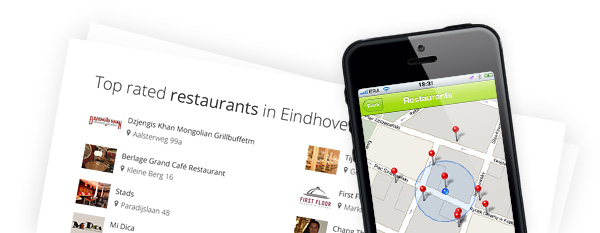
Interactive map
Open Bucharest map
Bucharest guide
All you need to know [ + – ]
1 Travel Tips The do's and don'ts 2 Travelling to Bucharest Getting to your destination 3 Getting around Explore like a local 4 Money Matters You know it's important 5 Language Don't break your tongue 6 Info about Bucharest & Romania History and geography
Photos of Bucharest
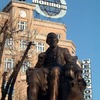
More photos »
Free iPhone app Download it while it's hot
Bucharest Printable Tourist Map
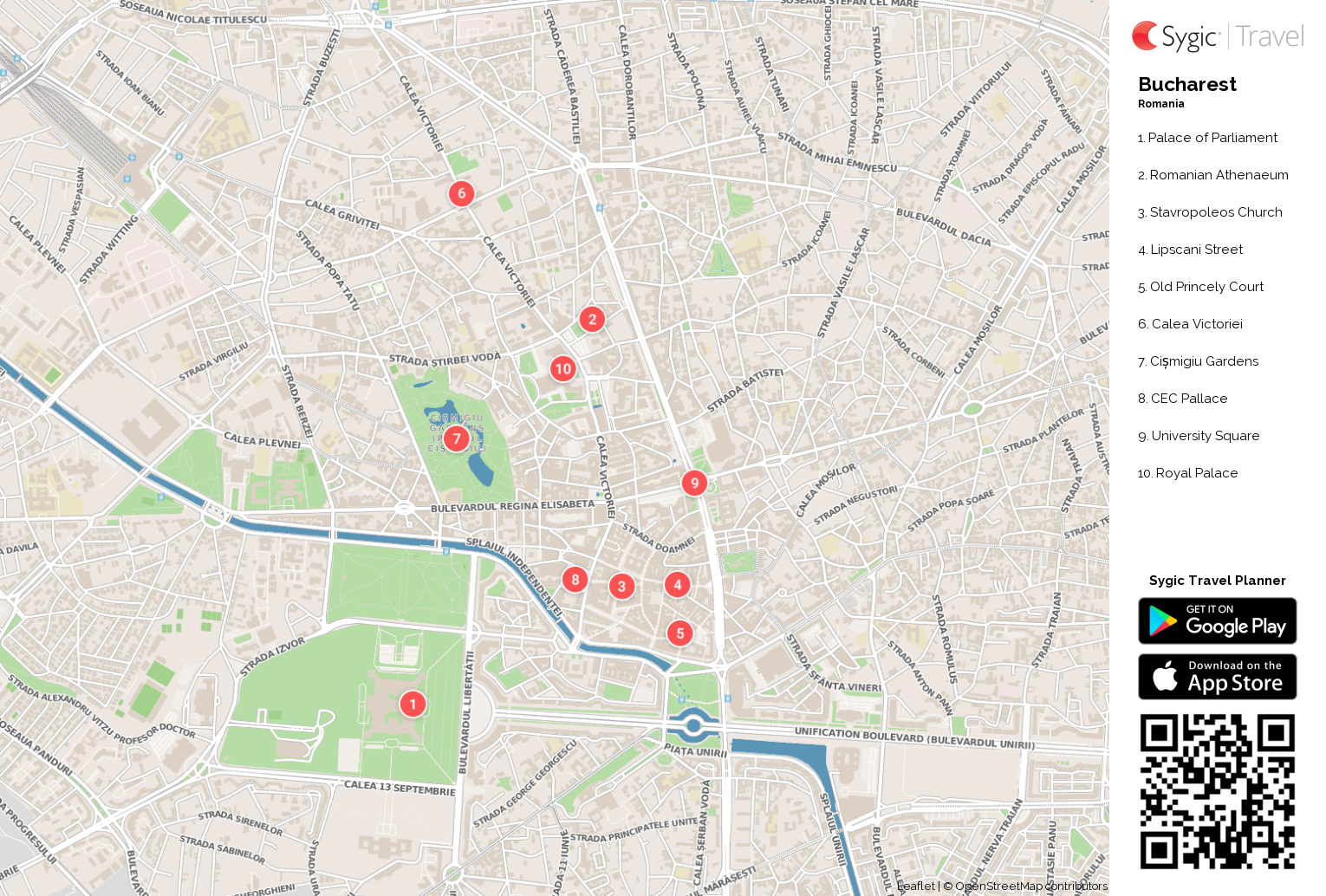
Bucharest Map: The Attractions
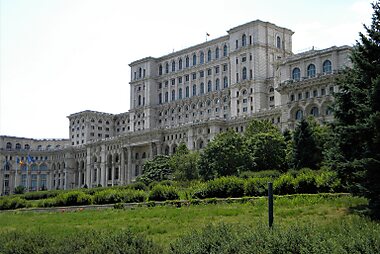
Palace of the Parliament
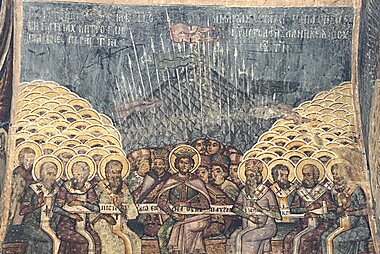
Stavropoleos Church
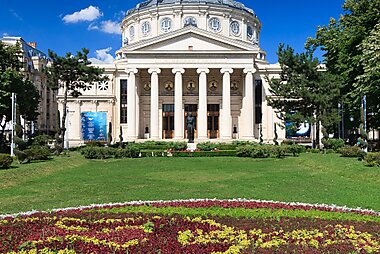
Romanian Athenaeum
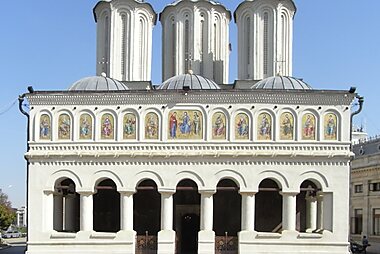
Romanian Patriarchal Cathedral
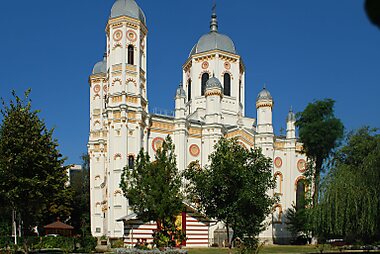
Saint Spyridon the New Church
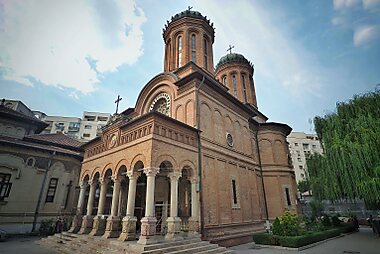
Antim Monastery
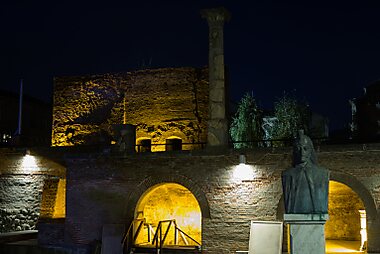
"The Old Court" - Princely Palace
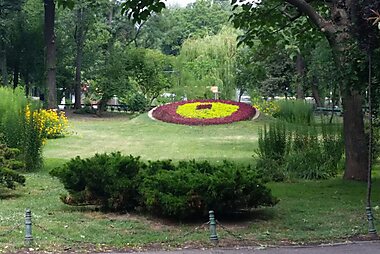
Cișmigiu Gardens
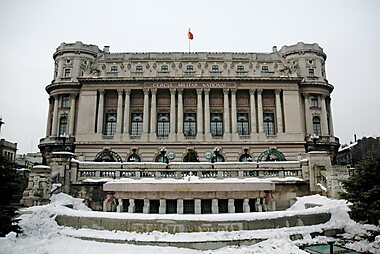
Palace of the National Military Circle
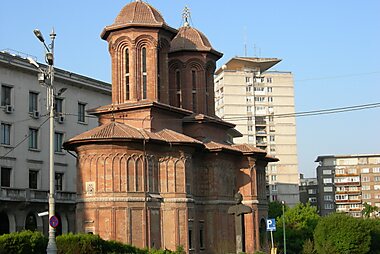
Kretzulescu Church
Sygic travel - a travel guide in your pocket.

More Tourist Maps
- Privacy Policy
- STOCK 360° TRAVEL VIDEOS
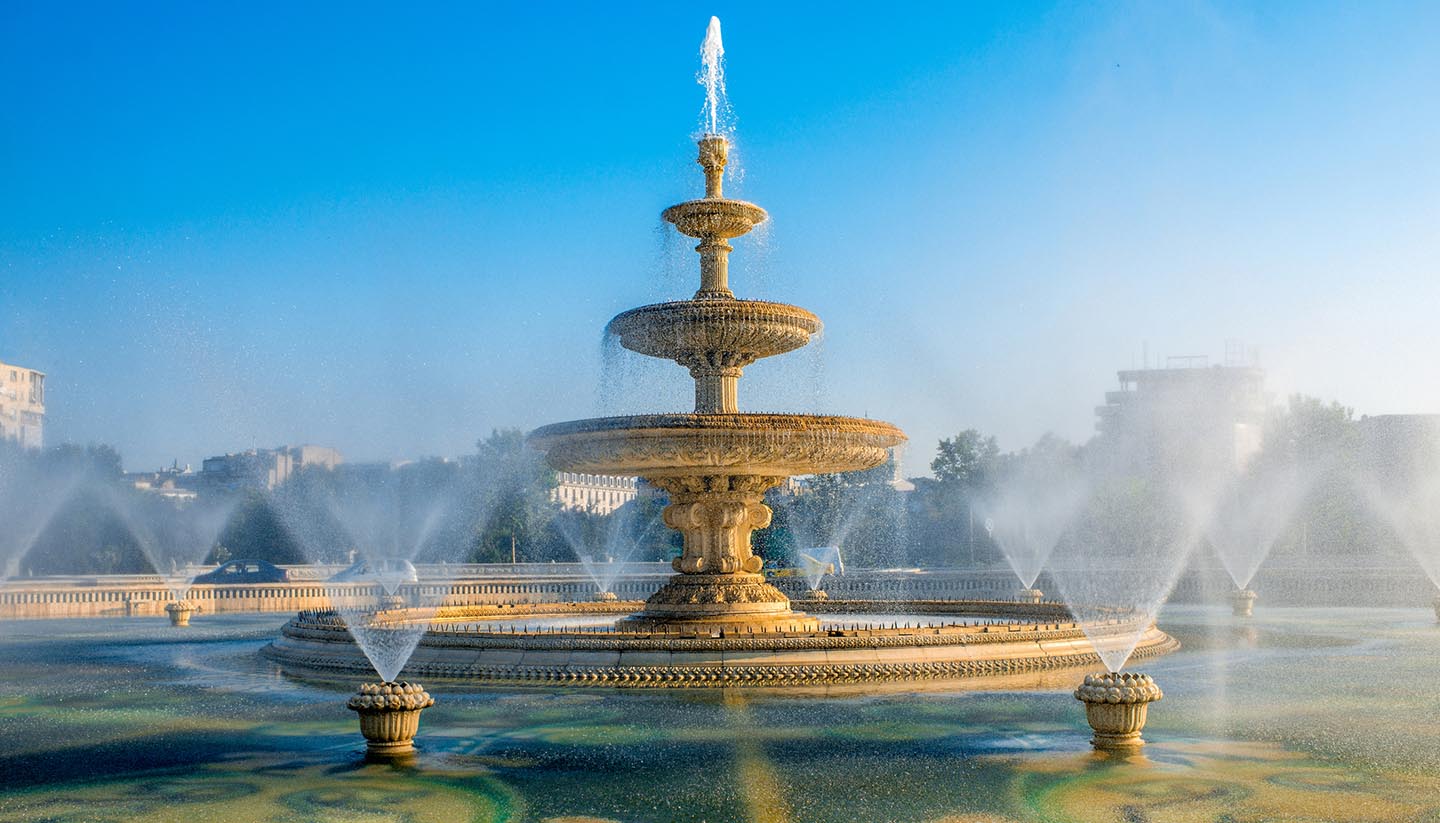
Local time Bucharest
Introducing Bucharest
About bucharest.
- Weather / Best time to visit
- Images of Bucharest
While you’re there
- Getting around
- Attractions, tours and tickets
- Things to see
- Things to do
- Restaurants
Plan your trip
- Travel to Bucharest
Romania Information
- About Romania
- Passport & visa
- Public Holidays
- Money & duty free
- Food & drink
Book your flights
- Bucharest Henri Coanda International Airport
Bucharest Travel Guide
At first glance a clashing blend of neoclassical buildings, wide tree-lined boulevards, and brutal post-Stalinist apartment blocks, Bucharest can be a confusing place, but is a city that rewards closer inspection.
Filled with grey communist housing estates that were often built around or sometimes on top of the finer bourgeois architectural details, it's difficult to conceive that this misunderstood city once inspired the nickname 'Little Paris'. But there are plenty of reminders of a glorious past, and also of a potentially glorious future.
The most symbolic building in Romanian culture, and the spiritual landmark of a nation, is the Atheneum. Built in the heart of the city in the 1880s, this magnificent concert hall has seen great politicians and scientists give lectures, had orchestras and musicians from around the world come to perform, and shown exhibitions of great paintings and sculpture by the masters of fine arts.
Dig a little deeper and you'll quickly find more survivors of the communist architectural desecration. There are Byzantine-style chapels and bell-towered mansions, while side streets in the historic centre hide antique shops, characterful bars, and eateries serving French, Italian and Transylvanian food.
Elsewhere in the centre are the 15th-century remains of the Old Princely Court, built by Vlad the Impaler. According to local folklore, it was the way he treated his enemies (and prisoners in the dungeons) that gave rise to the legends of Count Dracula.
More recent history can be appreciated in Piata Revolutiei, the square at the heart of the 1989 revolution that ended the reign of notorious dictator Nicolae Ceausescu and his wife. Contrasting with this in the ritzy north is sprawling Herastrau Park, which offers boat rides and an open-air museum displaying traditional Romanian homes.
Since Romania joined the EU, the sense of a new dynamism has spread all over town, with the younger population revitalising old buildings and bringing new life to the Romanian capital.

Related Articles
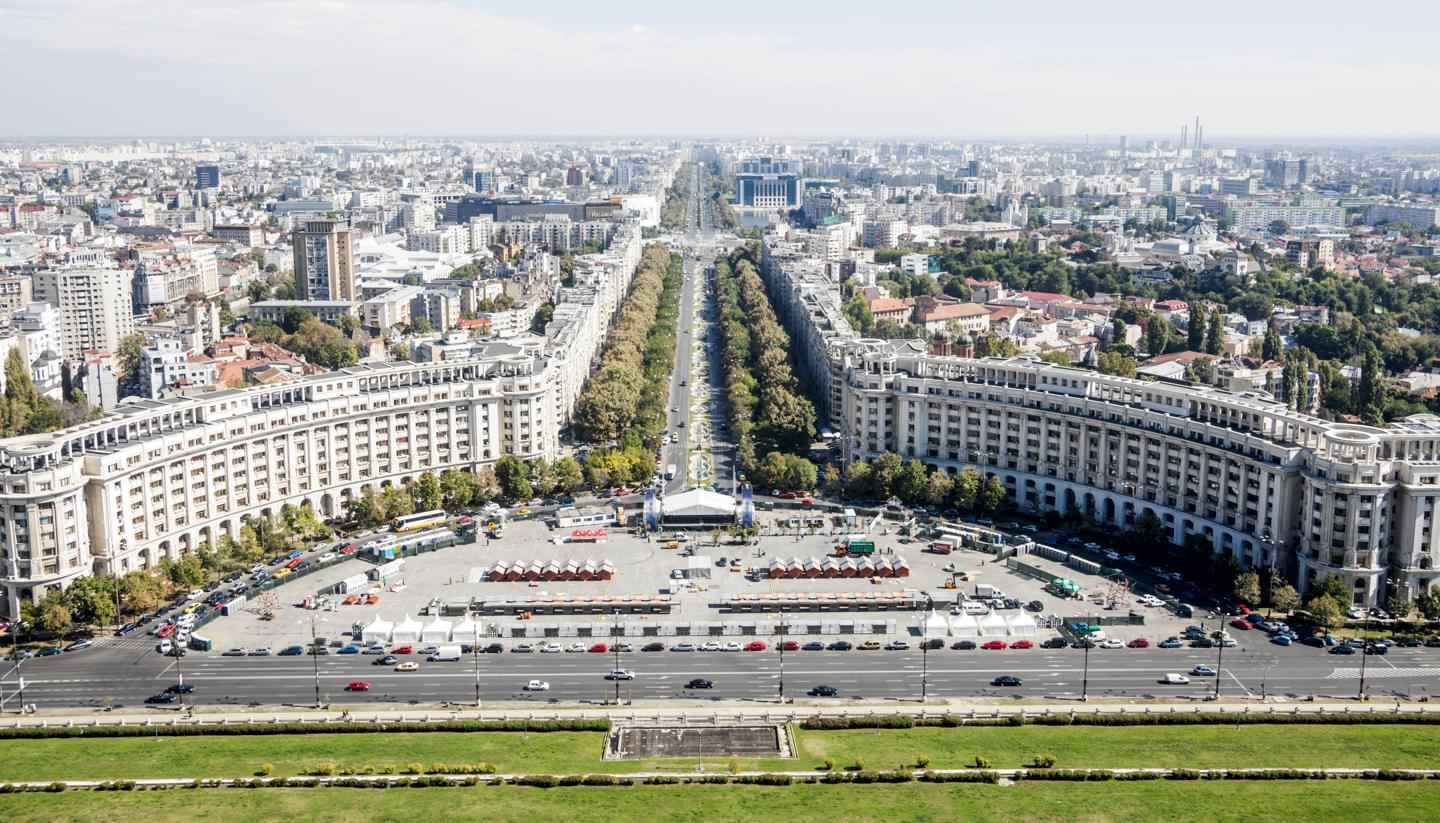
City Highlight: Bucharest
A vibrant collision of old traditions and growing reinvention, Bucharest is an ideal destination for your next city break
Book Accommodation
Featured hotels, hotel opera.
Centrally located hotel with a stylish atmosphere. The 33 rooms are rather small, but all en suite with air conditioning, hair dryer, satellite and cable TV, high-speed Internet access, mini-bar and coffee-making facilities. Good value for money.
Hotel Epoque
A deluxe boutique hotel a short walk from Cismigiu Park in central Bucharest, Hotel Epoque offers a variety of rooms and suites. The elegant exterior hides a modern interior design, and coupled with great service its design has led to the hotel being listed among the best in the country.
A hangout for poets before World War II, the 30-room Capsa plays up its 150-year history, with sparkling chandeliers and baroque furnishings. Rooms are elegant, with dark-wood walls, antique armoires, tall ceilings and all mod cons. Downstairs, a pastry shop sells traditional homemade sweets.
Rembrandt Hotel
This classy, intimate boutique hotel, tucked amongst some of the finest Paris-style buildings of the city centre, has 16 smart rooms with wood floors, high-speed internet, and wonderful views. Rates include breakfast in the mezzanine cafe.
Crazy Duck Hostel
A modern hostel suitable for travellers who want a clean but cheap place to rest the night. You can choose a private room that comes with cable TV and a private bathroom, or a dormitory unit that is clean and functional. It's about 12 minutes' walk from the Eroilor metro station but you can rent a bicycle at the reception.
A short walk from Piata Romana and the metro station of the same name, this 3-star hotel offers spacious and clean rooms, plus free Wi-Fi. The breakfast may not be well-received by some guests but Piata Romana is flanked by a wide range of cafes and restaurants.
© Columbus Travel Media Ltd. All rights reserved 2024
Academia.edu no longer supports Internet Explorer.
To browse Academia.edu and the wider internet faster and more securely, please take a few seconds to upgrade your browser .
Enter the email address you signed up with and we'll email you a reset link.
- We're Hiring!
- Help Center

Bucharest Tourist Guide (Ghid turistic București)

2015, MultiMedia Publishing
BOOK PREVIEW (PREVIZUALIZARE CARTE) Bilingual English/Romanian Guide (Ghid bilingv engleză/română) Bucharest offers some excellent attractions, and during the recent years has cultivated a sophisticated, trendy, and modern sensibility that many have come to expect from a European capital. Perhaps the most prominent landmark is the Palace of the Parliament, built in the 1980s during the reign of Communist dictator Nicolae Ceaușescu. The largest Parliament building in the world, the Palace houses the Romanian Parliament (the Chamber of Deputies and the Senate), as well as the National Museum of Contemporary Art. The building boasts one of the largest convention centres in the world. Culture in Bucharest, included within the whole Romanian culture, is a unique culture, which is the product of its geography and its distinct historical evolution. Romanians, (Proto-Romanians, including Aromanians, Megleno-Romanians, and Istro-Romanians) are the descendants of the ancient people indigenous to the Balkans, but have been Romanized. Bucharest has a growing cultural scene, in fields including the visual arts, performing arts and nightlife. Unlike other parts of Romania, such as the Black Sea coast or Transylvania, Bucharest's cultural scene has no defined style, and instead incorporates elements of Romanian and international culture. (București oferă câteva atracţii excelente, și în ultimii ani a cultivat o sensibilitate sofisticată, modernă și mondenă, pe care mulți se aşteaptă să o găsească la o capitală europeană. Poate cea mai importantă atracție este Palatul Parlamentului, construit în anii 1980 în timpul dictatorului comunist Nicolae Ceaușescu. Cea mai mare clădire din Europa și a doua ca mărime din lume, Palatul adăpostește Parlamentul României (Camera Deputaților și Senatul), precum și Muzeul Național de Artă Contemporană. Clădirea are una dintre cele mai mari centre de convenții din lume. Cultura în Bucureşti, inclusă în ansamblul culturii româneşti, este o cultură unică, produsul geografiei SHOP SHOP SALE și evoluției istorice a acesteia. Ea s-a definit ca punct de intersecţie a trei regiuni: Europa Centrală, Europa de Est și Balcani, dar nu poate fi efectiv inclusă în nici una dintre ele. Bucureştiul are o activitate cultural-artistică diversificată și în creștere, cu manifestări în diverse domenii, inclusiv artele vizuale, spectacole, și viața de noapte. Spre deosebire de alte zone din România, precum litoralul Mării Negre sau Transilvania, scena culturală din București este mult mai eclectică, fără un stil definit, incorporând diferite elemente ale culturii românești și internaționale.)
Related Papers
Editura Universităţii "Ştefan cel Mare"
Liviu Gheorghe POPESCU , Hrytscu Veronika
The reasons for a field trip in Romania and Ukraine? The field trip was organized after the 11th edition of the International Symposium on Environmental Quality and Land Use, Suceava, 2017, between 3 rd and 4th of June, on the territory of two neighboring countries, Romania and Ukraine. The field trip itinerary was the following: • The first day (June 3 rd, 2017): Suceava - Siret - Chernivtsi - Sniatyn - Kolomyia - Deleatin - Yaremche - Tatariv. • The second day (June 4th, 2017): Tatariv - Bukovel - Yablunytsia pass (Iabloniţa) - Yasinya - Rakhiv - Dilove - Solotvino (Slatina) - Tyachiv (Teacev) - Khust (Hust) - Vynohradiv (Vinogradov) Okli respectively Halmeu - Livada - Orașu Nou - Negrești Oaș - Certeze - Huta pass - Săpânța - Sighetu Marmației - Bârsana - Bogdan Vodă - Vişeu - Moisei - Borsa - the Prislop pass - Cârlibaba - Ciocăneşti - Mestecăniş pass - Pojorâta - Campulung Moldovenesc - Gura Humorului - Vama - Suceava. Why did we choose this route for the trip? There are many reasons and all ar equally important. Firstly, because the geographic space of Northern Romania and Southwestern Ukraine, especially the Carpathians, offer wonderful views, unforgettable places and a refreshing atmosphere created by hospitable people. Secondly, the two geographical areas coincide with a region where the wood art led to the creation of case, marvelous architectural jewels, from the simplest houses to the most beautiful churches that resisted over the ages on both sides of the Tisa River. Only on the Romanian side of Maramures there are almost one hundred wooden churches, eight of them being part of the UNESCO World Cultural Heritage. Additionaly, from a historical point of view, the area chosen for the field trip was part of the Austrian Empire for a century and a half. This was preserved over time in the beautiful historical centers of the main towns which are representative for two major historical regions - Bucovina and Maramures, both territorially divided between the two neighboring countries, Romania and Ukraine. Last but not least, because we consider that every Romanian must at least once visit Transcarpathia and Maramures in order to convince himself of the continuity of the cultural and moral values of the regions with an indentical history, located on both sides of Tisa river, and famous for preserving the rural heritage - customs, architecture, music and costumes.
RELATED TOPICS
- We're Hiring!
- Help Center
- Find new research papers in:
- Health Sciences
- Earth Sciences
- Cognitive Science
- Mathematics
- Computer Science
- Academia ©2024
Wander-Lush
20 Magical Things to Do in Bucharest in Winter
20 of the very best things to do in Bucharest, Romania, plus my tips for visiting Bucharest in winter.
In my 6-ish months travelling around the Balkans , I got to experience the region in every season – from the deepest, darkest depths of winter through to the first days of summer. Because of the way my route worked out, I happened to be in two of the region’s coldest countries – Bulgaria and Romania – for the coldest months of winter.
Let me tell you: Bucharest, Romania’s biggest city, is a pure winter wonderland in January! I spent a cosy fortnight in the capital before making my way up to Transylvania and enjoyed every bone-chilling minute.
In this guide, I’ll share my favourite weather-appropriate things to do in winter in Bucharest, from Romanian cuisine to cosy indoor activities and outdoor attractions that are worth braving the frost for.
Please note: This post contains affiliate links, meaning I may earn a commission if you make a purchase by clicking a link (at no extra cost to you). Learn more.

How cold does it get in Bucharest in winter?
Bucharest gets pretty darn chilly in winter, even by European standards. Compared to Transylvania and Romania’s mountainous areas, the weather in the capital is fairly mild.
Winter temperatures in Bucharest average 4 to -2 degrees Celsius in December, 3 to -4 degrees Celsius in January, and 7 to -2 degrees Celsius in February. The winter months are fairly dry, but heavy snowfall is common, especially in January and February.
Despite the chill, Bucharest still sees plenty of blue-sky winter days. (Watch out though, it’s often the clearest days that are the coldest!) Provided you dress appropriately and manage your time outdoors, Bucharest in winter can be very pleasant indeed.
20 magical things to do in Bucharest in winter
1. get to know bucharest’s bizarre downtown on a city tour.

I don’t care how cold it is – walking around Bucharest, the ultimate city of contrasts, is a must. The history here is impossible to escape: Everything is laid out in plain sight in the city planning and the crumbling facades. You can learn a lot about Romania’s recent past just by taking in the capital’s architecture.

If you think downtown Bucharest looks suspiciously modern for a city whose history spans 500 years, you’re not wrong. In the 1970s and 80s, Romania’s communist leader, Nicolae Ceaușescu, embarked on a massive ‘urban renewal’ project to completely transform Bucharest in his image.
Standing on any street corner today, it’s not hard to believe that Ceaușescu’s architectural inspiration came from a state visit to North Korea. The Communist Party’s systematic plan to cleanse the nation of its religion, history and culture and implement a more ‘organised’ system saw many of Bucharest’s most precious buildings and monuments destroyed. In their place, huge concrete blocks were erected to house the many thousands of families forcefully relocated to Bucharest from rural areas to work in the city’s new factories.
So devastating was Ceaușescu’s campaign, it’s now remembered by Bucharestians as the ‘Architectural Apocalypse’.
It’s easy to discount Bucharest as an ugly city. To get to the core of the history, you really need to take a walking tour of the downtown area and let a local bring the streets to life for you. In winter, when you want to limit the amount of time you spend outdoors, a walking tour is the most efficient use of your time.
Recommended walking tours:
- Best of Bucharest Private Walking Tour
- Ashes of Communism Private Walking Tour
- Hidden Gems Small Group Walking Tour
There is also a Walkabout Free Tour in Bucharest. I took part in the free tour on my first day in Romania and loved it. Groups are limited to 10 people for a more intimate experience. Online reservations are essential – enquire here .
2. Admire the architecture in Bucharest Old Town
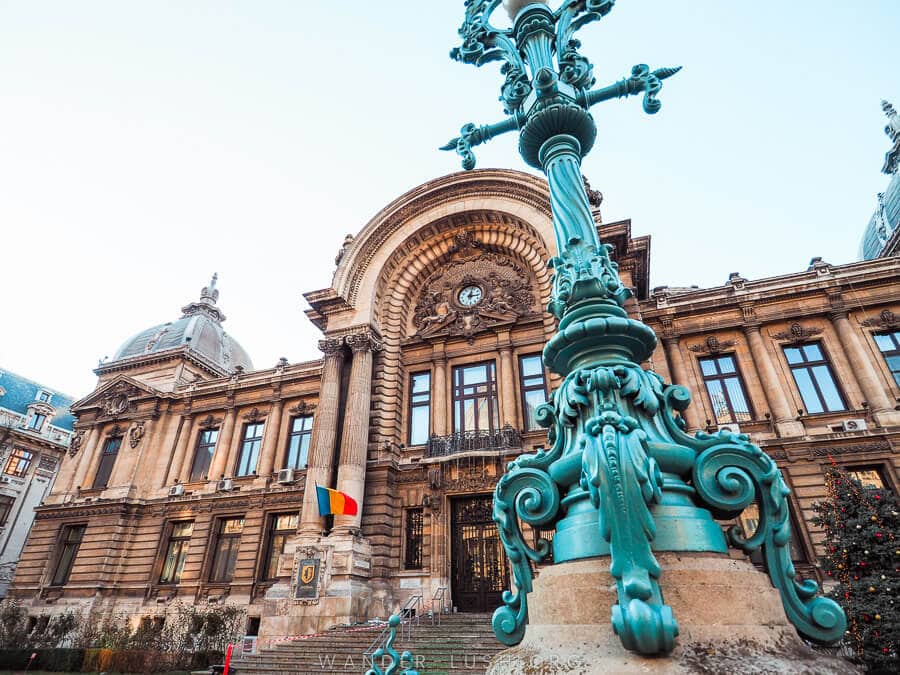
Around 25% of Old Bucharest was demolished at Ceaușescu’s hand, making the buildings that somehow dodged the bulldozer all the more precious.
Bucharest lost more than 50 of its churches to the urban renewal project. But thanks to some enterprising locals, a dozen consecrated buildings were saved by painstakingly uprooting and relocating them to different parts of the city.
This incredible story of defiance is one you have to hear from a local to believe.

Gems to look out for in the Old Town include:
- CEC Palace: A distinctive glass-and-metal domed building erected in 1900.
- National Bank of Romania: An impressive building flanked by Corinthian columns that was finished in 1885.
- Macca-Vilacrosse Passage: A gorgeous Parisian-style covered arcade with a glass atrium and decorative plasterwork.
- Pasajul Englez (English Passage) – another covered passageway. In the warmer months, this is where the famous ‘Bucharest umbrellas’ are found.
3. Wander the snow-covered grounds of Stavropoleos Monastery

Stavropoleos Monastery deserves a special mention as one of the most beautiful buildings in old Bucharest. It’s located right in the centre of the Old Town’s most lively precinct – but once you enter the church yard, you’ll be swept away into another world.

Built in 1724 and restored numerous times over the years, the complex has fulfilled various roles for the Romanian Orthodox Church, including as a nunnery and library.
In winter, ivy laced with ice crystals climbs the walls and drapes itself over engraved stones. Take refuge from the cold in the cloisters or inside the candle-lit chapel.
4. Explore Bucharest’s historic mahallas

The centre of Bucharest may have been all but destroyed, but the spirit of the old city lives on in its mahallas or outer neighbourhoods.
Today there are at least four distinct historic neighbourhoods to explore in Bucharest: the Butcher’s, Potter’s, Armenian and Jewish mahallas. These areas were not the product of a segregation policy nor were they considered enclaves, rather they were distinct communities within the city at large that grew up quite organically.
Before WWI, Bucharest was nicknamed ‘The Little Paris’ for its architectural style. Residents of these inner neighbourhoods wanted their city to look more European (a pushback against the Ottomans, who were ejected from Romania in the late 1880s) and so added ‘very continental’ decorative flourishes to their facades and interiors.
The mahallas are home to some of Bucharest’s oldest surviving buildings. The Theodor Pallady House, now an art museum, is thought to be the oldest private home in the city. It was built by an Armenian merchant in 1750.

Under communism, most private residences in Bucharest were seized by the state. After the revolution in 1989, conflicting laws over ownership meant that a lot of older properties got stuck in limbo. Unoccupied, they fell to ruin. Some have since been rehabilitated, but you’ll definitely see more crumbling facades than restored ones.
Negustori Street , the traditional trade street in the Jewish Quarter, and Diari Strata , the old pottery street, are among the highlights.
Separate to the architecture, the Jewish Quarter holds a number of attractions, including the Coral Temple and the Jewish Museum . The quiet winer streets take on a haunting character when you consider the history. Bucharest’s 800,000-strong Jewish community was devastated by WWII. Today, the community is barely 10% of what it was.
Cartierul Armenesc , the Armenian Quarter, features an Armenian Orthodox Church with a sign pointing the way to Yerevan and Mount Ararat out front. Take a break at the nearby Cofetaria Armand, a lovely little Armenian bakery.
5. Tour the Palace of Parliament

There are lots of superlatives associated with the Palace of Parliament: It’s the world’s heaviest building, and the most expensive administration building ever built. Despite that, a shocking 70% of the floorspace remains unused.
Ceaușescu ordered the construction in 1984. As you can imagine for a building with such a huge footprint, an entire district of Old Bucharest had to be cleared to make way for it. This resulted in the city’s most atmospheric neighbourhood, ‘the Montmartre of Bucharest’ as it was described to me, being levelled. Yet more houses and churches were pushed aside so that Ceaușescu could realise his dream of making Boulevard Unirii, the street that leads to the Palace, longer than the Champs Elyse.
It’s widely agreed that the Palace was completely unnecessary for a nation of Romania’s size. More than that, it was a slap in the face for the people of Romania suffering under the ruling Communist Party’s policies at the time.
Today, the Palace is a monument to Ceaușescu’s twisted dream. There are many quirks to discover as you tour the mammoth building – there’s no AC (he was paranoid about being poisoned), and you’ll notice there’s a chair missing from the main meeting hall. The leader never took his seat at the table or used the Palace at all: He was executed before it was finished.
The only way to get inside the Palace of Parliament is by joining an escorted tour. Tours are held throughout the day and last for around an hour. Advance reservations are essential – book skip-the-line tickets here.
6. Wander the empty halls of Ceauşescu’s former residence

Another building worth touring is the perfectly preserved Primaverii Palace, AKA Casa Ceaușescu. Walking through the deserted rooms and empty halls of the leader’s former family home – his last place of residence before the revolution – is eerie to say the least.
When they fled Bucharest, the family left behind most of their personal possessions (they left in a hurry). Mrs. Ceaușescu’s furs still hang limply in the closets, and framed family photographs sit lifeless by the bedsides.
The estate itself is palatial: Bohemian crystal for the table settings, Venetian glass for the fountains, Persian silk for the carpets (a gift from the Ayatollah himself). You can visit the private cinema room where Ceaușescu watched her favourite show, Dallas , while the rest of Bucharest was limited to two hours of state-run television per day.

Out back, there’s an indoor pool covered with mosaics a la Stalin’s bathhouse in Tskaltubo .
Similar to the Palace of Parliament, the only way to visit the house is on an escorted tour. Reservations must be made at least 24 hours in advance via the official website.
7. Experience the flipside at Ferestroika

There’s only so much you can learn from a museum display (not that Bucharest has any museums dedicated to the country’s communist past anyway). The Feresroika Experience, the brainchild of three local academics, aims to show tourists and young Bucharestians alike what life was like for everyday Romanians under Ceaușescu’s thumb. And it takes a very personal approach.
Located in a typical Bucharest apartment building, Ferestroika is a living museum that showcases a day in the life of a middle-class military family. The home belonged to one of the founder’s grandparents – his mother actually grew up here.

Everything appears just as it would have in the 1970s, right down to the scant kitchen rations and the toilet paper made from pulped bibles. As you make your way through each room, detailed descriptive plaques reveal a wealth of information, while the guides add more detail through personal anecdotes. You can touch, taste and smell what life was like at the time.
One thing that stays with me: The family’s radio, their only connection to the outside world, was kept inside the kitchen pantry. Why? It was the only place they felt safe to tune into Radio Free Europe. If a neighbour heard you listening to something so subversive, they would report you to authorities.
Advance reservations are required to visit Ferestroika. Inquire via the website.
8. Throw back some hearty Romanian cuisine

On a much lighter note – food!
There’s no two ways about it: Romanian food is made for winter. Hearty, heartwarming (and so rich, it’s almost heart-stopping), just about every national delicacy is heavy and tasty and goes down very very well on a chilly winter day.
My favourite Romanian dishes are sarmale (stuffed cabbage rolls) and mici (grilled meat patties similar to cevapi ). Mămăligă , soft and buttery polenta, is a popular accompaniment. Frankly nothing fills a growling winter belly better!
Just save room for dessert… Which is so special, it deserves it’s own spot on this list.
My favourite Bucharest restaurants are:
- La Mama: Simple homestyle fare in the centre of the Old Town. Prices are a touch high, but the location is convenient.
- Caru’ cu bere: An atmospheric beer hall serving classic Romanian and German-inspired dishes (more on Caru’ cu bere later).
- Hanu’ lui Manuc: Traditional Romanian served inside a historic caravanserai.
A wise friend of mine recommended eating a few international meals in Bucharest because it’s very difficult to get non-Romanian food outside of the capital. If you’re heading to Transylvania next and you want to mix it up a bit while you still can, these are my top picks:
- Simbio: Cafe-style meals, burgers and smoothies halfway between the Jewish and Armenian districts.
- Dianei 4: Amazing breakfasts and light meals in a beautiful old house in the Armenian Quarter.
- Gyros Thessalonikis: Thessaloniki -style gyros. Need I say more?
- Dristor Kebap: Legendary Turkish-style kebabs – a Bucharest institution. Ideal for a fast, cheap meal. They have several branches throughout the city.
9. Indulge in papanasi , the ultimate winter treat

If you haven’t heard of papanași , allow me to illuminate you. This Romanian dessert consists of fluffy, cheesy donuts deep-fried to perfection and topped with lashings of jam (cherry or wild berry are both traditional) and sour cream. Sounds simple, but the contrast of textures and temperatures – and the timeless combination of sour cherry, silky cream and sweet, slightly umami donut – is nothing short of mind-blowing.
I ate my first plate of papanasi on my very first day in Bucharest. Like total rookies, my husband and I decided to split a single serving of two donuts between us – wrong! This is not a dish that’s made to be shared!
After that first meeting, I ate papanasi at least every other day during our one-month stay in Romania. (I really struggled to pick my favourite papanasi photo for this post since I have around a dozen to choose from!)
The dessert is ubiquitous on restaurant and cafe menus throughout Bucharest and in the rest of the country, so you won’t have any trouble feeding the beast should you accidentally develop a raging cheese donut addiction like I did.
10. Cosy up with a beer at Caru’ cu Bere, Bucharest’s most beautiful restaurant

Caru’ cu Bere, ‘The Beer Wagon’, is a Bucharest culinary institution. Its history dates all the way back to 1879 when it began life as a brewery. It certainly has a German beerhall feel about it
The lavish Neo-Gothic interior with dark wood paneling, stained glass, original floor tiles and a stunning wrap-around bar was finished in 1899 and refurbished in the early 2000s. Waiters don’t at all mind if you climb the stairs and walk the balconies to get the perfect photo.
We ended up eating here twice – on our first visit, we had a German-style tasting plate. We came back again just for the papanasi!
11. Shop at Carturesti Carusel, Bucharest’s most famous bookstore

Made famous on Instagram, Cărturești Carusel is even more stunning in person than it is in photos – especially in low season when you don’t have hoards of other ‘Grammers to contend with.
The building started life as a bank and unbelievably, lay abandoned and in disrepair for several decades up until 2015 when restorations began.
The plaster detailing on the columns, the pure-white balconies and the spiral staircases and fluid lines of the lower balcony make Carturesti Carusel truly one of the most beautiful bookshops in the world.
12. Browse the lively Piata Obor for winter produce

Piata Obor, Bucharest’s main produce market, is a joy to explore at any time of year. In winter, the aisles are packed with apples, pears and other winter produce.
Huge windows let the winter sun flood the main market building, giving the whole place a warm glow. Outside, simple restaurants and bars serve up paper plates stacked with hot mici to groups of friends gathered around picnic tables sipping mulled wine and pálinka liquor.
Learn more about visiting Piata Obor here.
13. Take a twilight stroll through the twinkling Cismigiu Gardens

Remember when I said that some Bucharest landmarks look extra special in winter? Well Cișmigiu Gardens is one of them.
This huge English-style garden in the centre of the city is the oldest and largest public park. Rotondas, pretty bridges, promenades and two lakes are enclosed within the grounds.

In winter, an artificial ice skating rink is added to one part of the largest lake.
There’s nothing better than strolling through the snowy grounds on a winter’s eve, guided by the lamp posts that emerge from the crystal-covered foliage.
14. Embrace Bucharest’s third-wave coffee culture

Coffee is certainly the warm beverage of choice in Bucharest. As I learned on my mahallas tour, Armenian merchants brought beans to Bucharest 200 years before coffee landed in Vienna – making the cafe scene here one of the oldest in Europe.
There are dozens of third-wave cafes in Bucharest for eager sippers, most of them located beyond the Old Town core. My personal favourite is Dianei 4 in the Armenian Quarter. Located inside a historic building with flaking wallpaper and wonky chandeliers, it’s absolutely gorgeous and epitomises Bucharest’s old timey character. The dining room vibe and cosy fireplace are perfect for winter.
Bandit Specialty Coffee , Orgio and BOB Coffee Lab are other popular cafes in Bucharest. Prefer tea? Ceainaria Bohemia Tea House has you sorted.
15. Discover the underrated street art scene
Bucharest is full of surprises. The city’s street art scene, like it’s cafe culture, is burgeoning and offers an insight into the mindset of contemporary Bucharest.
There are now more than 50 impressive large-scale murals scattered throughout the city. Use this guide to track down some of the best works, or better still, join a street art tour offered by Urban Adventures and Lonely Planet to learn the stories behind the murals.
16. Visit the Bucharest Christmas markets

Being a predominantly Christian country, Romania celebrates Christmas, or Crăciunul, with much fanfare. Christmas is marked on December 25 on the Romanian calendar, with a number of different markets and light displays held across the city in the lead-up to the big day.
The official Bucharest Christmas Market at Universitatii Square runs from November and is the largest of the city’s fairs. Traditional Romanian handicrafts are sold alongside winter food and drinks.
Also worth seeing is the Christmas light display on Magheru Boulevard.
17. Get acquainted with Romanian wine
What better way to while away a winter’s night than with a wine degustation. Romania is the world’s 13th-largest wine producer and although still relatively low-profile , vineyards such as Dealu Mare are fast making a name for themselves on the European wine scene .
A wine tasting at Bucharest’s first wine bar includes four glasses of local vino accompanied by traditional Romanian cheeses. Delish!
Keen winos can go a step further and tour the country’s finest wineries on a day trip from Bucharest to Dealu Mare .
18. Treat yourself to a night at the opera

Get rugged up in your finest winter coat for a night on the town Bucharest style! The city has two concert halls: the Romanian Athenaeum and the Romanian National Opera. Both host theatre, concert and opera performances year-round. Check times for the opera house here .
Even if there’s nothing on during your visit to the city, I still recommend popping inside the Romanian Athenaeum to view the interior. It’s one of the most distinguished buildings in the entire city.
19. Warm up at Therme Bucharest
I’m not exaggerating when I say that my day at Therme Bucharest was one of my most memorable travel experiences to date. After two weeks of roaming the chilly streets of Bucharest, it was exactly what I needed to warm my bones.
Romania’s biggest wellness retreat, Therme is a massive modern complex of baths, saunas and therapeutic treatment rooms. Oh, and there’s a huge waterpark too! Locals flock here year-round to soak in the thermal pools, but it’s a particularly desirable destination in winter.
Therme is divided into three zones. The piece de resistance is The Palm, with its adults-only outdoor bath where you can loll in a steamy pool under a cold winter sky. The experience is similar to the thermal baths in Budapest .
Therme is easy to reach via a free shuttle from the city centre. This detailed guide tells you everything you need to know before you visit.
My top tip is to arrive as early as possible, as it tends to get very busy around mid-morning. Head to The Palm first (grab a drink at the underwater bar while you’re there), then make a beeline for the waterpark before you have to cue for the slides.
Don’t forget to pack a wet bag to bring your swimmers home in.
20. See Transylvania on a day trip from Bucharest

Think Bucharest looks beautiful in winter? Just wait until you get out of the city.
Transylvania has all the makings of a real-life fairytale, and the landscape is roughly ten-thousand times more ethereal in winter. The region’s fortified churches, the Saxon cities of Sighisoara and Sibiu, and the splendid medieval castles are next-level enchanting when they’re cloaked in snow.
While I strongly recommend extending your stay in Romania to make time to travel around Transylvania by train or car, if you’re short on time, you can still see a slice of the region on a day trip from Bucharest. Peles and Bran Castles and the beautiful Romanian city of Brasov can all be visited within a day.
Best Bucharest day trips:
Where to stay in Bucharest in winter
If you’re visiting Bucharest in winter, it makes sense to stay somewhere central so that you can get around easily and limit your time outdoors travelling from place to place. My favourite neighbourhoods to stay in Bucharest are the Old Town and the Jewish Quarter.
Apartment: Bucharest has some excellent apartment offerings that are very well-priced, so I recommend starting your search using the apartment filter on Booking.com. We stayed for two weeks at this gorgeous apartment in the old Jewish Neighbourhood. The area is atmospheric, and the apartment is stylish and cosy, and a full kitchen makes it perfect for self-catering. Check rates and availability here on Booking.com .
Mid-range: Central Guesthouse offers no-frills single and double rooms that are comfortably furnished. The hotel has a great location in Sector 3 near the Old Town. Check rates and availability here on Booking.com.
Boutique: Filitti Boutique Hotel is conveniently located in the heart of the city, 200m from Stavropoleos Church. Rooms are stylishly decorated, and the property has a sky bar. Check rates and availability here on Booking.com.
Budget: Podstel Bucharest is a solid choice for budget travellers. Both mixed dorms and private doubles are on offer, the common areas are lovely (even if it’s too cold to enjoy the outdoor terrace), and the location in Sector 4 at the southern edge of the Old Town is great for restaurants and bars. Check rates and availability here on Booking.com.
Tips for visiting Bucharest in winter
- Remember that during winter, the days are much shorter days – factor this in when you’re planning your Bucharest itinerary.
- There are so many beautiful buildings in Bucharest, if you’re anything like me, you’ll be constantly clicking. Keep your spare camera batteries in your pocket otherwise you’ll find the cold weather drains them very quickly.
- To make it easier to get around the city in winter, I recommend downloading a taxi app. Uber and Taxify both operate in Bucharest.
Dressing for winter in Bucharest
As you can probably tell from my photos of Bucharest in January, it gets pretty darn chilly! Since so many of the best things to do in Bucharest are outdoors, you definitely need to dress for the weather if you want to experience everything the city has to offer.
I highly recommend wearing an insulated down jacket like this one . Thermal leggings and an undershirt like these are also required, along with thick socks, gloves, a hat and scarf.
Sensible footwear is critical! I wore thin sneakers in Bucharest, even in the snow, and always had cold and wet feet. Huge mistake! Boots like these with a good grip and fleece lining are ideal for staying warm and slip-free on the slick cobbled streets of Bucharest’s Old Town.
Remember to pack something fancy if you plan on spending a night out at the opera or on the town. I always travel with my lightweight Kosan Travel Dress for exactly this reason.
Romania essentials
Here are my favourite resources to help you organise your trip to Romania.
FLIGHTS: Find affordable flights to Romania on Skyscanner .
VISAS: Use iVisa to check if you need a tourist visa for Romania and apply for an expedited visa online.
TRAVEL INSURANCE: Cover your trip with HeyMondo , my preferred provider for single-trip and annual travel insurance.
SIM CARD: Buy an eSIM and data package for Romania online before you go. My top choice is the Eurolink eSIM from Airalo (10 GB for 30 days).
CAR HIRE: Use Discover Cars to find the best price on a rental car in Romania.
ACCOMMODATION: Find the best hotel deals in Romania on Booking.com .
DAY TRIPS & CITY TOURS: Use Get Your Guide or Viator to find the best Bucharest city tours and day excursions around Romania.
More Eastern Balkans travel inspiration
- Beautiful cities to visit in Romania
- Unique things to do in Transylvania
- Guide to visiting Sighisoara
- Bulgaria in winter
- Balkans road trip planner
- Bulgaria itinerary
- Balkans travel guide

Bucharest in Winter: Save it for later
Although we didn’t have the Christmas markets this season (2020), we had a lot of snow up in the mountains, so we were able to thoroughly enjoy the winter charm in the Carpathians.
Very glad to hear that! Thanks for you comment!
Leave a Reply Cancel reply
Your email address will not be published. Required fields are marked *
- Subscribe to future posts
Bucharest Travel Guide
Bucharest travel guides, 25 cheapest cities to visit in europe.
- Privacy Policy
- Terms and Conditions
- GET INSPIRED AND START PLANNING GET INSPIRED AND START PLANNING
- footer@item_discovertips_anchor
- PDF Travel Guides
- TOURISM INDUSTRY TOURISM INDUSTRY
- Art Galleries
- Memorial Houses
- Historical Buildings
- Hidden Gems
- Coffee & Shops
- Restaurants
- Night clubs
- About Bucharest
- Public Transport
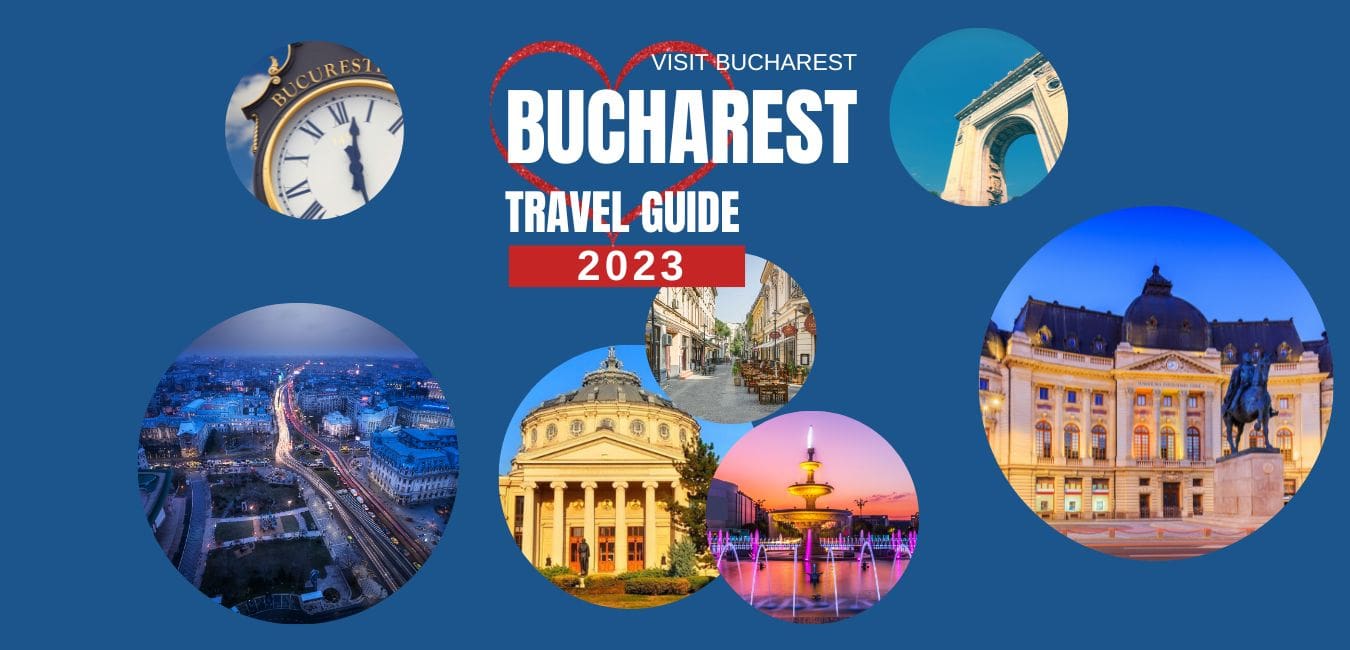
Visit Bucharest Launches Bucharest Travel Guide 2023
Visit Bucharest , the only travel platform promoting Bucharest to international travellers, launched Bucharest Travel Guide 2023 . This is the most expected online guide of Romania’s Capital, designed to help tourists discover Bucharest as a local.
We have tried to compile various information offered in our platform in the most comprehensive guide of our beautiful city. Bucharest Travel Guide 2023 is the guide to access when in Bucharest. It offers tourists information on transport, accommodation, best restaurants and top attractions. Also, it offers inside guidance into Bucharest’s hidden gems and attractions. Hopefully, this will be accessed and appreciated by tourists worldwide interested in visiting our Capital City.
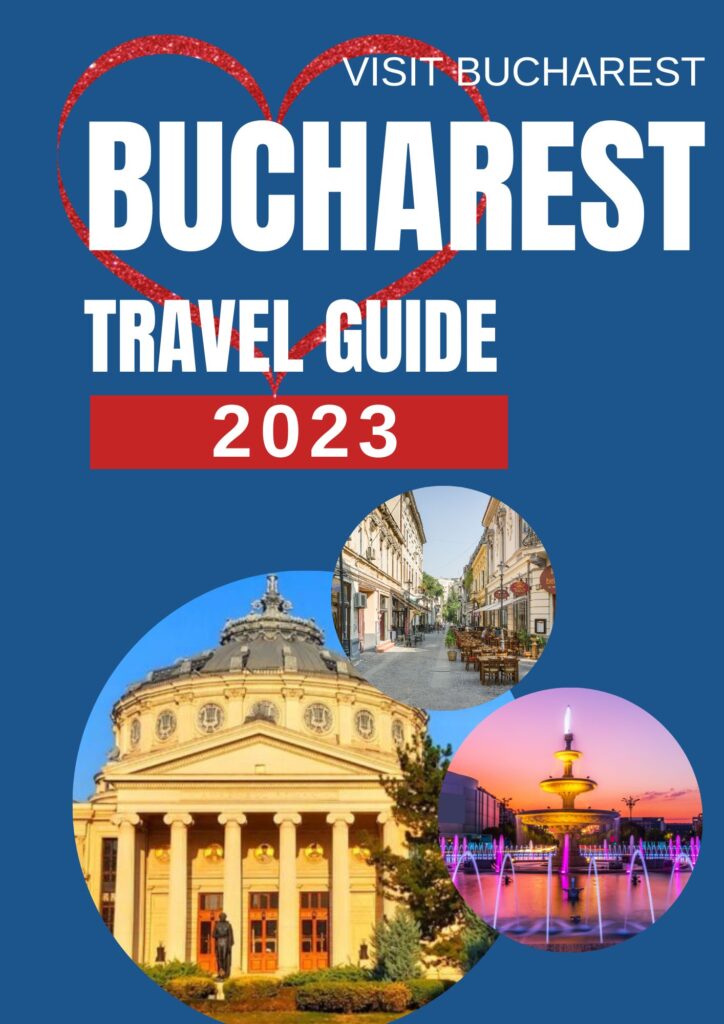
Bucharest Travel Guide 2023 is structured into compelling chapters to offer comprehensive travel guidance to all those already in Romania’s Capital and those planning to visit Bucharest.
The guide answers questions like:
- What is the best time of the year to visit Bucharest?
- What are the top attractions in Bucharest?
- What are the most recommended Bucharest Museums?
- Which hidden gems can I discover in Bucharest?
- What day trips from Bucharest are recommended for me to explore the surroundings?
- What are the most exciting festivals and concerts in Bucharest?
It also offers tips to international travellers, such as to enjoy the city at its best.
Plenty of exciting information and vivid pictures from Romania’s Capital make Bucharest Travel Guide 2023 the best companion for those who travel to Bucharest.
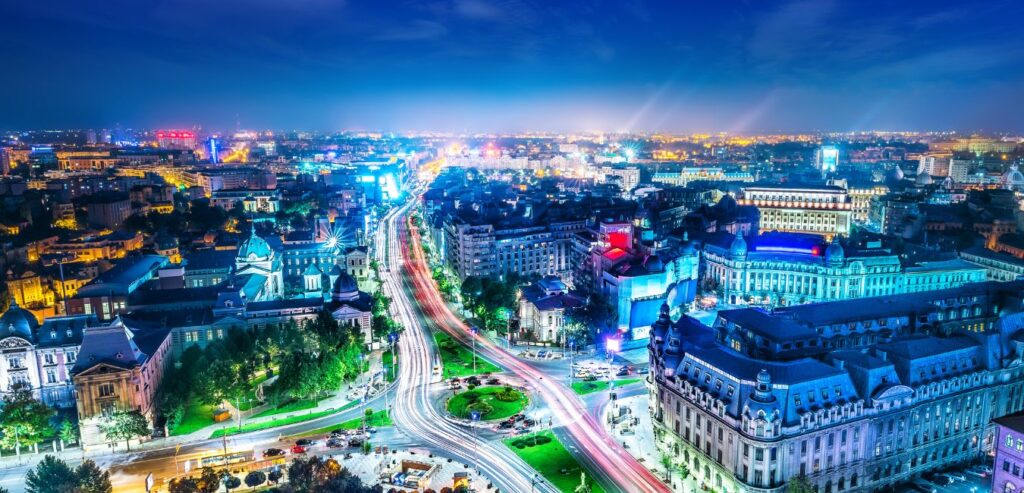
The number of international tourists visiting Bucharest had increased since last year when around 600,000 foreigners visited the city. Estimations show that in 2023 there will be more than 1 million foreign travellers in Bucharest. Yet, this number is way less than the record in 2019, when 1.9 million international travellers visited Romania’s Capital.

City guides like Bucharest Travel Guide 2023 offer the destinations online showcases to present their touristic objectives and to attract visitors worldwide.
About Visit Bucharest
Visit Bucharest is the only travel platform promoting Bucharest to English-speaking audiences worldwide. Since its launch, Visit Bucharest has reached more than a million tourists worldwide through its web platform, the dedicated Android App and social media accounts.

- Attractions
- Bucharest Tours & Trips
[email protected]
© 202 4 All rights reserved.
Webdesigned and promoted by TUYA Digital
Privacy Policy Customer Protection
Privacy Overview

IMAGES
VIDEO
COMMENTS
2. Explore Old Town (Lipscani) Old Town, also known as Lipscani, is the historic center of Bucharest, and it's a maze of narrow streets, colorful buildings, and lively bars and restaurants. This is the perfect place to go for a stroll, people-watch, and soak up the atmosphere.
Bucharest The guide was updated: 2024-02-12. Bucharest is Europe's best kept secret. While visually it can't quite compete with other grand Eastern European capitals, it leads the pack in dynamism, energy and forward momentum. The remnants of Communism are still palpable in the urban fabric, but the city has its sights set firmly on the future.
Welcome to Bucharest, where the rich tapestry of history intertwines seamlessly with vibrant contemporary life. As a proud local, I am thrilled to guide you through the heart of Romania's capital, offering insights that go beyond the usual tourist trails. In this Bucharest Travel Guide, we embark on a journey that encapsulates the essence of the city, revealing hidden gems, cherished ...
Bucharest. Romania, Europe. Romania's capital sometimes gets a bad rap, but in fact it's dynamic, energetic and lots of fun. Many travellers give the city just a night or two before heading off to Transylvania, but that's not enough time. Allow at least a few days to take in the very good museums, stroll the parks and hang out at trendy ...
Download your free PDF. 101 attractions. 18 restaurants. 260 hotels. Free download. Create your own Bucharest travel guide! All you have to do is select the type of places you'd like to include (restaurants, museums, etc.). When you're done, you can download your Bucharest travel guide to your phone or tablet, or print it as a PDF. Happy travels!
19. Visit the beautiful Carturesti Carusel library. 20. Visit one of the oldest restaurants in the country: Caru' cu Bere. What to visit in Bucharest: tourist attractions, museums, and more. 21. Palace of the Parliament: Bucharest's top tourist attraction.
Address: Palatul Parlamentului, Strada Izvor 2-4, Bucharest Opening hours: You can book a tour with a tourist agency or call to book directly between 9am and 4pm a day before Phone: +40 733 558 102 Email: [email protected] More Info: You need to book a tour in advance. The tour takes about 1 1.5 hours Triumphal Arch Similar to its Paris
Rough Guides® is a trademark owned by Apa Group with its headquarters at 7 Bell Yard London WC2A 2JR, United Kingdom. Plan your visit to Bucharest, Romania: find out where to go and what to do in Bucharest with Rough Guides. Read about itineraries, activities, places to stay and travel essentials and get inspiration from the blog in the best ...
This PDF download is free of charge. All we ask of you - if you are not currently logged into a social network - is an email address. We will use this to give you some great reasons to visit the cities covered by the In Your Pocket series. You can unsubscribe at any time by clicking the unsubscribe link in the email.
Bucharest guide and maps to restaurants pubs bars hotels events and sights in the capital of Romania Bucharest. Experience Bucharest with In Your Pocket shows you what to do in Bucharest ... Travel. Shop. More. Palatul Primaverii. Museums. Cotroceni Museum. Museums. National Map Museum. Museums. Stavropoleos Church. Historic Churches ...
Bucharest offers some excellent attractions, and during the recent years has cultivated a sophisticated, trendy, and modern sensibility that many have come to expect from a European capital. Perhaps the most prominent landmark is the Palace of the Parliament, built in the 1980s during the reign of Communist dictator Nicolae Ceaușescu.
🌟 Update: You can now take our travel guides offline! Check out our PDF shop. Bucharest, Romania's capital city of more than 2 million people, is a city of contrasts where one minute, you are walking around Neoclassical and Art Nouveau buildings, and another, you might find yourself surrounded by the gray concrete of Brutalist buildings ...
Download your free PDF . 99 attractions . ... Create your own Bucharest travel guide! All you have to do is select the type of places you'd like to include (restaurants, museums, etc.). When you're done, you can download your Bucharest travel guide to your phone or tablet, or print it as a PDF. Happy travels!
Bucharest Guide written by locals for travellers - includes insider tips, restaurant and pub reviews ... Download a free eBook/PDF ... 1 Travel Tips The do's and don'ts 2 Travelling to Bucharest Getting to your destination 3 Getting around Explore like a local 4 Money Matters You know it's important 5 Language Don't break your tongue 6 Info ...
See the best attraction in Bucharest Printable Tourist Map. Deutschland United States España France Italia Nederland Polska Brasil Россия 中国 Bucharest Printable Tourist Map. Print the full size map. Download the full size map. Create your own map ... Sygic Travel - A Travel Guide in Your Pocket
FROM A LOCAL GUIDE - WHAT NOT TO MISS IN BUCHAREST Pubs in the Old City of Bucharest. House of people in Bucharest or the heaviest building on Earth? The Lord "Dracula" castle ruins in Bucharest. Village Museum in Bucharest. Bucharest parks and gardens. Bucharest top travel attractions "WE HOPE YOU WILL FEEL GOOD IN BUCHAREST AND THANK ...
Bucharest Travel Guide About Bucharest. At first glance a clashing blend of neoclassical buildings, wide tree-lined boulevards, and brutal post-Stalinist apartment blocks, Bucharest can be a confusing place, but is a city that rewards closer inspection. ... The World Travel Guide (WTG) is the flagship digital consumer brand within the Columbus ...
Bucharest was first mentioned in documents in 1459. It became the capital of Romania in 1862 and is the centre of Romanian media, culture and art. Its architecture is a mix of historical (neo-classical), interbellum (Bauhaus and art deco), communist-era and modern.
1. Get to know Bucharest's bizarre downtown on a city tour. Downtown Bucharest in winter. I don't care how cold it is - walking around Bucharest, the ultimate city of contrasts, is a must. The history here is impossible to escape: Everything is laid out in plain sight in the city planning and the crumbling facades.
Download your free PDF. 99 attractions. 17 restaurants. 260 hotels. Free download. Create your own Bucharest travel guide! All you have to do is select the type of places you'd like to include (restaurants, museums, etc.). When you're done, you can download your Bucharest travel guide to your phone or tablet, or print it as a PDF.
BUCHAREST TRAVEL GUIDE . Symbolic edifice of the national culture, the Romanian Atheneum, built in the heart of Bucharest 120 years ago (1886-1888), has become the architectural and spiritual landmark of a whole nation, not just of a Capital city. It was here that both established and young ...
Romania is a deceptively large country, with physical barriers (such as high moun-tain passes) that make it difficult to get around easily. This tour highlights the most popular province, Transylvania, but adds neighbouring regions, including capital Bucharest, to make the most of your time.
Visit Bucharest, the only travel platform promoting Bucharest to international travellers, launched Bucharest Travel Guide 2023.This is the most expected online guide of Romania's Capital, designed to help tourists discover Bucharest as a local. We have tried to compile various information offered in our platform in the most comprehensive guide of our beautiful city.
ops.fhwa.dot.gov